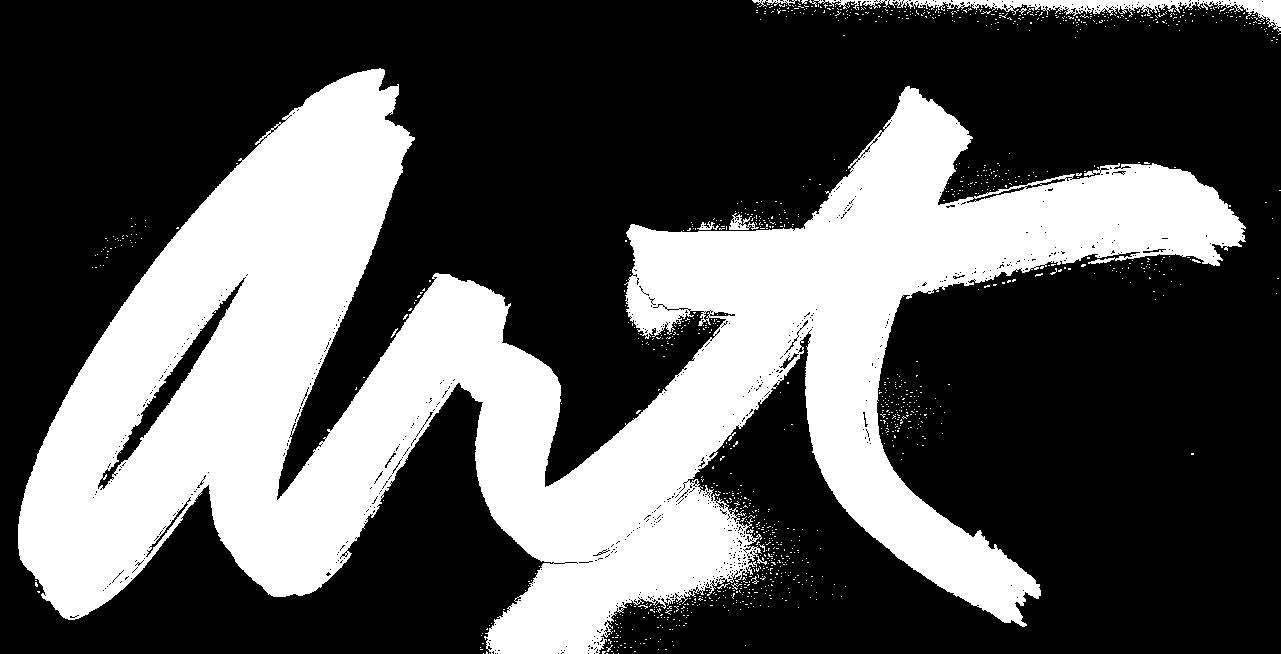

MARCH/APRIL 2024
$6.95 US
$8.95 CANADA
METAPHYSICS OF ART MASSART ’ S 150TH THE CURRENT ’ S: IN THE GARDEN MICHELE JOHNSEN New
CONTEMPORARY ART AND CULTURE
England
Emerging Artists Issue

FEBRUARY 22–MARCH 23, 2024
OPENING RECEPTION: Thursday, February 22 from 5:00–7:00 p.m. in Joseloff Gallery
ARTIST TALK: Wednesday, March 20 from 5:00–6:30 pm in Wilde Auditorium
The exhibition and related programming are made possible by the Georgette and Richard Koopman Distinguished Chair in the Visual Arts fund held by Hartford Art School Endowment, Inc.
Georgette and Richard Koopman Distinguished Chair in the Visual Arts Exhibition Twice the Legal Minute Jonathan Herrera Soto www.hartford.edu/gallery Hours: Mon–Thurs Noon–6pm Fri & Sat 1–5pm 200 Bloomfield Avenue West Hartford, CT 06117 860.768.5522
The
Hartford Art School Galleries
Silpe Joseloff
Photo courtesy of Pat Garcia Jr.



H E L E N G L A Z E R Walking in Antarctica through March 16th through April 27th fairfield.edu/museum 203-254-4046 Open Thursdays until 8 p.m. Helen Glazer, Panorama of Canada Glacier from Lake Fryxell, Antarctica, 2015/2017, photograph © Helen Glazer Christy Rupp, Remaining Balance Insufficient, 2015, welded steel, gold credit cards, and plastic gift cards © Christy Rupp Suzanne Chamlin, Painter Hill Road, (detail) 2022, oil on canvas ©Suzanne Chamlin - Photo credit: Malcolm Varon, NYC STREAMING Sculpture by Christy Rupp SUZANNE CHAMLIN Studies in Color April 5 – July 27


CONTEMPORARY ART AND CULTURE
In the darkest of times, the human spirit shines brightest. — Alexei Navalny
REST IN POWER.
PUBLISHER Tim Montgomery
PUBLISHER Rita A. Fucillo
INTERIM EDITOR Rita A. Fucillo
WRITERS THIS ISSUE B. Amore, Emily Avery-Miller, Charles Bonenti, Maureen Canney, Bret Chenkin, Cynthia Close, Jack Curtis, Autumn Duke, Deb Hemley, Kelly Holt, Amy Lilly, Abbi Kenny, Loren King, Shanta Lee, Carl Little, Jennifer Mancuso, Eleanor Q. C. Olson, Terri C Smith, Eric Sutphin, Julianna Thibodeaux, Alix Woodford
EDITORIAL ASSISTANT Autumn Duke
ART DIRECTOR Lori Pedrick
INTERIM ASSOCIATE ART DIRECTOR Scott Roberto
SOCIAL MEDIA MANAGER Kelly Holt
SENIOR ACCOUNT EXECUTIVE Susan Baker
VICE PRESIDENT, OPERATIONS Tyler J. Montgomery
CORPORATE COUNSEL Lenard B. Zide, Butters Brazilian LLP
SUBSCRIPTIONS artnewengland.com/subscribe
ADVERTISING (857) 366-8131
EDITORIAL (617) 259-1034
ADVERTISING E–MAIL advertising@artnewengland.com
CALENDAR E–MAIL calendar@artnewengland.com
EDITORIAL E–MAIL editorial@artnewengland.com
PRODUCTION E–MAIL production@artnewengland.com
FOUNDING PUBLISHERS Carla Munsat and Stephanie Adelman
SUBSCRIPTION $28.00 per year
NEWSSTAND $35.70 per year
Postmaster send address changes to address above.
artnewengland.com
@artnewenglandmagazine
March/April 2024 | Art New England 3 Copyright © 2024 by Art New England, Inc. (ISSN) 0274-7073. All rights reserved. Art New England is indexed in Art Index, H. W. Wilson Co., 950 University Avenue, Bronx, NY 10452. No portion of Art New England shall be reproduced without permission of the publisher. Art New England is not responsible for the return of manuscripts or photographs. The font Eidetic Neo in this publication is an Emigre font. Art New England is published bimonthly at 760 Chief Justice Cushing Highway, Suite 2A, Cohasset, MA 02025. 760 Chief Justice Cushing Highway, Suite 2A, Cohasset, MA 02025
New England
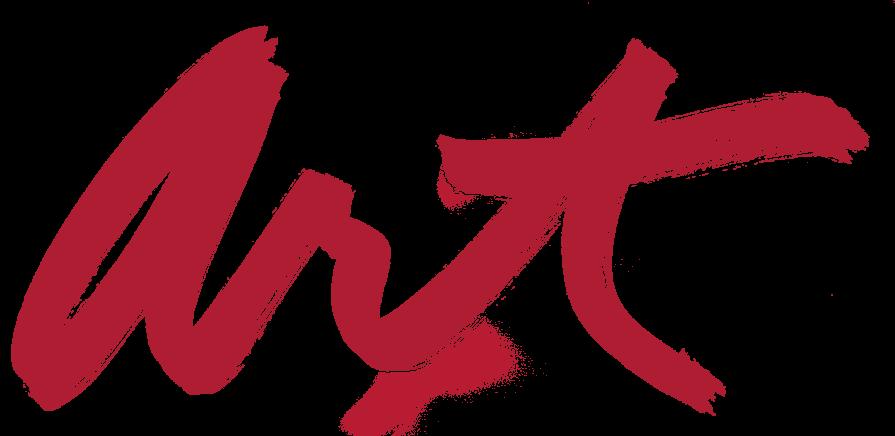

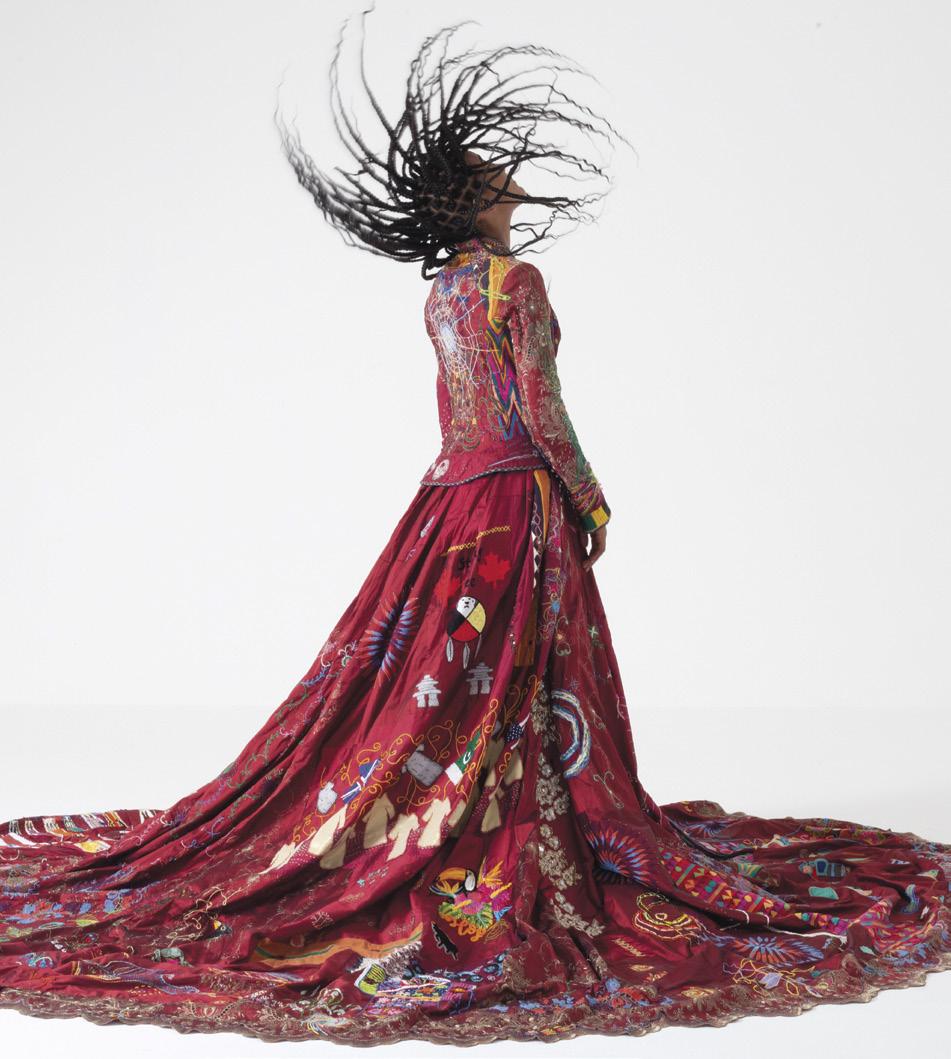
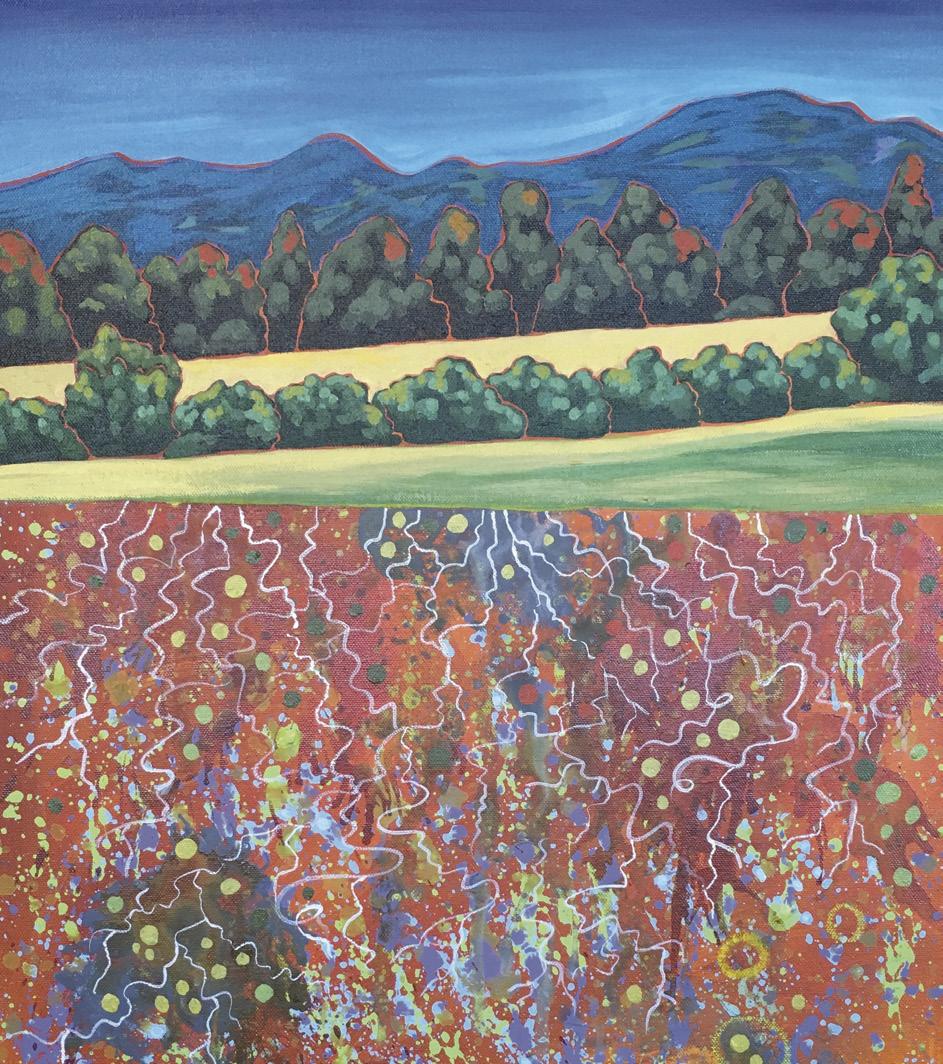
4 Art New England | March/April 2024 16 18 12 FEATURES 30 10 Emerging New England Artists Art New England’s Annual Highlight of Ten Exceptional Emerging Voices by Maureen Canney, Autumn Duke, Kelly Holt, Shanta Lee, and Emily Avery-Miller 40 The Metaphysics of Art: Through Engagement and Practice A Conversation with Nitasia Roland, Candace Jensen, Lux Heljardóttir and Jamie Mohr by Shanta Lee COLUMNS 7 Publisher’s Letter 8 FlashPoints 10 Gallery FlashPoints 12 Studio Visit Michele Johnsen by Alix Woodford 14 Studio Visit Troy Amuso by Charles Bonenti 16 Global Collaboration A Stunning Red Dress at Fuller Craft Museum by Cynthia Close 18 Museums On Her Terms: Feminine Power Embodied at Fitchburg Art Museum by Abbi Kenny 20 Insights The Healing Power of Art, Part II by Deb Hemley 22 On Screen The Peasants by Loren King 24 Then & Now Aerosol: Part I by Jennifer Mancuso 26 Exhibitions Andy Warhol and The Hall Art Foundation in Winter by Cynthia Close New England VOLUME 45, ISSUE 2

40
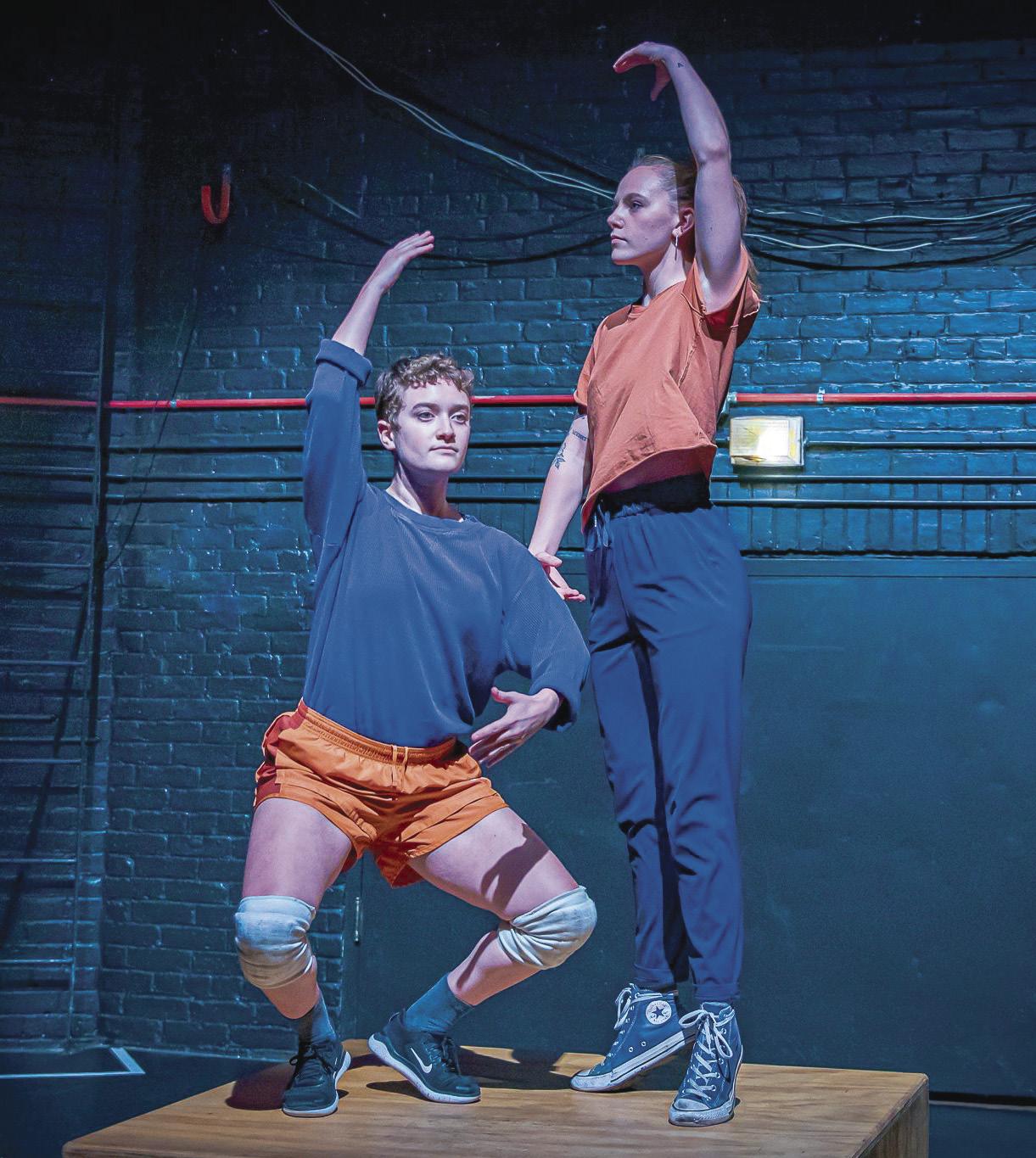

REVIEWS + PREVIEWS
SPOTLIGHT
57 Father and Daughter: William Zorach and Dahlov Ipcar at Maine Jewish Museum by Carl Little
58 Women Reframe American Landscape at New Britain Museum of American Art by Terri C Smith
60 The Myth of Normal: A Celebration of Authentic Expression at MassArt Art Museum by Jack Curtis
63 Whale’s-Eye View—Wu Tsang: Of Whales at ICA, Boston by Julianna Thibodeaux
64 Total Eclipse of the Art at The Gallery at WREN by Autumn Duke
67 In the Garden: A Platform for Artists, Poets and Performers at The Current by Amy Lilly
MAINE
59 The Portland Show at Greenhut Galleries by Carl Little
MASSACHUSETTS
61 As the World Burns: Queer Photography and Nightlife in Boston at Tufts University Art Gallery by Abbi Kenny
61 List Projects 29: Brittni Ann Harvey and Harry Gould Harvey IV at MIT List Center by Abbi Kenny
62 Eat & Drink at ClipArt Gallery by B. Amore
62 Gary Lichtenstein Editions at MASS MoCA by Bret Chenkin
65 Reshaping Abstraction at Concord Art by B. Amore
NEW HAMPSHIRE
65 Justin O’Rourke: A Matter of Time at AVA Gallery and Art Center by Eric Sutphin
RHODE ISLAND
66 Dreams of a Common Language at Overlap Gallery and Project Space by Eleanor Q. C. Olson
VERMONT
68 When the Light Breaks into Pieces, Carolina Ellenbogen at Ellenbogen Gallery by Bret Chenkin
DIRECTORYArtist
SEE PAGE 45
March/April 2024 | Art New England 5
61 30
(61)
IN THIS ISSUE 28 Calendar 49 Destination: New England 45 Art Guide 52 Guide to Schools and Workshops 69 Exhibition Listings 79 Classifieds 80 Art Seen A resource for artists, galleries, museums, and collectors.
(12) Michele Johnsen, Everything is Connected, 2021, acrylic on canvas, 18 x 24". Courtesy of the artist. (16) The Red Dress worn by artisan Freya Lusher. Photo: Sophia Schorr-Kon. (18) Claudia Olds Goldie, Got the Bull by the Tail, white stoneware, graphite pencil, graphite powder, 25 x 27". Courtesy of the Fitchburg Art Museum. (30) Jenna Gross and Jillian MacLaughlin of Rose Woods Dance Collaborative performing Something Very Wrong for Ten Tiny Dances, 2021. Photo: Bill Peresta. (40) Nitasia Roland, Tarot Emblemata CHROMATA—Renaissance Emblems, 2023, Urania Press. Courtesy of the artist.
Brittni Ann Harvey, Weeping Willow Angel (Robot Dog on Hind Legs), 2021, polyester on jaquardwoven fabric, plywood, polyfill, bronze 19 x 30 x 18". Courtesy the artist and Someday, New York.
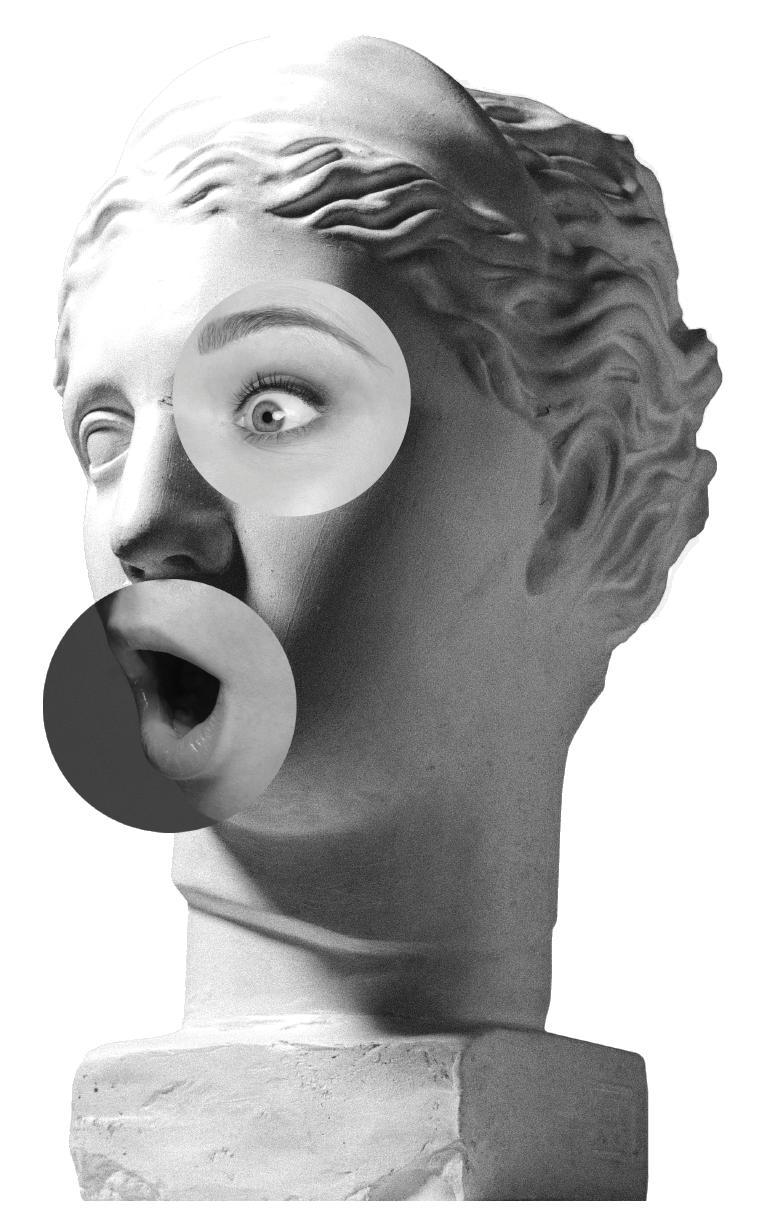

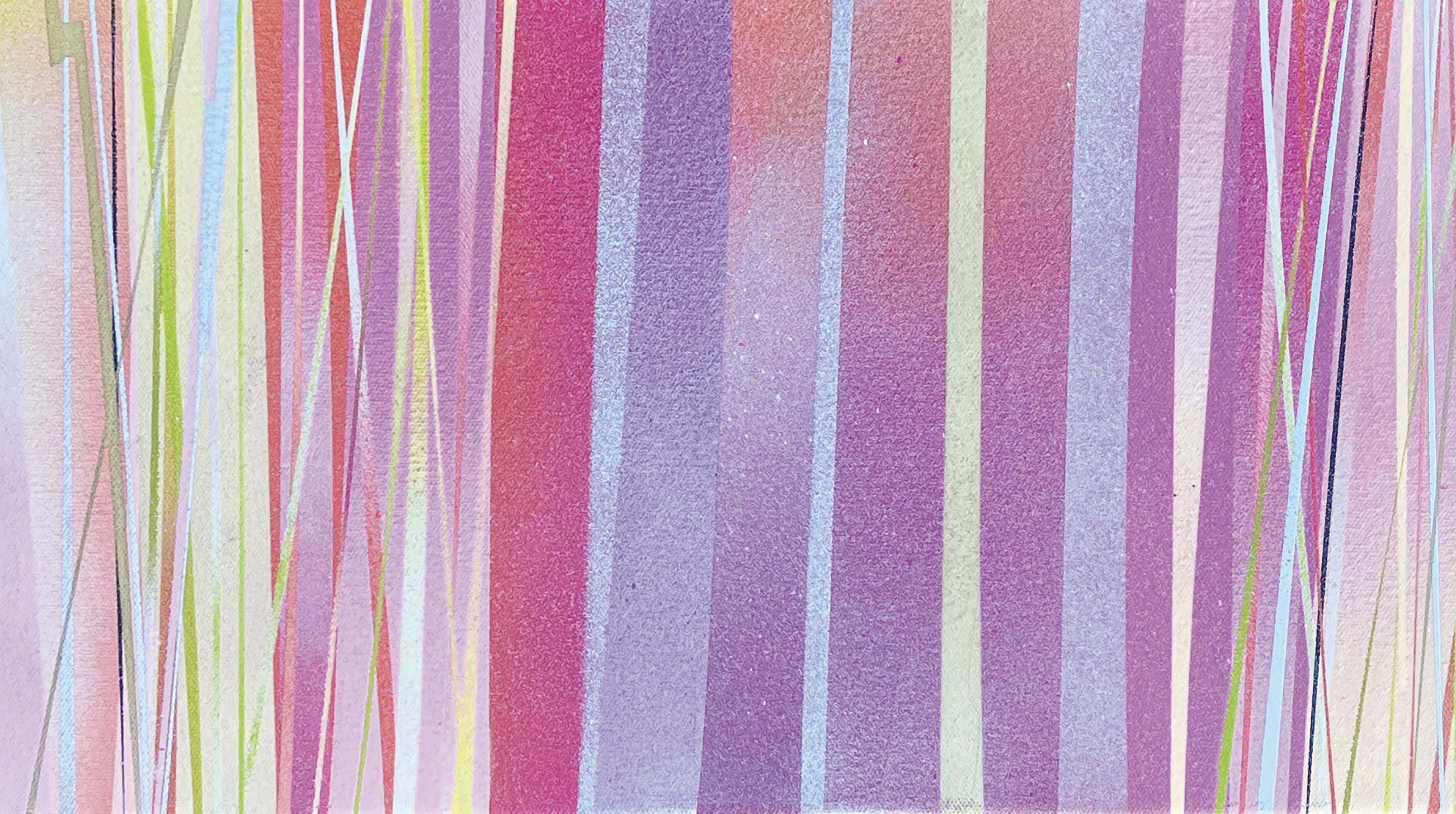
MONTSERRAT COLLEGE OF ART | BEVERLY/METRO BOSTON | MONTSERRAT.EDU Mystic (detail) by Daniel Hasson All proceeds benefit student scholarships at Montserrat College of Art for tickets & sponsorship, contact Allison Rieke: artrageous@montserrat.edu 978.921.4242 x1114 april 6, 2024 Artrageous!38 SATURday, APRIL 6, 2024 olio, 43 main street, peabody montserrat.edu/auction


Dive In, Rise Up
Sometimes the greatest act of rebellion is to speak the truth. — Alexei Navalny
Or paint it. Sing it. Write it. Dance it. Sculpt it. Print it. Like, in an art magazine.
When I learned of Navalny’s murder, I froze. I was not surprised, perhaps, on one level, yet absolutely crushed. And then I cried—for his family, his followers, for all who looked to this incredible human being for hope. Then I went back to work. I’m lucky. I was able to turn to this issue for a sense of hopefulness. I’m reminded every day of how grateful I am to witness the work and the intellect and the artistic ferocity of everyone covered in Art New England’s pages. And in this Emerging Artists Issue, in particular, where we share with you ten stunning, burgeoning, funny, intense, inquisitive artists—of all ages—who are rebelling in the best possible ways. The word rebellion does not always carry a violent connotation. It can simply mean the action or “process of resisting authority, control, or convention” (Oxford Languages). These artists resist convention in extraordinary ways. Spiritual, physical, intellectual. They are in

ON THE COVER:
their twenties and their seventies. I write in the feature’s intro that they are outrageously hopeful; at least they make me feel that way through their fearless self-expression. We’re honored to highlight Simon Montalvo, Lydia Kern, Elise Whittemore, Elisa Vanelli, Ngoc-Tran Vu, Ewa Chrusciel, Jenna Gross, Jay Stern, Donald Langosy, and our cover artist Sophie Cangelosi. We are honored to offer a small window into their work, their goals, and what art means to them. Navalny also wrote, “A person becomes truly free only when they are able to think and express their own thoughts.” This is a privilege we’re rapidly losing sight of in this world—even in America. Never thought I’d write that. Where else but in an art magazine can we find, in addition to these emerging artists, stories on an expedition with Cynthia Close to the Hall Art Foundation for cocoa in the café and a tour of the Warhol exhibition? Cynthia also takes us to the Red Dress exhibition at Fuller Craft Museum, a fourteen-year global collaborative embroidery project. Abbi Kenny discusses On Her Terms: Feminine Power Embodied at Fitchburg Art Museum where New England artists use the human body as a catalyst for dialogue around women’s rights. Autumn Duke shares WREN Gallery’s plans for its Total Eclipse of the Art exhibition in honor of April 8th’s total solar eclipse and New Hampshire’s astral position in the path of totality. Jack Curtis honors MassArt’s 150th anniversary. Charles Bonenti introduces us to Troy Amuso, whose medium is conservation, preserving history by restoring paintings that would otherwise be lost. Shanta Lee takes us deep into a fascinating realm where art and the metaphysical meet. This piece is expansive, so mesmerizing and offers a profound understanding of making art as a sacred, magical practice. And Amy Lilly walks us through In the Garden, The Current’s immersive, multi-platform installation whose description reminds us that “Paradise comes from a Persian word for ‘walled garden,’ traditionally a place for calm and reflection. In this setting, one is free to create anything imaginable, where truly anything can grow.”

The freedom to create anything imaginable. This is the message I want this issue to leave you thinking about. I am beyond inspired by the artists featured here; by the strength and urgency behind the themes of the exhibitions found both in the editorial and the Exhibition Listings section. Incredible work is happening across New England. And in the spirit of the cold plunge bravery of Sophie Cangelosi’s Quarry Diver on this cover, dive into it all. There are others in the water with you. Discuss the work, support the work, meet the artists. Celebrate our ability to speak our truth through art.
In gratitude,
 Rita A. Fucillo Publisher
Rita A. Fucillo Publisher
March/April 2024 | Art New England 7
FROM THE PUBLISHER
Emerging Artist Sophie Cangelosi, Quarry Diver, 2023, acrylic on panel, 148 x 48". Courtesy of the artist. See page 30.
Above: Tributes and memorials to Navalny outside the Russian Embassy by the Brandenburg Gate in Berlin, Germany. Photo: Kelly Holt.
FlashPoints
Compiled by Autumn Duke
APPOINTMENTS, AWARDS & NOTABLES
Appointed
(CT) Philippe Halbert has been appointed Richard Koopman Associate Curator of American Decorative Arts at the Wadsworth Atheneum Museum of Art. He has held the position of interim curator of American decorative arts at the Wadsworth since November 2022. Halbert graduated from the College of William and Mary and the Winterthur Program in American Material Culture and earned his PhD in the history of art from Yale University. He has curatorial experience from work at the Yale University Art Gallery, the J. Paul Getty Museum, the Philadelphia Museum of Art and Colonial Williamsburg.
(MA) Yao Wu has been named the first Huang Family Curator of Chinese Art and Culture at the Peabody Essex Museum (PEM). Wu will focus on creating new interpretive galleries for PEM’s Yin Yu Tang, a 200-year-old Chinese home, and the museum’s extensive collections of Chinese art and cultural objects. Wu comes to PEM with more than twenty years of experience in museums and academia. She most recently served as the inaugural Jane Chace Carroll Curator of Asian Art at the Smith College Museum of Art. Wu begins her role at PEM on March 4.
(MA) Stephen Remick is the new president of South Coast Artists. Remick replaces Heather Stivison, who is now board chair of the organization. Remick has been part of South Coast Artists since 2014, and most recently served as a board member. A born and raised Vermonter, Remick came to the South Coast region to earn his Bachelor of Fine Arts in painting from Swain School of Design. He takes this position at a pivotal time as South Coast Artists celebrates its twentieth anniversary this year.
(MA) Justin Willson has been appointed curator at The Icon Museum and Study Center. “He will play an important role in shaping the leading institute for icons and Eastern Christian art in the USA. In addition to curator, he will also spearhead the Study Center, which will be an essential part of the new Museum as we aim to connect to global audiences,” said Simon Morsink, director. Willson specializes in late

Byzantine and early Russian art and holds a PhD from the department of art and archaeology at Princeton University. He comes to the Museum from the Cleveland Museum of Art where he served as Mellon Postdoctoral Fellow in Art History Leadership since September 2022.
(MA) David Snider is Peabody Essex Museum’s (PEM) new director of learning and civic engagement, effective February 20. He comes to PEM from Hubbard Hall in Cambridge, New York, where he served as executive and artistic director. Snider brings with him more than twenty years of experience as an educator, director, producer and arts administrator. In his new role at PEM, Snider will prioritize engaging diverse audiences and historically underrepresented groups through public programming and community partnerships.
(MA) Boston Lyric Opera (BLO) has announced Nina Yoshida Nelsen as the new artistic director. Nelsen is a mezzo-soprano whose performances have earned her acclaim across North America and Europe. She is the co-founder of the Asian Opera Alliance. Nelsen will continue her performing career alongside her BLO work.
Nelsen joined BLO in 2021, first as a performer and then as artistic advisor. Acclaimed theatre director Anne Bogart also joins Nelsen and BLO’s artistic team as artistic associate.
(MA) Genée Coreno has been appointed the new artistic director of WAM Theatre. Coreno succeeds co-founder and producing artistic director Kristen Van Ginhoven, who is stepping down after fourteen years. Coreno will co-lead WAM with managing director Molly Merrihew. Coreno comes from the leadership team at Every Mother Counts and has previous experience at The Public Theater, Big Dance Theater and more. This change comes at a pivotal moment as WAM celebrates fifteen years of theater and activism in Berkshire County.
Awarded
(MA) The Fuller Craft Museum has been awarded a $1 million grant from an anonymous foundation. This is one of the largest grants in the museum’s fifty-five-year history. The grant will be used to support capital and building improvements including repairs to the roof, the HVAC systems and more. “From community programming, to dynamic exhibitions, to early arts education, having well-cared for and secured facilities is at the heart of our everyday work and is important for long term investment and planning,” said executive director Erin McGough.
(MA) Mass Cultural Council announced the 299 recipients of 2024 STARS (Students and Teachers working with Artists, Scientists and Scholars) Residency grants. STARS grants place teaching artists, scientists and humanists in schools across the state, bringing cultural enrichment to more than 32,000 students in grades K-12. This year, Mass Cultural Council saw a record number of applicants. Grants range from $2,500 to $6,100 and support residencies of three days or more. Any Massachusetts school is eligible to host one residency per academic year.
(MA) Maine Media College has received a grant of $45,000 from the Stephen and Tabitha King Foundation. The grant is dedicated to renovating the campus library, a project inspired
8 Art New England | March/April 2024
Jerry Wedge at The Umbrella Arts Center. Photo: Neil Causey.
and supported by an anonymous donor as well. This grant is one of the largest in the college’s fifty-year history. The gift will allow Maine Media College to finish and furnish the 1,000-square foot library, consolidate the library’s collections and archives, and make them accessible, and create room for more than 7,500 titles.
(CT) Sophia-Yemesi Adeyemo, Alex Dolores Salerno, Ezra Moth, Tielin Ding, Sae Jun Kim and Dylan Hausthor have been announced Real Art Ways’ 2023 Real Art Awards recipients. Recipients are awarded cash prizes of $2,500, solo exhibitions at Real Art Ways and a publication with commissioned essays about their work. Real Art Awards are annual and are open to artists in New England, New York and New Jersey. This year’s awards were juried by interdisciplinary artist, musician, writer and curator Devin Kenny, installation and performance artist Aki Sasamoto and executive director of Real Art Ways Will K. Wilkins.
(CT) Kimberly Klauss is the inaugural artist-in-residence at the Bruce Museum. This award was made possible due to generous support from Art Bridges. During her nine-month residency, Klauss will explore and deepen her craft and respond to two works on load from Art Bridges’ permanent collection: Collage X Landscape by George Morrison and DNA: Sepia V by McArthur Binion. Klauss also has plans to engage with the public through events, workshops and open studio sessions.
Noted
(MA) The WNDR Museum has opened a new location in downtown Boston. WNDR Museum Boston is located at 500 Washington St. at Downtown Crossing. The new facility is WNDR’s fourth and largest location, and the first on the East Coast. WNDR Museum Boston is a 17,000-square foot space hosting more than twenty exhibits featuring interactive, multisensory installations by cutting edge artists, collectives, designers, technologists and makers. The museum held a grand opening on January 31, 2024.
(MA) Jerry Wedge is stepping down from his role as executive director of The Umbrella Arts Center. Wedge has plans to leave his position at the end of June 2024. This marks the end of twelve years of work at The Umbrella Arts Center and the completion of strategic goals and plans. Wedge led the organization through the construction of a new facility and through the COVID-19 pandemic, guiding The Center to become the thriving arts and cultural hub it is today.
(MA) The Essex Art Center reopened in mid-January after a month of renovations. This
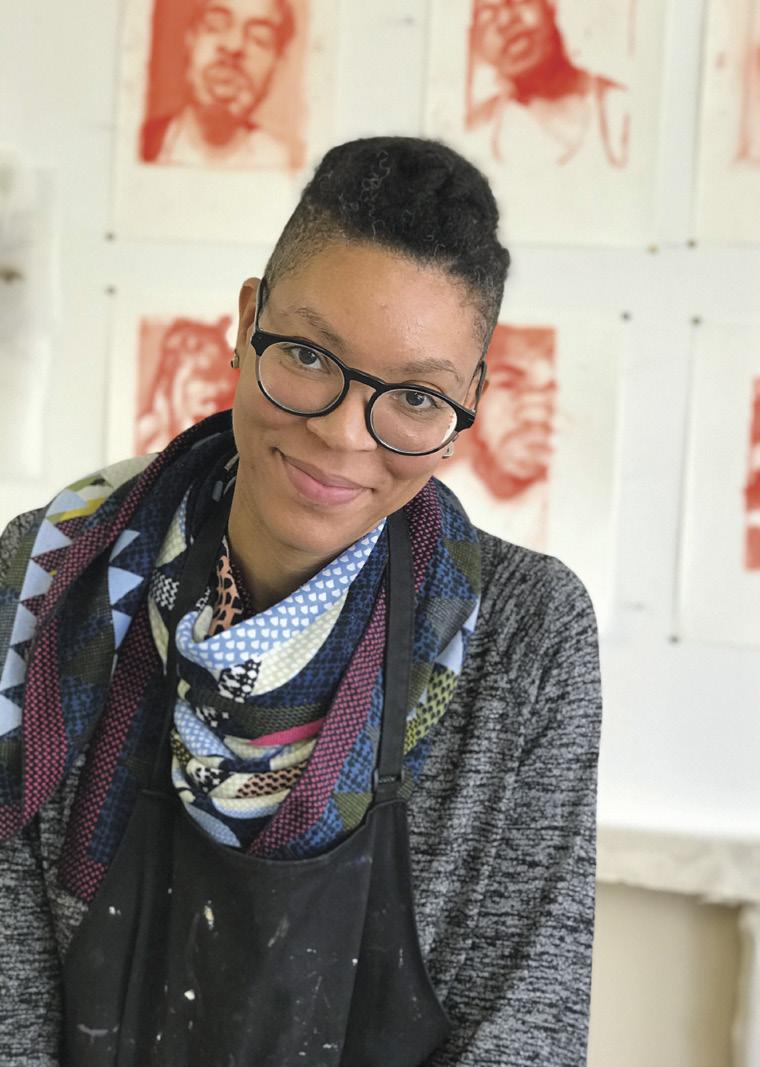
nonprofit is dedicated to growth and learning for the diverse community of artists and art appreciators in Greater Lawrence. The Essex Art Center celebrated its thirtieth anniversary in 2023 and has an ongoing initiative, the Building Creatively Campaign, to ensure its success moving forward. The campaign, through which this renovation was made possible, aims to renovate facilities, acquire equipment and technology, and build on accessibility and capacity to serve the community.
(MA) The Evergreens at the Emily Dickinson Museum reopens to the public on March 1. This historic home lies just west of the Homestead and was constructed for Dickinson’s brother Austin and his family in 1856. The Evergreens has been closed since 2019 for extensive preservation efforts focused on reducing energy consumption and making environmental improvements to preserve the collection of objects housed within. Austin and his family played a large role in Dickinson’s life and in the posthumous spread of her poetry.
(MA) Hasty Pudding Theatricals, the oldest theatrical organization in the U.S. and third oldest in the world, celebrates its 175th anniversary this year. Hasty Pudding began as a Harvard student club in 1795. Members were mandated to “provide a pot of hasty pudding for every meeting,” giving the group its name. The club’s annual tradition of comedic and elaborate mock trials transformed in 1844, when the tradition was broken in favor of putting on a comedic opera. In the 175 years since, Hasty Pudding has put on a student-written show every year except during World Wars I and II and the COVID-19 pandemic.
(MA) Boston South Visual Arts Trail is a new marketing collaboration created by five arts and cultural institutions from south of Boston: Fuller Craft Museum in Brockton, Attleboro Arts Museum in Attleboro, South Shore Art Center in Cohasset, the Art Complex Museum in Duxbury and the Plymouth Center for the Arts in Plymouth. Each of these locations is a small, local art institution offering free admission. None is more than a forty-minute drive from the others and every location offers rotating exhibits and new experiences for visitors. They look forward to more collaborative endeavors in the future through this partnership.
(NH) The Museum of Art at the University of New Hampshire (UNH) is closed as of January 2024. The Museum of Art began as the Art Gallery and moved into the newly built Paul Creative Arts Center in 1960. It was renamed in 2010 to reflect the museum’s stewardship of its growing permanent collection. Although the museum is closed, it leaves behind a legacy of art and meaningful connections made across UNH’s campus and beyond. As director Kristin L. Derocha said in her statement of closure, “[t]he insightful discussions sparked by our exhibitions, and the collective appreciation for art and creativity – these are the treasures that we will cherish after our time at UNH ends.”
(RI) The Choral Collective of Newport County has relaunched as Newport Sings. This rebranding was made possible by a marketing grant through Skills for Rhode Island’s Future, which Newport Sings received in September 2023. The organization worked for three months to create its new logo and branding as well as a more easily accessible website. Newport Sings’ programs and mission remain the same: to welcome and empower voices, to strengthen their community of voices, and to inspire joyful voices.
(RI) FirstWorks celebrates its twentieth anniversary in 2024. The nonprofit organization was founded in 2004 as part of a unique public-private partnership with the Department of Art, Culture, and Tourism to bring first-class performing art experiences to the Providence community. Continuing this mission, and as part of 2024’s Global Journeys theme, FirstWorks has announced an artist residency and public performance with international performance collective Small Island Big Song, a group comprised of prominent Indigenous artists from island nations across the Pacific and Indian Oceans. The group will conduct five days of workshops and community conversations culminating in a public performance on March 15.
March/April 2024 | Art New England 9
Kimberly Klauss at the Bruce Museum.
FlashPoints
Compiled by Autumn Duke
NEWS FROM THE GALLERY SCENE
Massachusetts
(MA) Fountain Street is closing its doors on March 31. The gallery was founded by Cherie Clinton and Marie Craig in 2011 in Framingham and moved to Boston in 2017. Fountain Street presented more than 200 exhibitions in its thirteen-year run. “We’ve had a phenomenal run, and now it’s time for the next generation of gallerists to make their mark,” said Craig, director of Fountain Street. The Main and Annex Galleries showed a variety of work primarily by New England artists, while the innovative Sidewalk Video Gallery featured a non-stop display of video and digital media art from artists around the world. The final three exhibitions feature works by Fountain Street’s core artists.
(MA) 50 Arrow Gallery has found a new home at 116 Pleasant St., Suite 136 in Easthampton. The gallery celebrated its grand reopening on February 8, 2024. Founded in 2021, 50 Arrow Gallery centers BIPOC artists and creators and aims to promote social equity and inclusion through accessible art. The gallery reopened with Perception & Perspective, an immersive multimedia solo exhibition by David Andrews, on view through February.
(MA) Jane Deering Gallery (JDG) has announced that it is expanding its gallery space. JDG was founded in 2002 in a residential area of Gloucester and moved to its current location in the historic 1842 Capt. Harvey Coffin Mackay house in 2016. The expansion will now place JDG in two front rooms at this downtown location. JDG shows contemporary art from emerging and established artists with a focus on artists based on Cape Ann. The gallery has been closed since January and will remain closed through March while work on the expansion takes place.
New Hampshire
(NH) RVCC Projects is a new gallery at 1 College Place on the Claremont campus of River Valley Community College. The gallery is a platform for art exhibitions, special projects and public programming. RVCC Projects hosts three exhibitions a year with a focus on critically engaged art from regional artists. The gallery was


born from a desire to enhance student experiences on campus, support the college’s diversity, equity and inclusion efforts, and contribute meaningfully to the surrounding community.
Rhode Island
(RI) Hera Gallery celebrates its fiftieth anniversary in 2024. Founded in Wakefield in 1974, Hera was one of the first women-run and womenfocused galleries in the United States and is one of the few to remain since then. In honor of this milestone, Hera Gallery is revisiting previous exhibitions that continue to have relevance today. Each exhibition title is inspired by an exhibition from the last fifty years, starting with virtual exhibition Girl Art Now in February 2024. The gallery will hold a fiftieth anniversary exhibition in June titled Hera Gallery: Past and Present.
10 Art New England | March/April 2024
GALLERY
Above: The founding members of Hera Gallery. Courtesy of the gallery. Below: 50 Arrow Gallery’s grand reopening featuring Perceptions & Perspectives by David Andrews in the main exhibition gallery. Courtesy of the gallery.
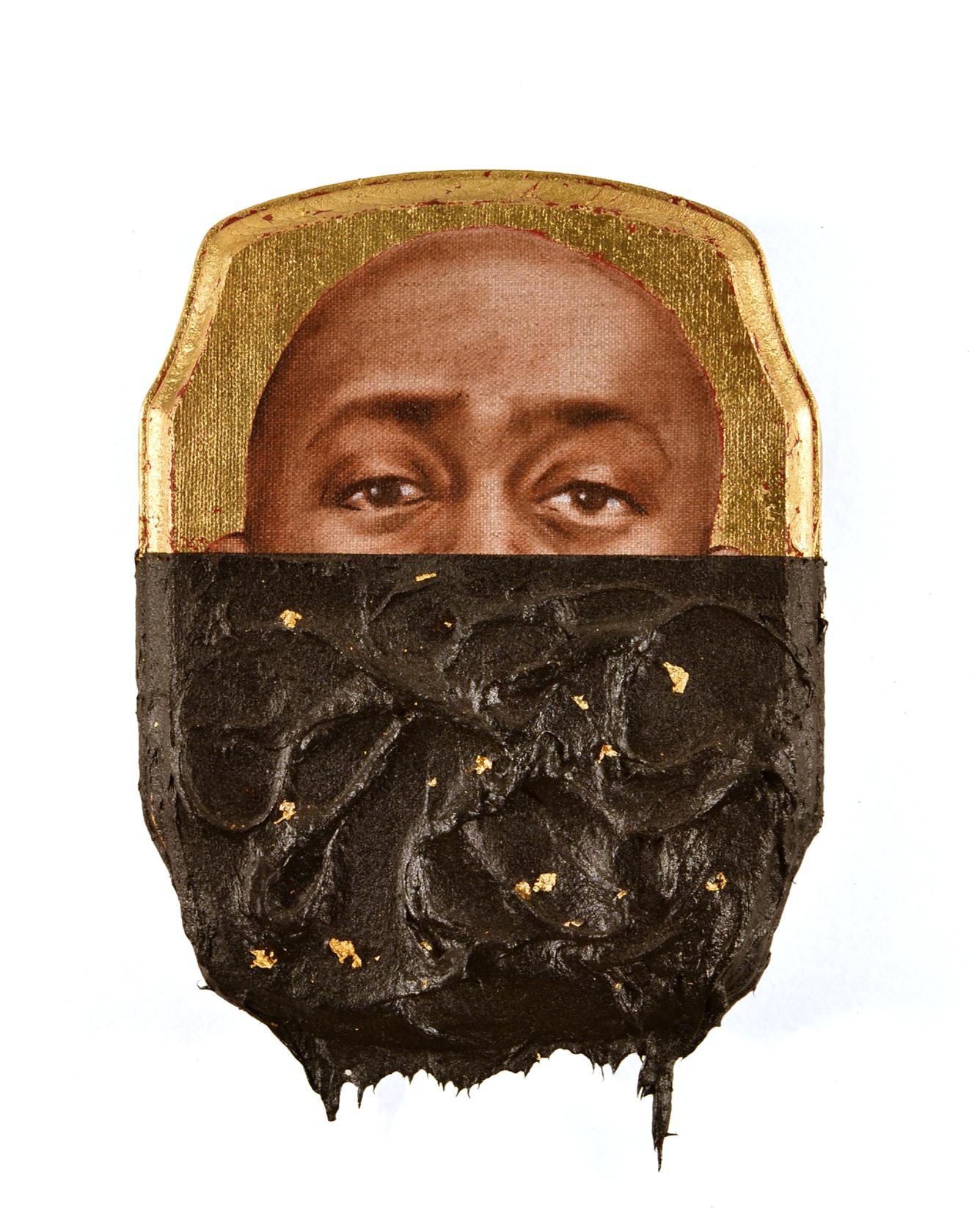

THROUGH MARCH 28, 2020
Vanessa German: Miracles and Glory Abound
On view through June 22, 2024
Titus Kaphar, Jerome XLVIII, 2015. Oil, gold leaf, and tar on panel; 10 x 7 1/4 x 1 1/8 in. Rennie Collection, Vancouver. © Titus Kaphar, photo courtesy of the artist and Rennie Collection, Vancouver
Gilded: Contemporary Artists Explore Value and Worth is organized by the Weatherspoon Art Museum at UNC Greensboro and curated by Emily Stamey.
Ralph Eugene Meatyard: Stages for Being
Visit website for programming information
Neue Slowenische Kunst | Monumental Spectacular

September–May: Mon, Wed 10–7:30; Tues, Thurs, Fri, Sat 10–5
March/April 2024 | Art New England 11
Vanessa German, Miracles and Glory Abound, 2019, installation at Bates Museum of Art.
Ralph Eugene Meatyard, Untitled, 1962, gelatin silver print. © The Estate of Ralph Eugene Meatyard. Courtesy of Fraenkel Gallery, San Francisco and DC Moore Gallery, New York.
APRIL 12–MAY 25 Senior Thesis Exhibition 2024
APRIL 12–OCTOBER 5
GILDED: CONTEMPORARY ARTISTS EXPLORE VALUE AND WORTH
STUDIO VISIT
By Alix Woodford
Michele Johnsen
The road to Michele Johnsen’s studio winds through the woods and mountains of Colebrook, New Hampshire, an area of unmistakable natural beauty. The studio sits in the woods. It is simple, with white walls and rustic wooden beams. A large front window faces the forest. Nature feels equally present inside the studio, where landscape paintings cover the walls. Most striking about these works is the abundance of color. Saturated hues and bursts of light make Johnsen’s paintings glow with energy.
Johnsen describes her works as nontraditional landscapes that explore “ideas of connectedness in nature through mark-making and vibrant, highly saturated color.”
These marks and color mimic the play of light and evoke the underlying energies in natural environments. The artist translates the magic she senses in nature’s broad vistas and intimate scenes into works that brim with joyful reverence and enchantment.
When Johnsen first came to New Hampshire in 1976, she was not a painter. She was a young mother who had decided with her husband to leave Long Island and homestead in a remote part of the country. After “shopping” several far-flung locations, they chose Colebrook in New Hampshire’s Great North Woods, a region north of the White Mountains, near the Canadian border. Here, she raised three sons in the house her husband built. With small children at her feet, Johnsen—creative since childhood— took up crafting, then learned calligraphy and pencil drawing, earning an income doing both. As her kids got older, she decided to pursue art teaching. (She would end up teaching art in

Her trees and mountains are outlined with intense ribbons of color, embodying the vibrations of the natural world. Each vivid pop of orange, pink, or blue amplifies nature’s brilliance.
Her earlier landscapes were more objective, she says. An MFA program at the New Hampshire Institute of Art, which she completed in 2017, led her to incorporate more abstraction in her pieces, along with underlayers of color and surface mark-making. Recently, her perspective has been evolving, too. As she’s learned more about the life-supporting forest layers that often go unnoticed—the biodiverse understory and the underground fungal networks that form communication systems among trees—she’s begun to add subterranean layers to her landscapes, filling them with wriggling, bubbling shapes, and of course, intense color.
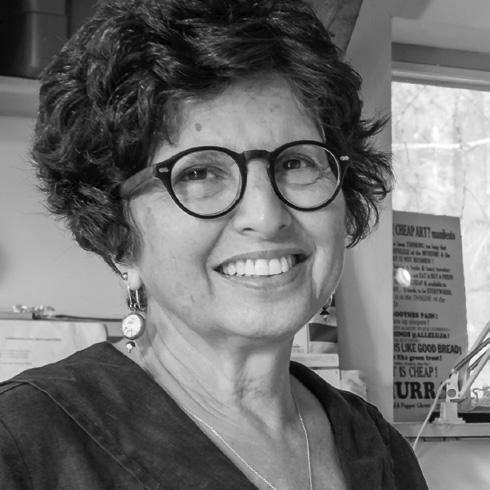
Wade was a step backward for women. She’d became a mother in the 1970s, when gender roles were more rigid, then watched over the years as women gained more equality. The current setback angers her. Why the title Domesticated? Johnsen answers frankly, “Women, especially of my generation and before, had to become domesticated, like an animal.”

public schools for eighteen years, retiring in 2020.) It was while working toward a BS in art education that she started painting. The medium allowed her to “loosen up,” as she puts it, and led to her work in landscapes.
As central as landscape painting is to Johnsen’s art, it is not her sole focus. She’s currently preparing for a March 2024 installation at the Great North Woods Center for the Arts. Titled Domesticated, the installation will explore women’s issues and is timed for Women’s History Month.
While a shift from her landscape work, the project is not a departure from her artistic values. “Part of being an artist is speaking to current times,” Johnsen says. She, like many Americans, felt the Supreme Court’s 2022 reversal of Roe v.
The installation will represent women’s struggles by turning the notion of traditional women’s work on its head, incorporating sewing and clotheslines in decidedly non-traditional ways. Several months ago, Johnsen dragged out her sewing machine and began stitching lines into paper that she’d covered in abstract watercolor designs. Some of the lines are straight, some veer off; some of the papers are intact, others torn—together the pieces demonstrate women’s efforts to fit a domestic mold and the impossibility of always succeeding. Thousands of threads, left untrimmed, dangle from the edges, showing the tediousness of the work, while also suggesting a refusal to conform to what’s expected. The final pieces will be suspended on a chain that’s been crocheted by dozens of women. As she does when painting the subterranean in her landscapes, Johnsen is giving voice to underrecognized life-giving forces—in this case, women.
When the installation is finished, Johnsen plans to continue with landscapes. As always, she is drawn to new perspectives. What interests her now? The sky, she says. The northern New Hampshire skies have been spectacular of late.
Alix Woodford is a writer based in NH’s Monadnock Region. She holds an MFA in creative writing from the New Hampshire Institute of Art.
michelejohnsen.com
12 Art New England | March/April 2024
Above, from left: Wise Woman II, 30 x 40", acrylic on canvas. Courtesy of the artist. Domesticated, mixed media, size variable, installation shot. Courtesy of the Great North Woods Center for the Arts. Top: Michele Johnsen at her studio in Colebrook, NH. Photo: Gary Samson.
April 28 through September 1, 2024
National Assoc. of Women Artists MA
Where
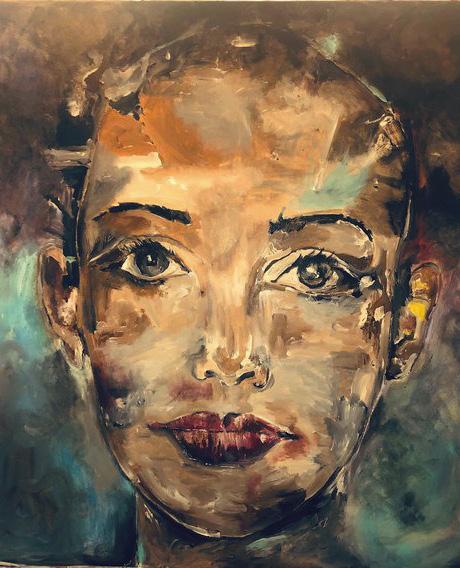
Cassatt and Beyond: Woman Printmakers
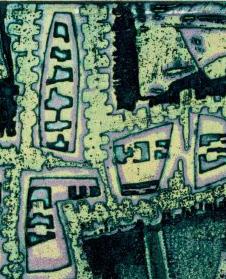
Opening Reception: May 12, 2024, 1:00-4:00pm
Also on exhibit: Prints by Edward Landon through April 13, 2024
Zach Horn: Saturdays, through May 5, 2024
189 Alden Street Duxbury, MA 02332
781-934-6634
www.artcomplex.org
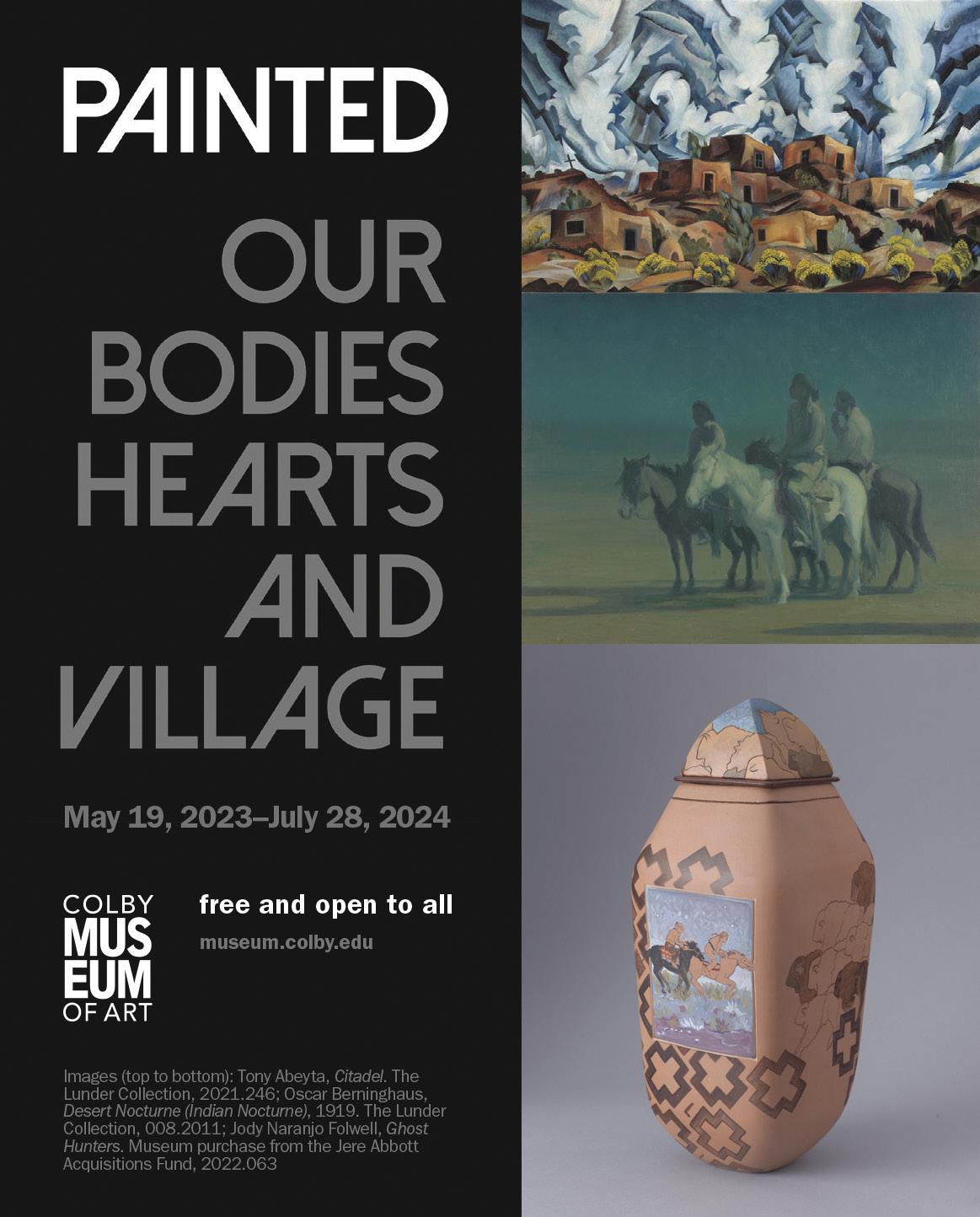

Do We Come From? What Are We? Where Are We Going?
Shirley Wales, Abstraction, before 1978, (Detail), intaglio
Jennifer Jean Okumura, Where are we going?, oil on canvas
March/April 2024 | Art New England 13
STUDIO VISIT
By Charles Bonenti
Troy Amuso
Troy Amuso entered the realm of painting conservation at age fourteen. At sixty-one, it’s become his life’s work. An art enthusiast and A-student in his hometown of Mount Kisco, NY, in 1977 Amuso was introduced by a family friend to Dutch conservator Yan Vanderviver as an after-school helper.
“I did not work on paintings, but he gave me odd jobs beyond sweeping the floor,” Amuso said. “I was fascinated.”
A few years later, he was prepping paintings for treatment and taking canvases off stretchers. At seventeen, he was given a painting to frame and told afterwards that it was by English artist J.M.W. Turner (1775–1851). “It was a big moment,” he declared. “That set my course.”
Amuso studied at New York’s School of Visual Arts and landed jobs at conservation studios in New York, Connecticut, and Los Angeles, where he honed his skills and established his credentials as a professional painting conservator.
In 1995, he and his wife, Denise DiGrigoli, a marketing consultant, established Troy Fine Arts Services Inc., in Fairfield, Connecticut.
involve surgically repairing damaged canvases. All work, he noted, has to be reversible and must not damage the original, according to the American Institute for Conservation code of ethics.
Artworks owned by everyday art collectors are more vulnerable, he said, to “the havoc of environmental effects” than those kept in climatecontrolled conditions at major museums.
Among the damaging effects he cited: sunlight that fades colors; heat that dries and cracks paint surfaces; damp that rots canvas and paper; smoke that discolors with soot; and aging that weakens an artwork’s structure.
Amuso cautioned against hanging paintings over fireplaces or storing them in a basement or

Two years ago, they expanded into the art-rich Berkshires, buying a house in Ashley Falls and opening a satellite studio.
It’s “a niche business,” Amuso explained, serving private museums, collectors and art lovers. Oil paintings are his primary focus. He also lectures around the region.
“I love sharing how restoration preserves our history though paintings that will be otherwise lost,” he shared.
It was at one such lecture in November 2023 at Berkshire Community College in Pittsfield, MA, that this writer first met Amuso. Our Studio Visit became a three-act production, with a telephone interview after the lecture and a subsequent virtual visit to Fairfield.
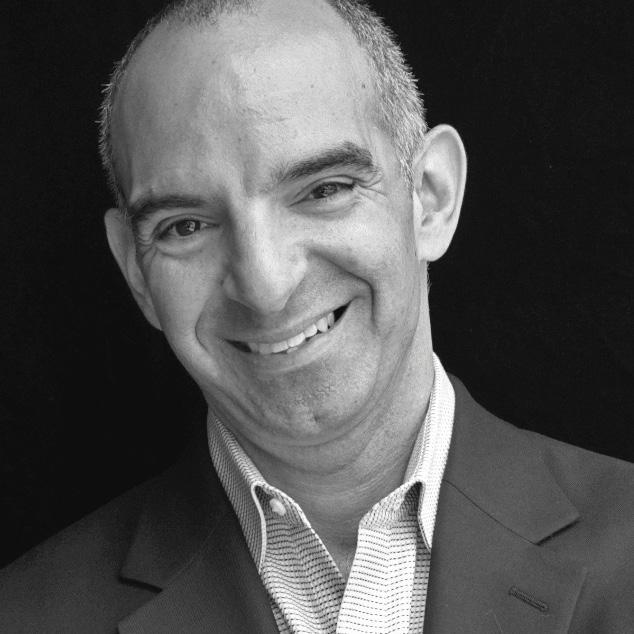
plate with a sheet of acetate over it. The edges of the overlay are sealed and a compressor draws the air out, creating a vacuum that gently presses the acetate onto the warmed paint/ adhesive layers, flattening them against the canvas. A worn canvas can also be “relined” to a new one by a similar process.
Amuso repairs paintings of all styles, time periods and subjects because the baseline process is essentially the same, yet he studies each maker’s methods to accurately recapture how the artist intended the artwork to look.
An example he uses in his lectures and on his website is an 1854 oil portrait of Pittsfield mill owner Thaddeus Clapp. It passed through generations, until a hurricane destroyed one heir’s house severely damaging the portrait. It was wrapped in newspaper and stored for decades before a descendent took it to Amuso. Extensive work, he said, “brought it back to good health … It looked great when it left.”
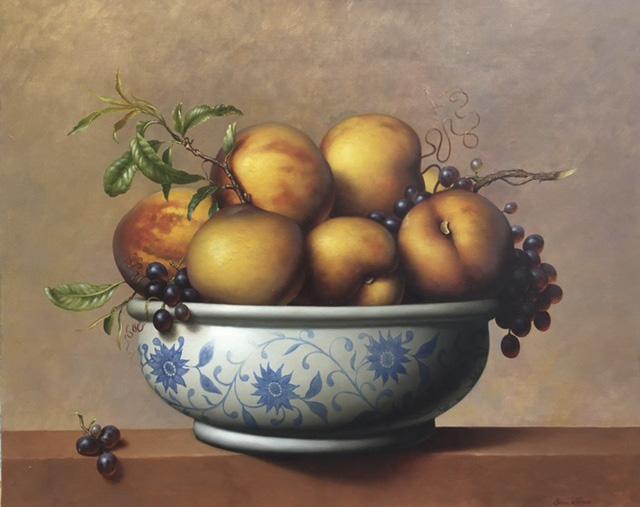
attic where temperatures and humidity fluctuate. For surface cleaning, he advised a feather duster.
During the virtual visit through his studio, Amuso toured his workspace and tools, housed in an area the size of a two-and-a-half-car garage.
Ventilation is crucial, he said, to exhaust the fumes of solvents used to clean and remove varnishes. Before such health hazards were addressed, conservators often suffered skin or respiratory reactions.
“I wear an aerator mask with certain solvents,” he explained. Portable tabletop fans exhaust fumes from close workspaces. Correct lighting is essential for accurate color coordination. He combines fluorescent and halogen fixtures to approximate natural light.
“I can restore anything if the client has the emotional commitment along with the financial resources to do so.” On fees, Amuso declined to generalize, saying he has to study a painting’s condition before providing a free, detailed estimate. “Some of the most extensive restorations have been for sentimental rather than street value.”
History repeats as his daughter, Ava, twentyone, joined his practice part time as a junior apprentice.
“She doesn’t know if she wants to be a conservator,” he said, “but I love her to be involved. She is the only one who touches paintings besides me. She’s got my DNA.”
Charles Bonenti is a freelance art and architecture critic who lives in Lenox, MA.
Painting conservation, he explained, is mainly cleaning and re-varnishing, while restoration may troyfineart.com
A “hot table” is useful to repair damaged paint surfaces. The artwork is placed face up on a heat
14 Art New England | March/April 2024
Above: A before and after look at an early 19th century still life painting (artist unknown), oil on canvas. It was severely damaged by heat and smoke in a house fire. Amuso was able to fully restore it back to a healthy state. Top: A portrait of Troy Amuso. Images courtesy of Troy Amuso.

 By Cynthia Close
By Cynthia Close
A Stunning Red Dress
British artist Kirstie Macleod conceived the Red Dress Embroidery Project as a platform for women around the world to tell their personal stories through embroidery. Fourteen years in the making, the dress, recently on view at the Frick, Pittsburgh, continues its journey to the Fuller Craft Museum in Brockton, Massachusetts through May 19, 2024. Functioning as both an aesthetic object and a garment, it features the contributions of three hundred eighty artists from fifty-one countries and although eleven contributors were men and two were non-binary, the dress has become a representation of trans-national unity and women’s self-expression.
In a recent telephone interview from London, England, Macleod had just settled her two young boys in front of the television, giving this single mom a quiet moment to provide the backstory on the birth and evolution of the Red Dress project. “I spent most of my childhood living in different countries. I was fascinated with people and experienced a wide range of cultures. I became aware of women’s rights and vast inequalities early on. I also always knew I was an artist.”
Macleod’s work is grounded in fine arts with a focus on textiles and costume. Her earliest important commissions, starting in 2008, were installations involving her textile work combined with photography, film, and painting. Her ideas of identity, inequality, and the subconscious took a distinctly feminist approach. It was a com-


mission in 2009 funded by the British Council, Dubai, that triggered the start of the Red Dress project. Macleod went to a café to think about what form this new project would take. She started drawing and the concept came to her very quickly. “I realized this project could weave all the elements of my life together—my interest in cross-cultural collaboration—while celebrating women’s identity, bringing my art and theirs, out of the gallery into the world.”
The dress is comprised of many panels of burgundy silk dupioni. Initially, separate panels were sent to one hundred forty-one commissioned embroiderers, many of whom came from impoverished circumstances in Egypt, Mexico, and South Africa—including refugees from Palestine, Syria, and Ukraine, among others. Each textile artist was told to use their skills in whatever way they desired. There were no restrictions regarding, color, design, or imagery. Some of the embroiderers were established professionals, while others used needle and thread for the first time to tell their stories. The complexity of the designs varies widely, yet it is the elegant design of the dress,
sparking comparisons to Renaissance finery, that holds these visual elements together creating an encyclopedia of stitchery to explore. All the commissioned embroiderers were compensated for their work, and continue to receive a share of the earnings from exhibition fees and sales via an Etsy shop for Red Dress merchandise.
Initially, Macleod would wear the dress as an installation piece. It served as an extension of her own art practice. In 2015 she removed herself from the public presentation of the dress. On the Red Dress website, photos of women from the U.K. to Kosovo, to Chiapas, Mexico, along with short
16 Art New England | March/April 2024
GLOBAL COLLABORATION
Above: The Red Dress worn by Natasha Faye Hopkins, 2019. Photo: Dave Watts. Left: The Red Dress Embroidery Project founder Kirstie Macleod, 2021. Photo: Sophia Schorr-Kon. Opposite top, from left: Sharmin Sadia, Kurdistan and Tugba Gula in Turkey, Swansea, 2022. Photo: Mark Pickthall. Gisèle, Esther et Espérance in the DRC, 2018. Photo: Nicole Esselen. Embroidery details (L to R): From Kosovo and Kenya; From Egypt, Mexico, Russia, and South Africa. Photo: Dave Watts. From Egypt, 2021. Photo: Sophia SchorrKon. Left: Artisan Hilaria Lopez Patishtan, San Chamula, Mexico in 2020. Photo: Kirstie Macleod.
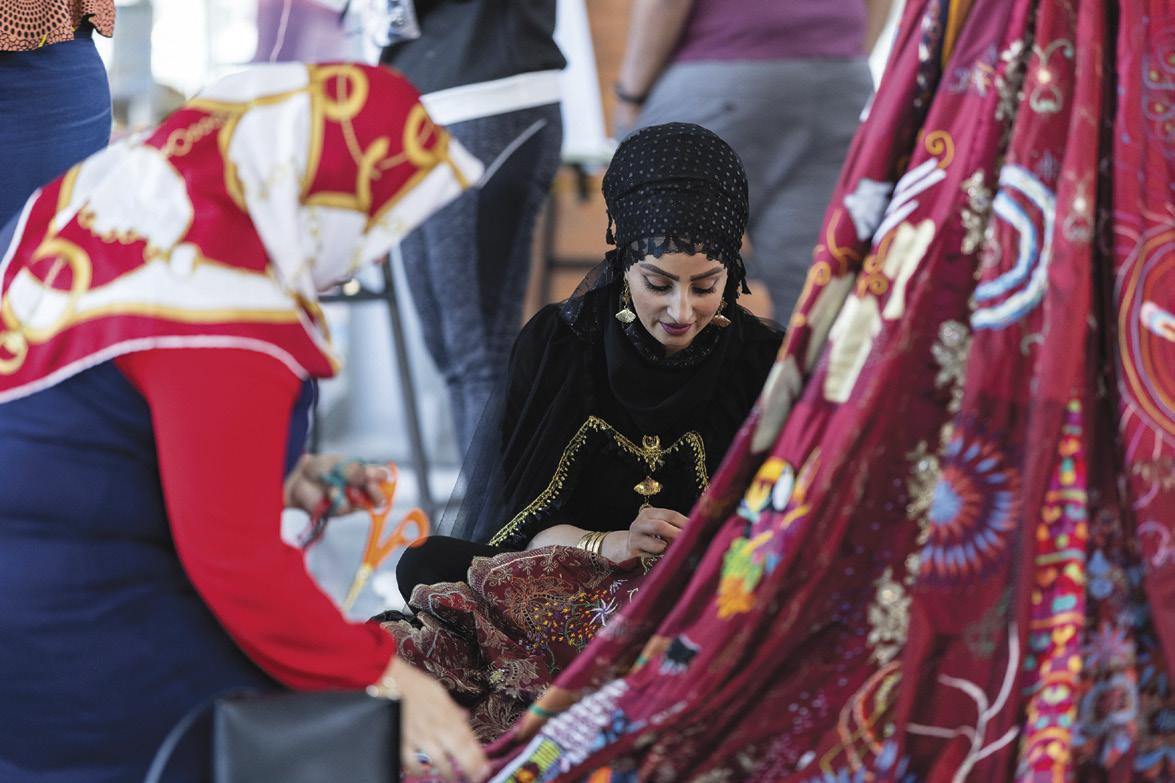
videos highlighting the contributors—a third of whom were survivors of war or living in impoverished circumstances—are shown seeing the dress as a completed garment for the first time and in some cases wearing the dress. Now a mannequin displays the dress on its journey around the world. This is a case where a garment has become a symbol of empowerment, transcending borders both geographical and cultural and has come to represent much more than the sum of its parts.
Beth McLaughlin, artistic director and chief curator at the Fuller Craft Museum first heard about the Red Dress three years ago on social media. She approached Macleod about working on a U.S. tour and discovered that the timing was perfect since the artist had decided that in 2023, the dress would be complete. Prior to that, panels had continually been added and Macleod had been managing the project full-time for fourteen years. The dress first came to the U.S. in July 2023 via the Southern Vermont Arts Center prior to its engagement at the Frick and is supported through a partnership with the Fuller. McLaughlin had heard from curators at other institutions that had shown the dress that “people were weeping in the galleries” due to the emotional impact of seeing the work of so many women united in one iconic garment.
Continuing the process of community engagement which is an integral aspect of the project, each venue designs their own “calico dress,” made of panels of a white cotton/muslin fabric. Brockton volunteer Denise DeMore has been instrumental in organizing this outreach aspect of the exhibition. Amya Fairbairn (Fuller Craft Museum employee and artist) stenciled a design on some of the fabric that will be available for painting as well as quilted and stitched. Gateway Arts in Brookline, MA, as of this writing, tentatively accepted the invitation to do one of the panels and Fuller Craft Museum educators/docents will work on the other sections. Members of the community will be invited to create their own embroidered or painted stories

on three panels during a Community Day Event. The Fuller has decided, rather than display the calico dress as a garment, that the panels will hang separately on the wall like textile art.
McLaughlin commented, “Kirstie is so intrepid, she usually travels with the dress in a suitcase on the plane.” Yet McLaughlin is equally intrepid. She is flying to Pittsburgh, picking up the dress, renting a car, and driving back nine hours to Brockton. That’s the way women get things done.

playing their handiwork that is now a part of this inspiring project, it seems Macleod’s goal to “shine a light” on women’s accomplishments in some of the darkest regions of the world has been met.
Macleod has shown her colorful, stitcherybased, multimedia abstract work in galleries and museums around the world, with many pieces held in notable private and public collections. She recently has been elected an ambassador for the Textile Society for her “...sustained commit-
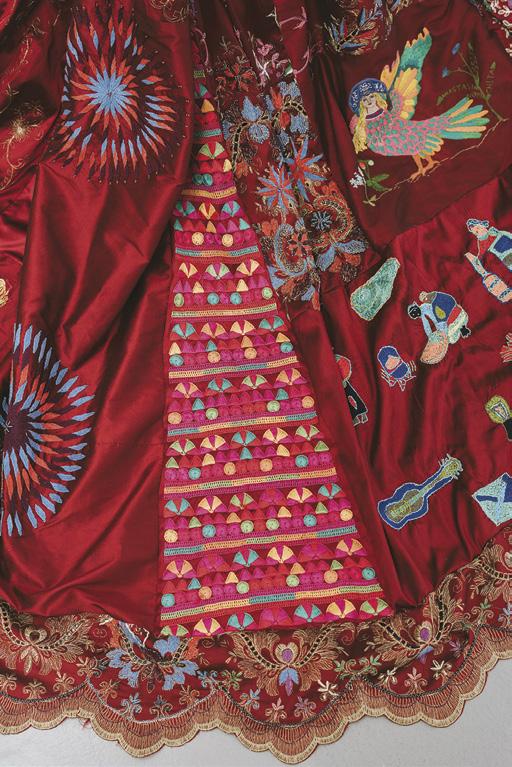
None of the, “That’s not my job!” hierarchical response one might expect if the head curator were male.
Meanwhile Kirstie Macleod is not resting on her laurels. Although she has more time, “I spend about three days a week on my own work,” Macleod is fundraising to produce a documentary film about the project along with a coffee table book and working with a conservator to get each piece of the dress archived. “It’s been such a rollercoaster. I’ve been a single mom all this time. There were plenty of moments when I thought ‘how can I do this?’ I feel so much responsibility to the women and their stories. I’ve felt it was my mission to see this through.” Judging from the images of women around the world proudly dis-

ment to the Red Dress as a global community project, the outcome of which has become an icon of contemporary world textiles.” A fitting title to add to the accolades of this indomitable artist. There are plans to have Kirstie Macleod available at the Fuller for a closing event on May 19.
Cynthia Close is contributing editor for Documentary Magazine and writes regularly for Art New England and several other publications.
reddressembroidery.com
fullercraft.org/exhibitions/ the-red-dress-project/
March/April 2024 | Art New England 17
MUSEUMS
By Abbi Kenny
On Her Terms
Fitchburg Art Museum’s (FAM) mission centers on celebrating, supporting, and promoting the art of contemporary New England artists to its community in north central Massachusetts. On Her Terms: Feminine Power Embodied truly accomplishes this endeavor. Inspiring curiosity, community, and diversity, On Her Terms includes seven artists looking at the body and womanhood as a site of empowerment within the history of feminism. On view through June 2, 2024, On Her Terms was organized by former FAM curator Lauren Szumita and assistant curator Eli Yung. The artists, Azita Moradkhani, Catherine McCarthy, Claudia Olds Goldie, Lindsey Beal, Maria Yolanda Liebana, Minoo Emami, and Nafis M. White, pull from diverse sources exploring their own cultural identities as they connect to womanhood. Here, they also tackle complexity, oppression, and joy. As described by the curators, “Every work within this exhibition constitutes an act of reclamation: the continuous practice of rejecting ascribed, restrictive formats for experiencing femininity and exploring self-fashioned approaches to personal expression and freedom.”
Spread across two galleries on the upper floor of the Museum, the exhibition splits into

two distinct tones–one saturated, vibrant, and dynamic, and the other muted with pastels and intricate details. Each invites the viewer to get close to the art, to see the dynamic and detailed surfaces. The left gallery greets the viewer with primarily wall-hung works vibrant with pinks, blues, greens, and purples. Maria Yolanda Liebana’s paintings demand attention to unapologetic women’s figures standing among ultra-saturated landscapes of dimensionally painted flowers and collages. In some cases the work expands off the surface breaking the rectangle and entering the viewer’s space. Beauties Invasion, 2023, shows a woman leaping into the canvas to join a friend, expressive and joyful amongst the flowers and foliage. Liebana’s paintings are an ultimate expression of women’s empowerment and joyfulness with her representations taken from sources including Hip-Hop musicians, body-builders, dancers, and plus-size models.
Presented along with Liebana’s paintings are Nafis White’s Oculi–woven hair mandalas held together only with bobby pins. White’s practice derives from traditions of Black beauty and ancestral knowledge, Victorian mourning jewelry, and truth-telling through the unveiling of the

Above: Claudia Olds Goldie, Eve’s Quandary, stoneware, graphite pencil drawing, 29 x 16 x 14". Below, from left: Minoo Emami, Lamea, 2016, blown glass, gold and kiln paint, resin, and prosthetic feet, 26.5 x 8 x 9", 15 x 4.5 x 9"; Catherine McCarthy installation view including (left to right): Tall Blonde, Good Blonde, and Inside/Out. Opposite, from top: Lindsey Beal, Foundations: Split Busk, 2014, daguerreotype (Becquerel method), 3.25 x 4" (plate), 11 x 14" (framed). Maria Yolanda Liebana, The World according to April 26th, 2023, 2023, acrylic, molding paste, and mixed media collage on wood panel, 60 x 48". Images courtesy of the Fitchburg Art Museum.
generational connection in the practice of care. Displayed in the space between the two rooms with additional materials, such as interactive tables and information on the artists, is White’s collection of Victorian hair jewelry, further contextualizing her work.
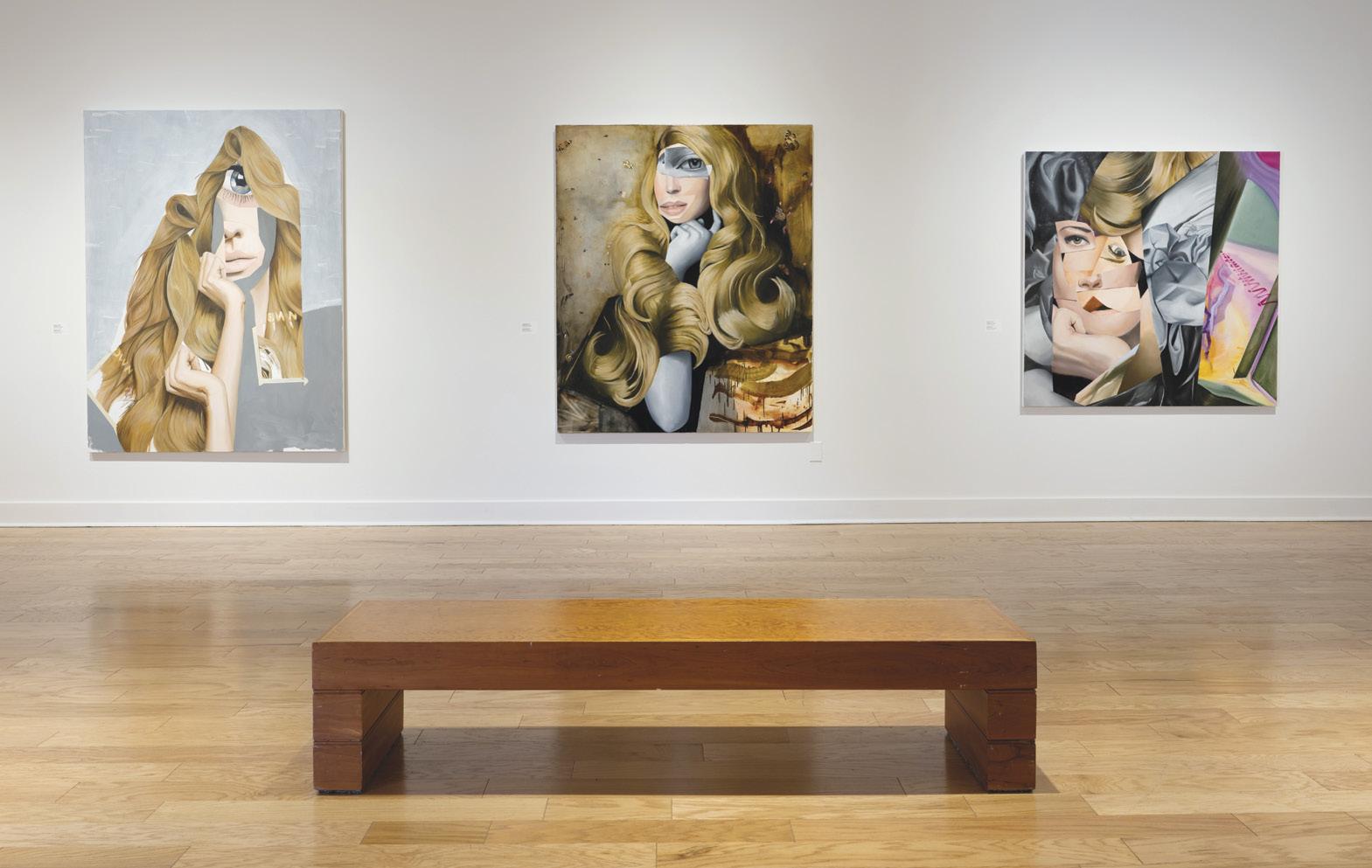
18 Art New England | March/April 2024
The other half of the exhibition includes an arrangement of Claudia Olds Goldie’s sculptures displayed on pedestals in the center of the room–allowing the viewer to circle them, experiencing their thoughtful intricacy from every angle. Particularly striking is Goldie’s Got the Bull by the Tail, though not large, it demands attention. Following the gaze of Got the Bull by the Tail across the room leads us to her other ceramic and stoneware sculptures. They feel lifelike as if these women have been pulled mid-action from their world to ours. Navigating between pedestals we see each woman from a new angle, watching their gazes cross paths with the viewer and the other artists across the room.
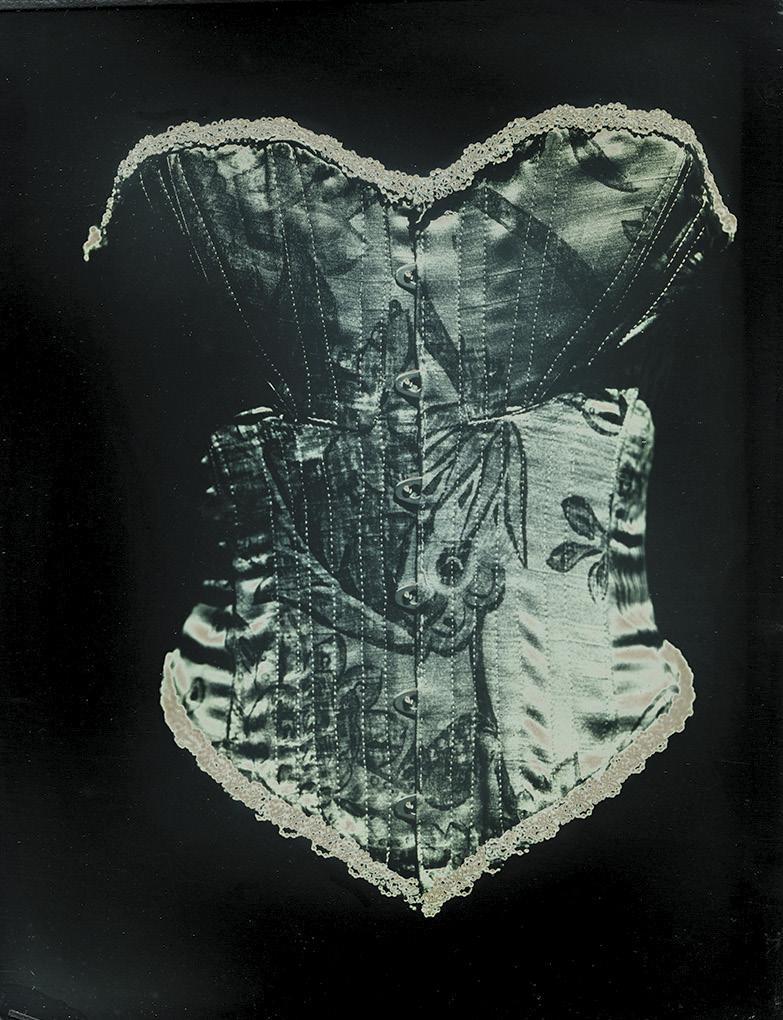
On the walls of this gallery are the works of Beal, Emami, and Moradkhani. Moradkhani’s drawings captivate with exceptional draughtsmanship. Fine colored pencil drawings, like ghosts on the page, show women’s clothes and the implications of their bodies emerging from the background. Reflecting on her own identity, as a woman born in Tehran and now living in the United States, the drawings embed political resistance and historical symbolism within layers of lacy detail referencing lingerie as prescribed markers of feminine sexuality. Hung alongside her drawings, plain, shapeless garments like boxy white dresses printed with reproductions of Moradkhani’s drawings drift and sway in the air as visitors pass, creating a profound experience as we move amidst the implied bodies. Standing in front of these works is Eve’s Quandary, Goldie, echoing the conflict-filled essence of Moradkhani’s work.
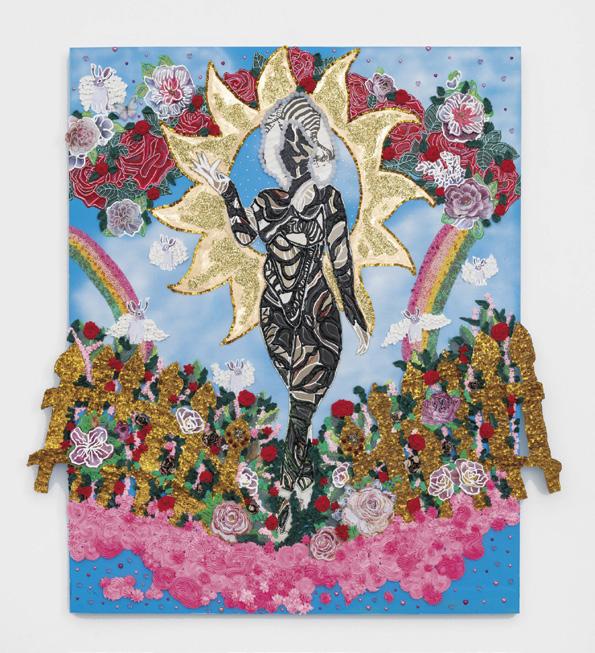
On Her Terms is a generous and expansive exhibition. Consuming two galleries and an intermediate space, the exhibition, paradoxically, contains vastness within its parameters. Incorporating an array of mediums and perspectives, the exhibition gives voice to the artists’ collective practices. Unconventional techniques support the diverse experiences represented. Not only did the curators conjure a powerhouse of artists, they also thoughtfully arranged the experience, allowing us to navigate the artwork with enough space to appreciate and consider. Moments like White’s Oculus (Violet, Pink, Light Grey, Lavender) and Oculus (Black, Brown, Royal, Blue, Purple, Lime) hung next to Leibana’s Sweetest Core allow us to identify and explore connections between each artist’s voice, creating a unified yet diverse response to expressions of femininity.
Abbi Kenny is a painter and writer from Boston. She is an MFA painting candidate at Boston University and received her BFA in painting with a minor in art history from RISD.


March/April 2024 | Art New England 19 OUTWIN BOOCHEVER PORTRAIT COMPETITION ART HIST OR Y SCIENC E SEUSS IN SPRINGFIEL D SpringfieldMuseums.org • Follow us THROUGH MAY 5 This exhibition has been organized by the Smithsonian’s National Portrait Gallery, Washington, D.C. Made possible through generous support from the Virginia Outwin Boochever Portrait Competition Endowment. Kyung’s Gift in Pojagi (From the series “Women in Possession of Good Fortune”); artist: Kira Nam Greene; oil, gouache, colored pencil, and acrylic ink on canvas; 2019; courtesy of Contemporary Art Matters © Kira Nam Green fitchburgartmuseum.org
By Deb Hemley
The Healing Power of Art
Since Art New England’s coverage of Massachusetts’ Arts on Prescription program in its January/February issue, Art Pharmacy has been engaged in discussions with health plans, laying the groundwork for the prescription of arts encounters in Massachusetts starting as early as spring 2024.
Simultaneously, they have been building a robust network of arts partners, with more than three hundred individuals, organizations, and teaching artists already on board. Art Pharmacy will deliver arts prescriptions through various creative experiences—visual, performing,
literary, and traditional art classes—and cultural encounters at community art centers, museums, and botanical gardens. They will also invite those interested in joining the Partner Network to visit the Arts & Culture Partners page on their website to complete the prequalification form, the first step in the registration process.
Art Pharmacy collaborates closely with its art partners to provide a comprehensive orientation, enhancing involvement, and fostering safe atmospheres for participants. The company manages logistical elements for art prescriptions, including ticket procurement, transporta-

tion assistance, necessary accommodations, and schedule reminders. Partners are encouraged to invest time in understanding individuals within the context of their engagement, facilitating the translation of acquired knowledge by inviting participants to articulate and reflect upon their experiences.
Although still in its infancy in Massachusetts, having been exclusively available in Georgia and California to date, Art Pharmacy’s approach draws inspiration from long-standing initiatives in other countries. In a recent conversation with Elisabeth Ioannides, education curator, and art therapist at the National Museum of Contemporary Art in Athens, Greece, she discussed their art psychotherapy program, “Exploring the Museum’s Images—Exploring My Image,” and other successful museum-based art therapy programs. These initiatives involve using carefully chosen artworks to explore issues like motherhood, gender, sexuality, isolation, abandonment, and distancing with participants. After experiencing a specific exhibition, participants return to the art workshop to create their own work and then discuss their creations. Notably, Ioannides highlights the therapeutic aspect of all artistic expression.
Ioannides is involved in the Arts on Prescription pilot program in Greece, slated to begin in spring 2024. In its pilot phase, the program will cater to mental health patients and later extend those living with cancer, Alzheimer’s, and other extend to those groups. Ioannides maintains an online repository—a rich resource of books, journals, and articles on art therapy in museum and gallery settings—on the ATMAG website, a special interest group for the British Association of Art Therapists.
In alignment with the spirit of Arts on Prescription, Art New England shifts its focus to the work of accomplished artist Yuko Adachi. Adachi has created an artistic sanctuary in the serene Blue Zone of Costa Rica, since her family’s relocation from Switzerland in 2021 with a desire to live a pura vida lifestyle. Adachi’s international upbringing spanned Tokyo, Paris, New York, and London. She graduated from Sophia University (Tokyo) and studied at Georgetown University. She received her second bachelor’s degree in fine
20 Art New England | March/April 2024
INSIGHTS
Above: Yuko Adachi, Universe Knows and Forgives, 2004, oil on canvas, 48 x 48 x 21/2". Opposite: Adachi holding a Lemurian Seed crystal at Playa Pelada in Nosara, Costa Rica. Courtesy of the artist.
arts from The Art Institute of Boston at Lesley University and studied at The School of the Museum of Fine Arts and Massachusetts College of Art and Design.
After many impactful public art shows, Adachi directed her creative intentions toward nurturing healing and inspiration. “Humans feel touched and moved when we see beauty in nature through colors and shapes. Although our human eyes don’t necessarily see vibrational auric fields, energetically we are able to absorb that through our eyes. I’m always fascinated by the abundance of nature and the unlimited information it provides as joy and strength, reminding us of its recycling power of life.”

Adachi’s artwork goes beyond being visually striking; with an intention to make viewers feel healing energy. Like Adachi herself, the paintings are inspiring and evoke a sense of awe. Healing Nature, a painting created to channel healing energy to her mother, won first prize in an international healing arts competition and also serves as a testament to Adachi’s belief in art as a conduit for positive energy. Adachi describes her
creative process as a connection to higher light, tapping into it and letting it guide her artistic expression.
In a parallel to the legacy of painter and mystic Hilma af Klint (Art New England reviewed the biopic Hilma in its July/August 2023 issue), Adachi attributes her work to a transcendent, channeled spirit. This ethos resonates within her art, as she speaks of receiving divine messages that she refers to as Visual Soul Medicine, incorporating light code activation—a concept she envisions integrating into our evolving artistic lexicon. Her home protection light code activations, conceived three years ago, seek to safeguard earthly homes with divine intent. Adachi’s Visual Soul Medicine endeavors to heal and ignite the inner light and unconditional love within her audience, empowering them to embrace personal power and spiritual connections. Adachi encourages viewers to immerse themselves in her artwork and envelop themselves in its protective aura—an invitation to embark on an artful, healing journey.
As Art Pharmacy expands its Arts on Pre-
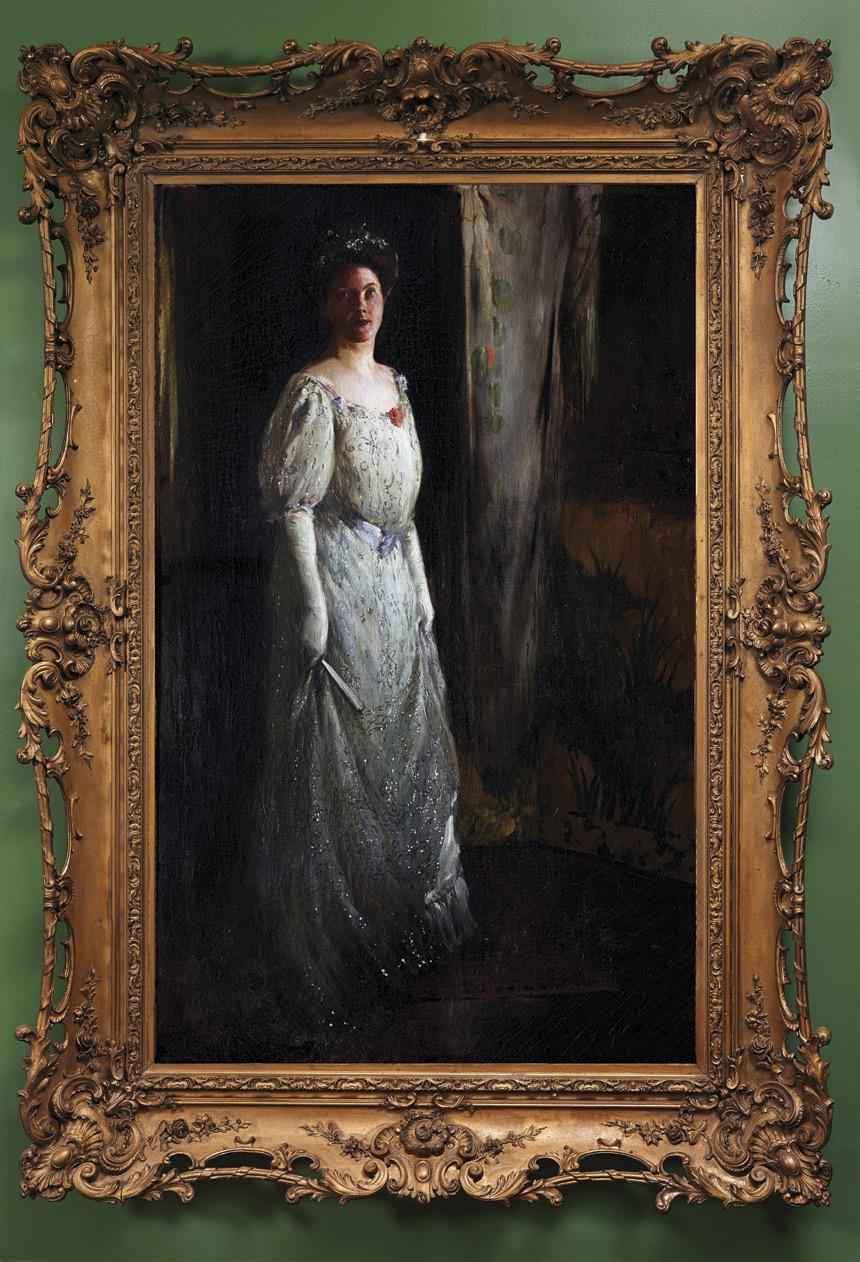
scription program in Massachusetts, Adachi’s work becomes emblematic of the transformative power of art in promoting well-being. This fusion of narratives underscores the potential for art to serve as a therapeutic prescription on multiple levels, generating healing and inspiration.
Artist Georgina Hooper’s advice in her book, Mindful Thoughts for Artists: Finding Flow & Creating Calm, encapsulates the heart of the process: “By slowing down and devoting time and attention to noticing your surroundings, you will see familiar things with a new perspective. Seeing mindfully is to see in greater detail, bringing a kind of joy and sense of discovery into the moment.”
Whether through established programs like Arts on Prescription or the visionary work of artists like Yuko Adachi, the convergence of art and well-being points to an exciting future where creativity becomes an integral part of our path to personal and collective healing.
Deb Hemley is a multimedia artist, writer, and the author of Wayfinding through Cancer: Creating a Healing Art Journal.
Exhibit featuring nearly 60 works by Golden Age Artist & Illustrator Eric Pape
Presented by Dr. Gregory Conn
Eric Pape, a former Annisquam resident and designer of the Tablet Rock Memorial in Gloucester’s Stage Fort Park, this exhibit marks a homecoming for this extraordinary collection from Pape’s extensive portfolio spanning his entire career, including rare examples of his society and celebrity portraits not publicly seen since his death. At the heart of this exhibition is the full-length portrait of Gertrude Cawein, painted by Pape in 1907 and loaned by the Filson Historical Society in Louisville, KY.

March/April 2024 | Art New England 21
artpharmacy.co puravidamagic.myshopify.com
80 Hesperus Avenue, Gloucester, MA 01930 hammondcastle.org
The proceeds from this exhibit will support the restoration and preservation of Hammond Castle Museum.
“Gertrude Cawein” by Eric Pape (1907) Oil on canvas 75”x52” framed
Gertrude Cawein at Hammond Castle Museum
April 5–April 28 10:00am–4:00pm Scan QR Code for more information & tickets! bit.ly/Gertrude-HCM
ON SCREEN
By Loren King
The Peasants
The phrase “labor of love” doesn’t even begin to describe the glorious achievement that is the Polish film The Peasants, the second hand-painted animated film from the husband-and-wife directing team of Hugh Welchman and D.K. Welchman
The filmmakers used a hand-painted animation technique for their groundbreaking debut, the Oscar-nominated animated feature Loving Vincent (2017) which brought the paintings of Vincent van Gogh to life. Yet where Loving Vincent was a quiet, meditative experience, The Peasants is a lusty, often brutal one; a visual and aural feast of rambunctious dancing, wild music, vodka drinking and secret sensual encounters.
The Welchmans adapted 1924 Nobel Laureate Wladislaw Reymont’s 1,000-page novel that spans the four seasons in its sweeping depiction of early 20thcentury Polish rural life.
Though the book is required reading in Poland’s schools, it’s not well known outside the country, as Hugh Welchman shared with this writer in an interview. He said that D.K., who is Polish, gave the book to him. “I’ve never read anything like it. The level of description; it gives you the gamut of human relations and problems. I grew up in rural Britain in the 1980s and I could relate. It felt universal,” he said. “We chose the book because it’s like a moving painting being described before your eyes. It’s heightened and impressionistic. We wanted to bring the prose to life like a painting. If you’re going to work with the slowest form of filmmaking ever invented, you have to have a really good reason to do it in that style rather than computer or live action which are much easier processes.”
jured stork she finds next to a river. Her mother forces Jagna into marriage to an older widower, the rich landowner Boryna (Miroslaw Baka). Yet Jagna secretly continues to see Antek (Robert Gulaczyk), her husband’s tempestuous married son as she struggles to maintain her own identity and independence in a small village where roles are rigidly defined by tradition and deep-rooted patriarchy. It’s clear that we’re headed for disaster; even so, there’s little to prepare the viewer for the depressing denouement when the villagers, male and female, turn on Jagna in
using oils. The painters duplicated 40,000 frames from the live-action shoot.
Welchman said the artists were inspired by realist and pre-Impressionist paintings, particularly the Young Poland movement, a modernist period roughly spanning the years from 1890–1918. The movement also included art and literature such as Reymont’s novel which was originally published between 1904 and 1909.
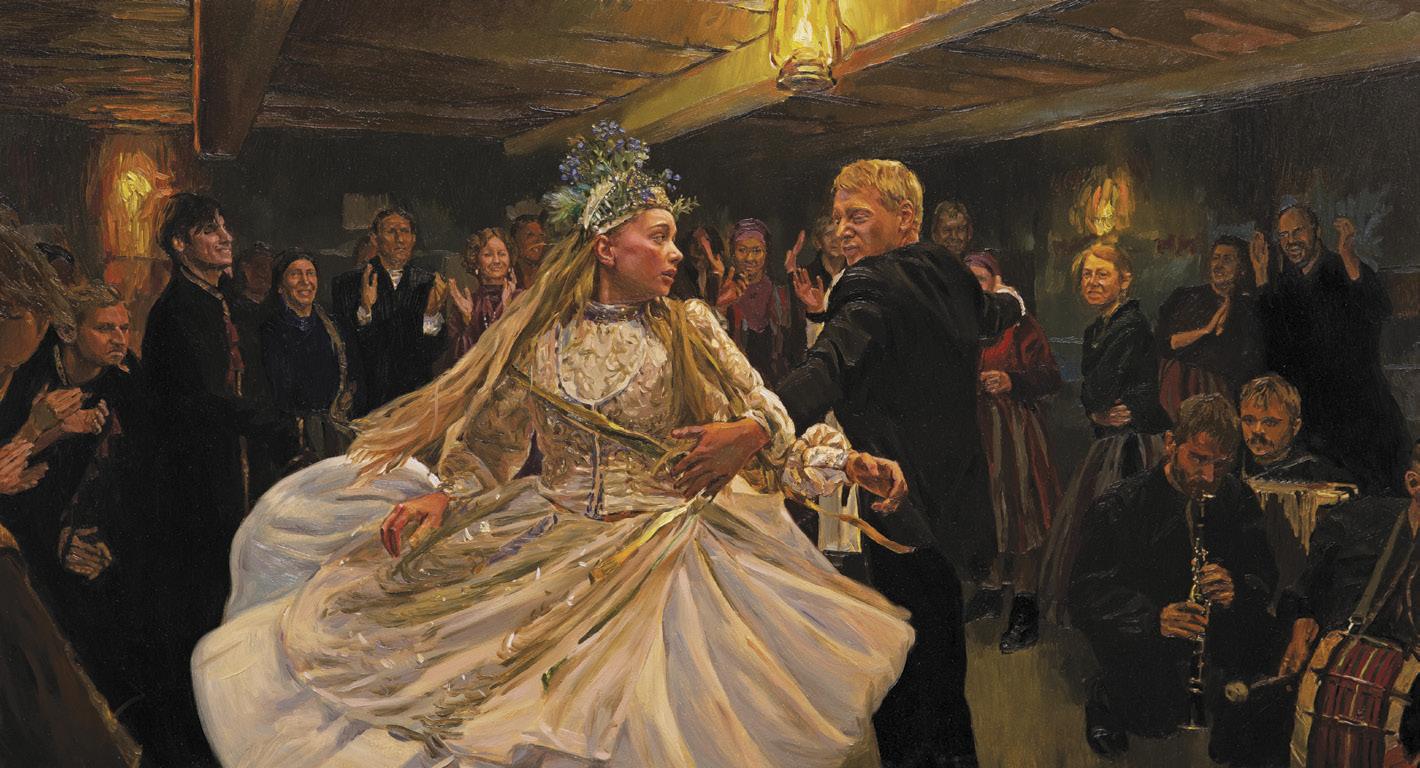
a violent attack. Punished for her sexuality and scapegoated for the woes that have beset the community, it is an upsetting scene that echos historical events such as the Salem witch trials and a similar wrenching scene in the epic film Ryan’s Daughter. Director David Lean’s influence can be seen in The Peasants.
Paintings by several Polish artists including Ferdynand Ruszczyc and Michal GorstkinWywiorski are replicated in the film. Jozef Chelmonski’s 1891 work Partridges in the Snow is entirely recreated in one breathtaking moment. Another Chelmonski work, Indian Summer comes to life in a scene where Jagna is lying in the grass dreamily playing with an airy strand of fiber. There are also visual allusions to French painter Jean-Francois Millet’s The Gleaners (1857). Some forty-five paintings are directly referenced while a file of four hundred artworks provided the artists with inspiration for the landscapes, clouds, sunsets and peasant portraits in the film.
The immersive story centers on Jagna (Kamila Urzędowska), a radiant, headstrong young woman who creates intricately refined paper cutouts and cares about animals such as the in-
To create the heightened reality that the painting technique renders, the filmmakers first shot a live-action film with the actors on a sound stage against green screen backdrops and cardboard sets. Then a team of approximately one hundred animators, led by head of animation Piotr Dominiak and working in studios located in Poland, Lithuania, Serbia and Ukraine, undertook the labor intensive task of hand-painting the footage onto canvas
Besides the alternately realistic and surreal animation, The Peasants rivals any feature this year in its cinematography, editing and score. It also has particular urgency for the present moment. In addition to depicting community divisions and mob mentality, the scapegoating and demonizing of women for their sexuality in the film has a chilling resonance. As Welchman put it, “How much have we moved on from nineteenth-century peasants?”
Entertainment journalist Loren King writes for many regional and national outlets. She is a member and past president of the Boston Society of Film Critics and a reviewing member of the Alliance of Women Film Journalists.
22 Art New England | March/April 2024
Above: A still from The Peasants. Photo: Malgorzata Kuznik/Courtesy of Sony Pictures Classics.
Nancy Elizabeth Prophet I Will Not
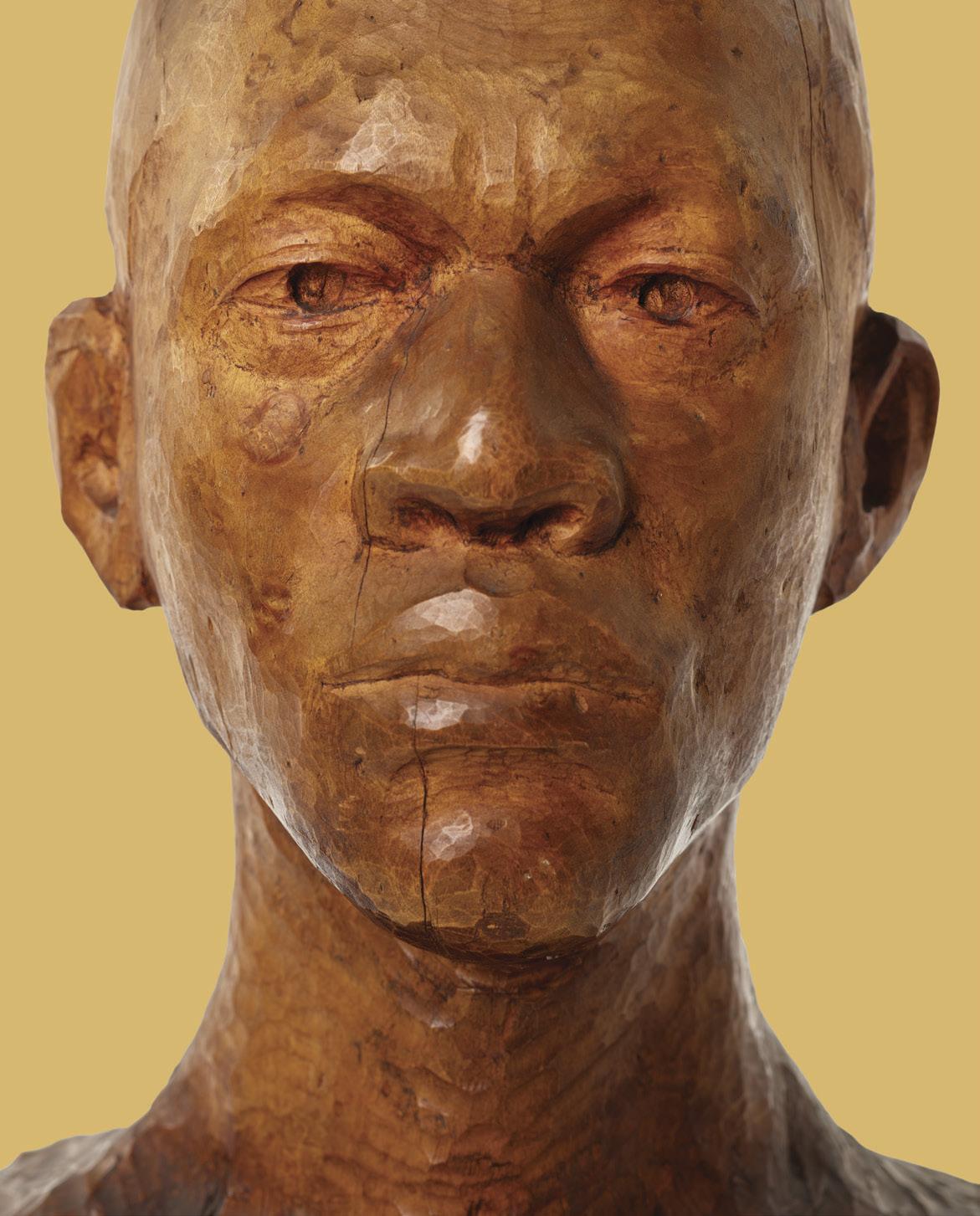




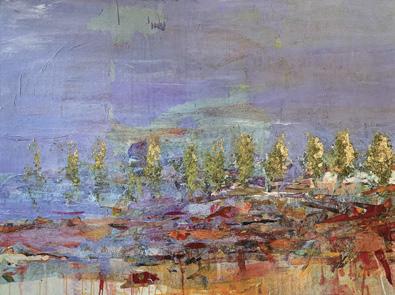
March/April 2024 | Art New England 23
Bend
Inch ON VIEW THROUGH AUG 4, 2024
an
Free Sundays
Nancy Elizabeth Prophet, Negro Head , before 1927. Gift of Miss Eleanor B. Green.
By Jennifer Mancuso
Aerosol: Part I
By definition, graffiti represents an urban artform dating back to the late 1960s.
To the youth who tagged subways and buildings, the expression exemplifies a time when means and materials were in short demand for a creative kid living in the city. A genre built from Black and Latino cultures, the rise of graffiti or “tagging” corresponded with the birth of Hip-Hop and its five tenets: beat boxing, emceeing, deejaying, and break dancing, with graffiti being the visual component. Following Hip-Hop’s fiftieth anniversary in 2023, the celebratory concerts and performances extended into the arts with many creatives honoring their old school heroes. Boston artists, now grown, reflect on how graffiti introduced them to a medium that would mark their paths.
The fundamentals of graffiti, anonymity to the general public, are removed when placed on a canvas with a signature. “The goal of graffiti is to do what you’re not supposed to do,” says Tommy “Kwest” Burns. Kwest is a native of Boston’s
Dorchester neighborhood and an artist who was heavily influenced by the early graffiti movement. As a youth, he remembers “The El,” the elevated train which ran from Forest Hills in Jamaica Plain along Washington Street in the South End. He lived through the Boston Busing Crisis and White Flight—the integration of the city’s public schools and its consequences when white middle class families moved out. This along with redlining, the practice of assigning higher mortgages to Black and Brown communities, changed the landscape of the city. All things Kwest considers factors in the city’s graffiti movement. “In certain areas of the city that were dilapidated, we could get away with it a little more. Other areas were tagged under the cover of night,” says the artist.

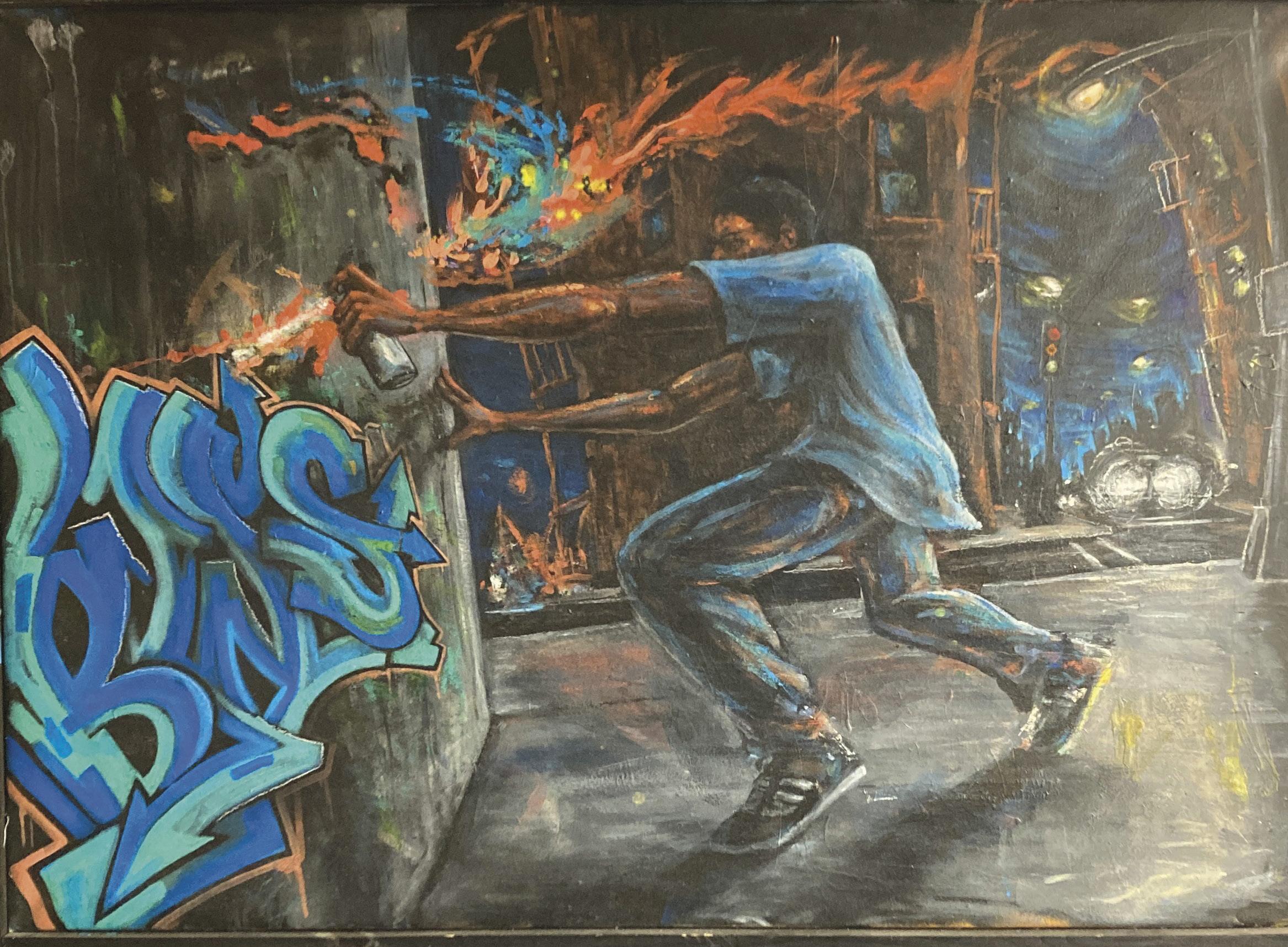
Graffiti began as a form of resistance. From the ancient Romans to a slave rebellion in Cuba, graffitists have been using public walls to convey messages of social justice in an expressive, creative artform. Now often written with shoe polish, markers, and spray paint, tagging puts the words of the marginalized on display for the public to view and further antagonizes societal norms. “The world was against us, and what did we have? We had our names,” says Kwest. Vandalizing a building is a rebellious act against the system. Further, the young taggers used their art as a calling card. “It’s like the Batman signal,” says Kwest. Tagging is about prominence.
Like Hip-Hop, graffiti shares its roots with New York’s underground scene which, quite literally, flourished underground. A subway station provided privacy for artists while a subway or tunnel wall provided exposure for their ‘burners’, defined as a more elaborate complex piece while a ‘throw up’ is much quicker. “Boston doesn’t have as many trains as New York, so we were restricted in the southside of Dorchester, Roxbury, Mattapan, and South End,” says Kwest.
24 Art New England | March/April 2024
THEN & NOW
Above: Tommy “Kwest” Burns, Midnight Marauder #1, 2020, acrylic, 16 x 20". Below: Tommy “Kwest” Burns, Midnight Marauder #2, 2020, acrylic, 36 x 54". Images courtesy of the artist.
Puerto Rican born, George Lee Quiñones, painted entire New York subway cars with his murals in 1976 which went on to survive for up to a year before being ‘buffed’ or repainted. Quiñones was featured in Wild Style, the 1982 film celebrated as Hip-Hop’s first documentary which follows the early pioneers of rap within New York’s subculture exploring its music, dance, and art. The film brought street art into the mainstream and in turn elevated graffiti artists such as Jean-Michel Basquiat, Keith Haring, and others as a way to divert the street style of graffiti onto the canvas. Yet, tagging a canvas and hanging it in a museum or gallery diminishes the intent of it. “It’s not graffiti anymore,” says Kwest. “It becomes an artform inspired by graffiti or aerosol art,” the artist says. “Graffiti is bombing the city.” The soundtrack from Wild Style went on to be sampled by over a dozen contemporary rap artists.
From his tagging roots, Kwest has developed into a painter and muralist. Often his subject matter stems from the days when himself and others lacked access. “You don’t have your own gallery. You don’t have your own art supplies. You don’t have many things available to you so you make those things,” says Kwest. In his series, Midnight Marauders, a borrowed title from the Hip-Hop group A Tribe Called Quest, the artist
portrays two graffitists, each in action under a night sky. In the first of the paintings, the face of the tagger is shadowed while the swirl from his spray can feels as if it is in motion. The second painting portrays a young man using aerosol to leave his tag on a cement wall. Both pieces illustrate the drabness of a city’s landscape. “It’s metal, wires, steel, and bricks against the natural world,” says Kwest. “A little bit of spray can make it beautiful.” The painter solely uses acrylic on his canvases and includes beat boxers and break dancers in his body of work. To further evidence the braid of Hip-Hop and art, Midnight Marauders was one of the albums sampled from the Wild Style soundtrack.
Graffiti would go on to shape not only Kwest’s art practice but also his community. His close friends include Ricardo “Deme5” Gomez, Rob Stull, Rob “ProBlak” Gibbs, Shea Justice, Cedric “Vise1” Douglas, and more. All artists who came up under the same conditions as Kwest, practicing their skill on a canvas that wasn’t theirs to make a mark on a city that was. “We were products of our environment. We wandered throughout the streets to find what would ultimately be prominent and showcase what we were doing, our own galleries,” says Kwest. All the while, Hip-Hop was the backdrop to their art, bleeding into their practice.

With its resurgence coinciding with Hip-Hop’s anniversary and fashion designers resurrecting ‘90s fashion, graffiti has gained popularity for art collectors. Commodified and consumed outside of its original purpose, graffiti is different from when Kwest and his counterparts first engaged in the practice. The city has also changed, affording more opportunities to young makers while community art projects have created career paths for former graffiti artists.
“Just as Hip-Hop began getting played on the radio stations, the city embraced graffiti through murals. In its truest form, [graffiti] is not embraced,” says Kwest. “There is still a stigma.”
In the second installment of this five-part series, the conversation intersects graffiti with Boston’s past and its booming development. Kwest introduces his artist crew to discuss tagging’s evolution and influence on other artforms. The medium’s evolution into community and public art traces many of Boston’s prominent muralists’ start as graffiti writers, as in the case of Kwest, Deme5, and ProBlak while Stull is an accomplished illustrator.
Jennifer Mancuso holds her MFA in writing from the New Hampshire Institute of Art. The writer is completing a set of novels based on her experience growing up biracial while passing.

March/April 2024 | Art New England 25
w THE INTIMACY OF SEEING ELSA VOELCKER - A RETROSPECTIVE Alva de Mars Megan Chapel Art Center At top: Dupioni, 2015. digital print. 16 x 21 �⁄�”
(detail)
Above: Conrad, 2004. gelatin silver print. 14 x11”
On view March 7–April 19, 2024 GALLERY HOURS Tuesday–Saturday 10 a.m. – 4 p.m. Thursday 10 a.m. – 7 p.m. Sunday & Monday Closed The gallery will be closed in observance of the Saint Anselm College Easter Recess from Thursday, March 28 through Monday, April 1. Please visit our website: www.anselm.edu/chapel-art
Images courtesy of the artist
By Cynthia Close
Andy Warhol and The Hall Art Foundation in Winter
Most visitors stroll the sculpture dotted hills and fields of The Hall Art Foundation, located in rural Reading, Vermont, in early spring to fall yet this writer found herself standing at the entrance to their visitor center on a sunny, bitter cold Sunday morning in late January of this year. The Hall first explored opening one gallery in the farmhouse/reception center on weekends during winter 2023 and it proved popular, along with the hot chocolate and other light fare available in the small, pleasant, light-filled cafe. The Foundation decided to expand the experiment this year, and a small group of us enjoyed the two-hour scenic route from Burlington to view the current Warhol - Small Works exhibition in the galleries.
Given its largely rural landscape and low population density, Vermont offers few opportunities to experience a high-profile, iconic contemporary artist like Andy Warhol, making this exhibition of over one hundred works spanning Warhol’s career a must-see event. Thanks to
important collectors of contemporary art like Andrew and Christine Hall, who have chosen to form non-profit institutions making their private collections public, Vermont has become more of a destination for art lovers both inside and outside the state. Founded in 2007, The Hall Art Foundation maintains two museum quality exhibition spaces; one here in Vermont, and the other near Hanover, Germany where Kunstmuseum Schloss Derneburg stands as a cultural landmark on top of a history stretching back over a thousand years. The Halls acquired Schloss Derneburg in 2006 from the German artist Georg Baselitz (b.1938-). He had used it as his studio and primary residence for more than thirty years. Along with these exhibition spaces the Halls also maintain a permanent installation of Anselm Kiefer’s work in a massive 10,000 square-foot building at MASS MoCA in North Adams, Massachusetts.

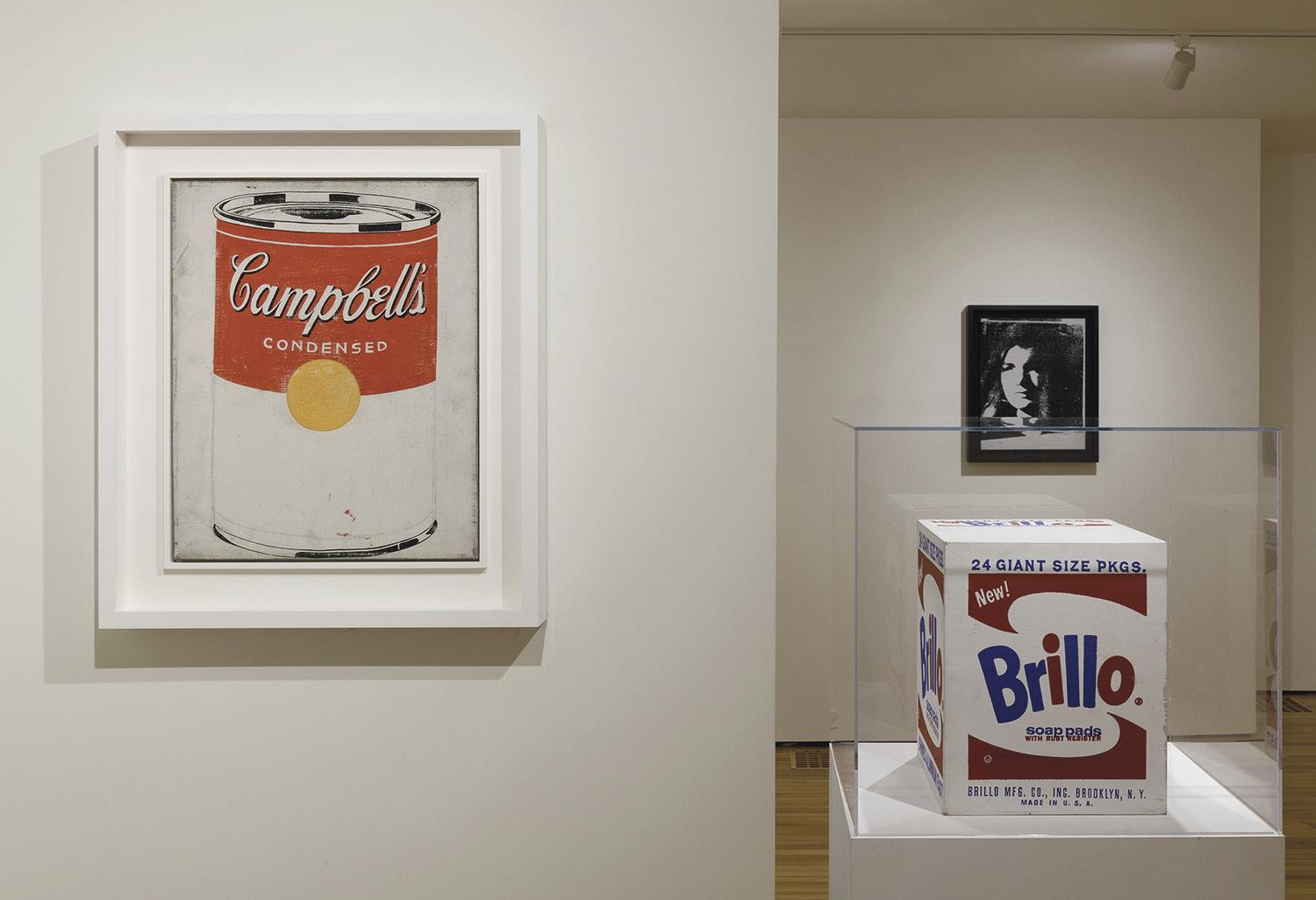
Smaller than the MASS MoCA site by 4,000 square feet, the interior space in Vermont consists of a 19th century stone farmhouse and three barns, surrounded by four hundred acres of fields, woodlands, and pastures. It had been the former Lexington Dairy Farm. Opened in 2012 after extensive renovation, the exterior of the buildings remain true to their historic character. The “snecked ashlar” stone siding of the farmhouse is relatively unique to this area of Vermont. In 2013, Architectural Digest named Hall Vermont as one of the “Must-See Museums Opened by Collectors Around the World.”
The farmhouse and barns are located on a picturesque site next to a waterfall on a tributary of the Black River which has proven to be challenging. Vermont recently faced extensive flooding due to climate change. The Hall Foundation was not immune. The extensive July 2023 Vermont floods forced a curtailed exhibition season while repairs were made. We observed a newly constructed concrete berm edging the road between
26 Art New England | March/April 2024
EXHIBITIONS
Above: The exterior of The Hall Art Foundation in winter. Courtesy of the museum. Below: Installation view featuring Campbell's Soup Can, 1961, casein and pencil on canvas, 20 x 16". Hall Collection; Brillo Soap Pads Box, 1964, synthetic polymer paint on wood, 17 x 17 x 14". Hall Collection. Jackie, 1964, acrylic and silkscreen ink on linen, 20 x 16". Hall Collection. All images courtesy Hall Art Foundation.

the farmhouse on one side and the barn/galleries on the other. Hall Foundation docent and tour guide Susan Piccoli explained, “The wall is part of our flood mitigation renovations and will be faced with the same indigenous stone siding as the farmhouse as soon as the weather allows.”
The more than one hundred works shown come from the Hall collection. During a May interview on Vermont Public, Foundation director Maryse Brand commented, “Although, there have been many Warhol exhibitions where there are large-scale works—I could be wrong, and I would be happy to be corrected—but I think this is the largest exhibition of Warhol paintings to have ever taken place in Vermont. I also think it’s one of the very few Warhol retrospectives to have taken place in the northeast in the last ten or twenty years.”
By choosing to install these small scale works in the low-ceilinged spaces of the 18th century farmhouses, rather than the expansive barn/galleries, allows the viewers to have a more intimate experience with the art. Warhol is often thought of as primarily a printmaker, a manufacturer of mass produced works that were an integral part of the capitalist pop culture they exemplified. The Hall refers to these two-dimensional works as
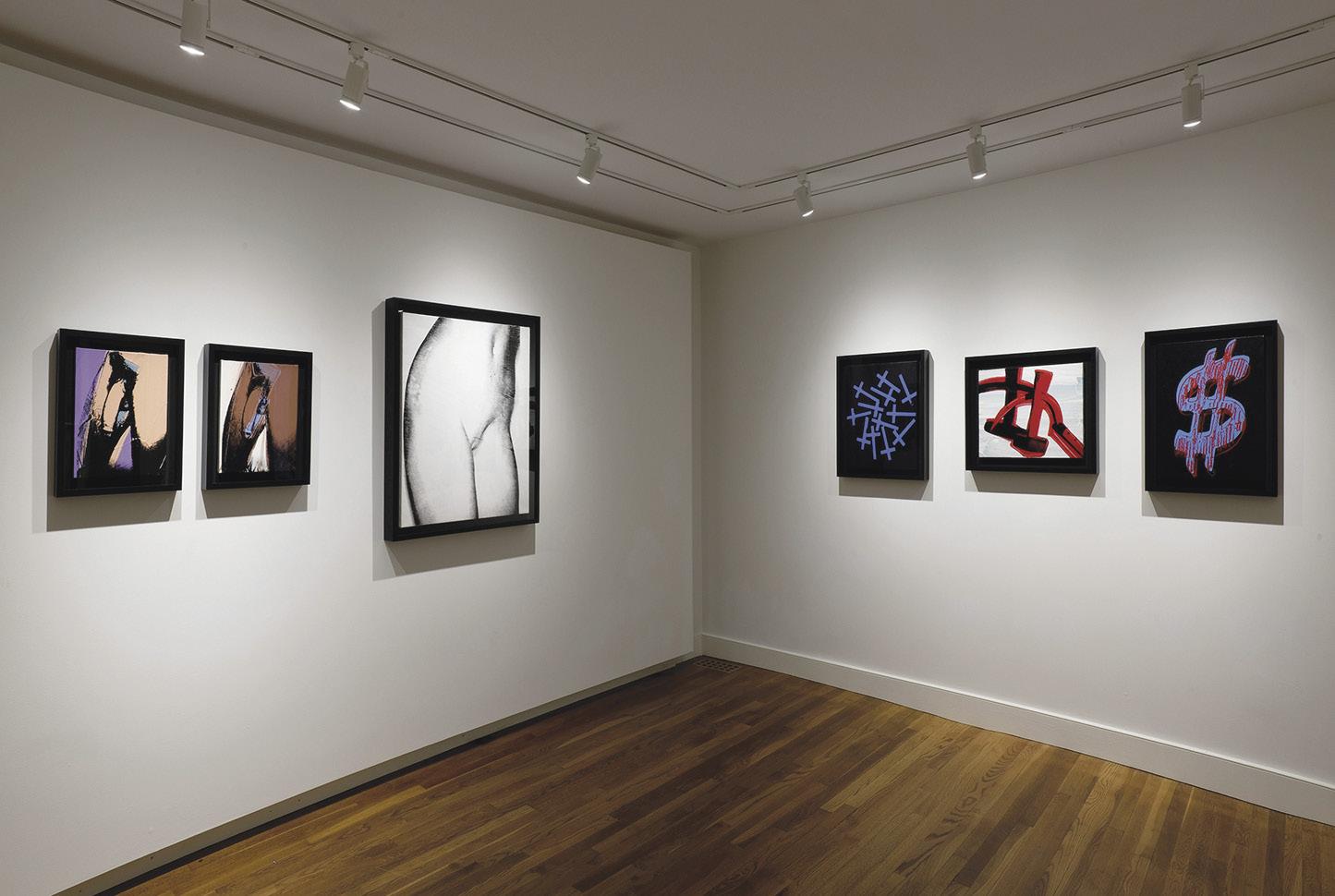
“paintings.” While the original source material is usually a photograph transformed via a process of silk-screen printing on canvas, every piece also bares the marks of the human hand; pencil marks, strokes of paint, added at some point in the process.
The show was organized chronologically starting with hand-drawn dollar bills from 1960–61 before Warhol began working with silkscreens. A single Campbell’s Soup Can print looks familiar, hung next to a single Brillo Box sculpture. We’re used to seeing piles of Brillo boxes stacked in front of wall-sized displays of Warhol’s Campbell’s soup can prints. Being able to focus on small works, framed individually, allowed us to “see” Warhol for the first time.
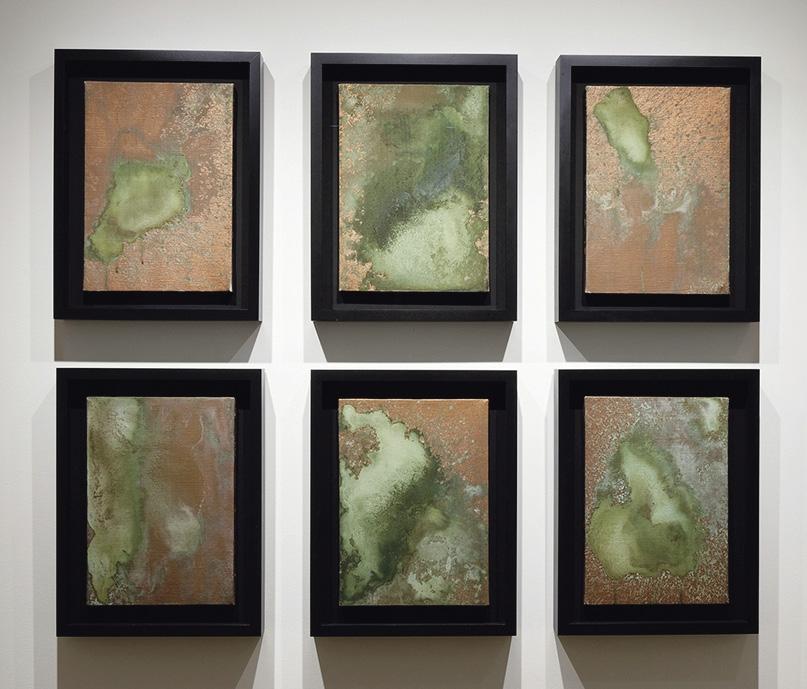
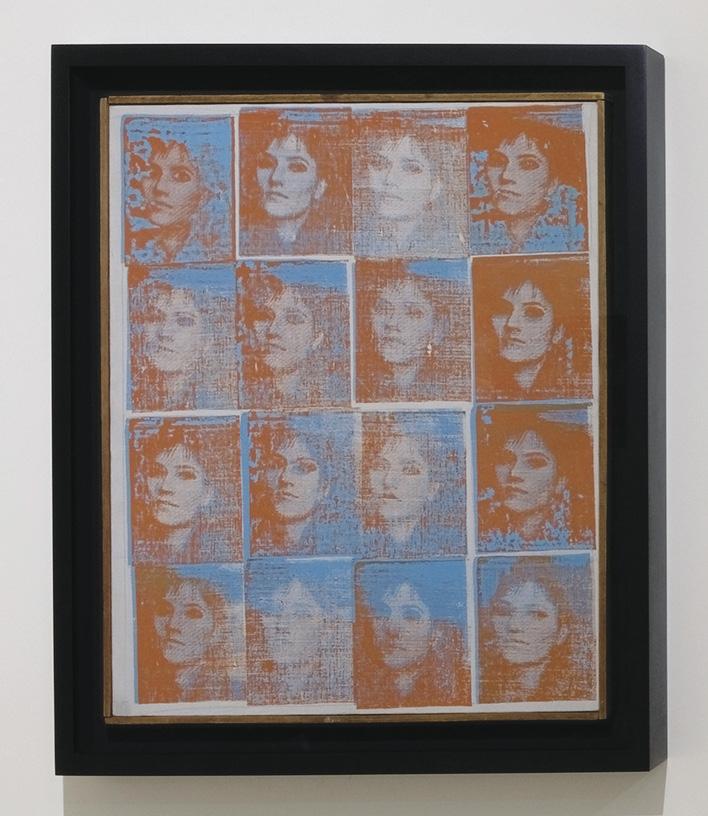
5 Deaths, a stark, black, and very dark red piece from 1963 featuring an overturned car in a gruesome scenario, exemplifies the underlying disquiet in Warhol’s oeuvre.
Rather than deference to his subjects, Warhol’s portraits exhibit a pervasive laconic insolence. Many of them were commissions. One of his earliest was of Patty Oldenburg, who was married to 1960s Pop sculptor Claes Oldenburg. It is a stereoscopic piece, and our tour guide handed us 3D glasses to view the work. Oldenburg is now
a Vermont resident in her 80s and goes by her maiden name of Patty Mucha. She attended the opening. This was only one of many revelations like discovering Warhol’s exploration of abstraction in the late 1970s and 80s with the Shadow Series and the Oxidation Series. The iridescent yellows and greens in the Oxidations were created not by paint, but by Warhol and other invited friends peeing on a copper coated surface. Sex Parts, prints of penises, were never exhibited in his lifetime.
The Halls have chosen not to post wall texts in any of their exhibitions, allowing viewers to discover the artwork on their own terms. There are binders that include supplemental information in each of the galleries for those who are interested. As we emerged from the exhibition the sun sparkled on the snow-covered ground transforming Terence Koh’s 2011 Children of the Corn, Totem Pole into a shimmering specter, waiting for spring.
Cynthia Close is contributing editor for Documentary Magazine and writes regularly for Art New England and several other publications.
hallartfoundation.org
March/April 2024 | Art New England 27
Above, left: Installation view featuring two paintings titled Detail of the Last Supper, 1986, Christ $9.98 (Positive) and Christ $9.98 (Negative), 1985–86, Heaven and Hell are Just One Breath Away (Positive) and Heaven and Hell are Just One Breath Away (Negative), 1985–86; New York Post Marine Death Toll Hits 172, 1983. Above, right: Installation view featuring Nude model (male) from the series Torsos/Sex Parts (1977); Torso (1976–77), Torso (1977); Crosses (1981–82); Hammer and Sickle (1976); Dollar Sign (1981). Below, from top: Untitled (Oxidation Painting), 1978, six works, mixed media on canvas, 14 x 10"; Patty Oldenburg, 1962, silkscreen ink, acrylic, and pencil on linen, 21 x 18". Hall Collection. Courtesy of Hall Art Foundation.
Calendar
Compiled by Autumn Duke
1.
CULTURAL EVENTS OF NOTE

MARCH
1. Lecture
Sedimental: What Moves Us?
March 21, 5:30–7 p.m.
Doors open at 5 p.m. for complimentary snacks, beer and wine. Award-winning artist and researcher Nina Elder discusses her scientific and artistic methods, as well as her site-specific project Sedimental, an experimental multi-media exploration of coastal sand formation and erosion. This event is part of Norman Bird Sanctuary’s 75th Anniversary Lecture Series, Sightlines. The lecture marks the beginning of Elder’s artist residency at the sanctuary. Her residency closes on April 6 with a free, participatory art installation open to the public. Norman Bird Sanctuary,
10.
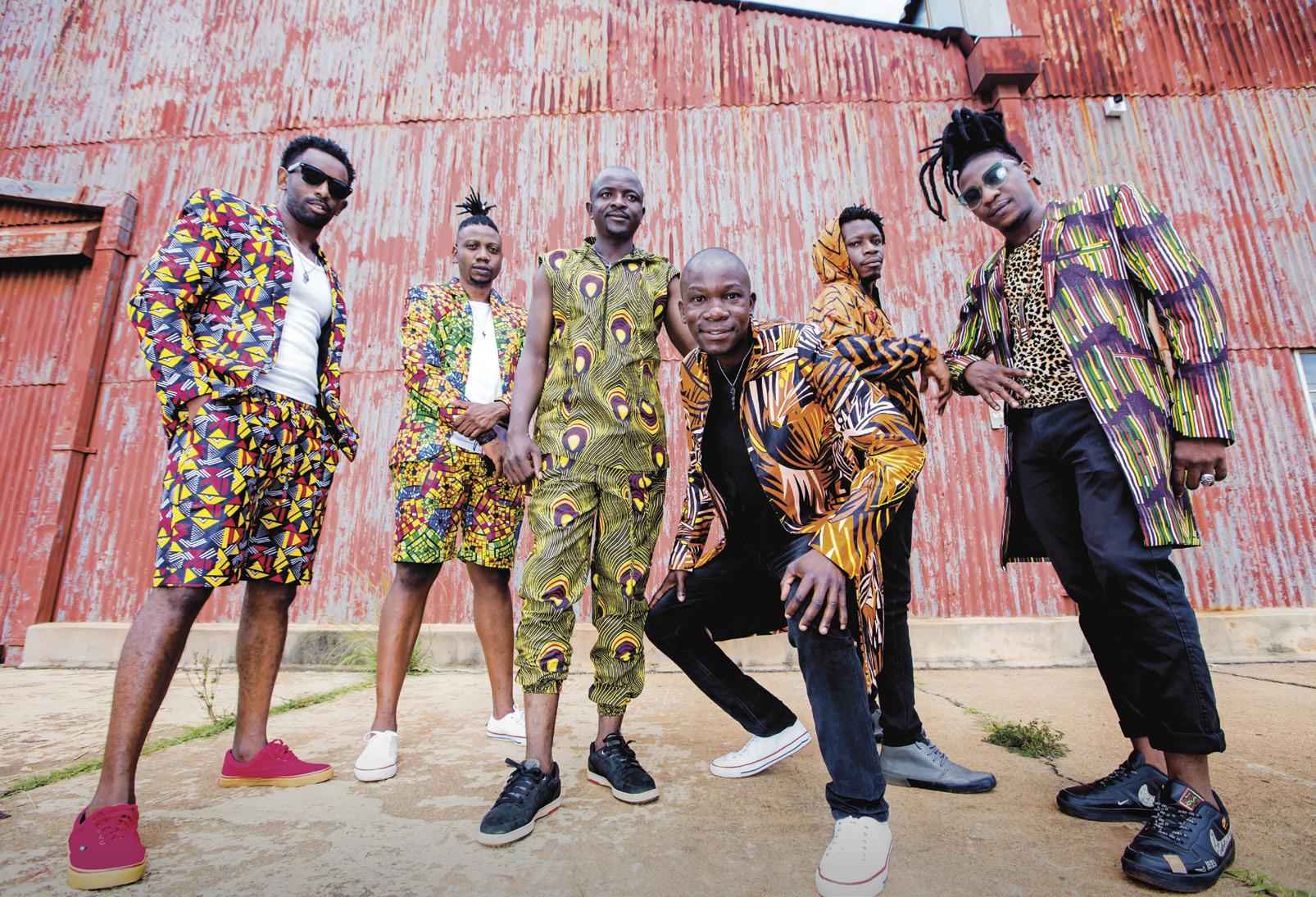
MARCH/APRIL 2024
583 Third Beach Rd., Middletown, RI, normanbirdsanctuary.org
2. Lecture
Gwen Strahle
March 27, 12–1:30 p.m.
Gwen Strahle discusses her work and artistic process. Strahle is a painter and educator based in northeast Connecticut. She earned her Master of Fine Arts from Yale University and currently works as an assistant professor at Rhode Island School of Design. Strahle has been awarded such honors as The Connecticut Artist Fellowship, the Childe Hassam Purchase Prize from the American Academy of Arts and Letters and The Guggenheim Fellowship. Massachusetts College of Art and Design, Design and Media Center, 621 Huntington Ave., Boston, MA, calendar.massart.edu
3. Lecture
The Narrativization of Glamour in Film Noir March 28, 5–6 p.m.
Professor Patrick Keating of Trinity University discusses the narrativization of glamour in film noir in this John Kobal Foundation Collection Lecture. In this lecture, he explores how film in the 1940s borrowed from 1930s glamour photography and redefined glamour in narrative terms as the culmination of a transformation. Keating is a film studies and communications professor. His most recent publication is The Dynamic Frame: Camera Movement in Classical Hollywood Cinema. Hood Museum of Art at Dartmouth College, 6 E Wheelock St., Hanover, NH, hoodmuseum.dartmouth.edu
4. Lecture/Concert
Mahsa and Marjan Vahdat
March 29, 12 p.m. & March 31, 3 p.m.
This two-part event series is free and open to the public. On March 29, sisters Mahsa and Marjan Vahdat discuss their lives and work in a lecture. On March 31, join these Iranian-born vocalists, composers and cultural activists in a performance presented jointly by Smith College and UMass Fine Art Center. The Vahdat sisters utilize Persian classical and regional vocal traditions in their performance work.
University of Massachusetts
Amherst, Randolph W. Bromery Center for the Arts, 151 Presidents Dr., Amherst, MA, fac.amherst.edu; Smith College, Sweeney Concert Hall, 51 College Ln., Northampton, MA, smith.edu
28 Art New England | March/April 2024
5. Artist Talk
Stanwyck Cromwell and Marlon Forrester
March 31, 12:30–3:30 p.m.
This discussion between two generations of Guyanese/American artists, Stanwyck Cromwell and Marlon Forrester, is moderated by Andre Rochester. Cromwell is a second-generation visual artist and adjunct art professor at Capital Community College in Hartford, CT. Forrester is a Boston-based artist and educator currently serving as a resident artist at the AfricanAmerican Masters Artist Residency Program adjunct to the department of African-American studies in association with Northeastern University. Rochester is a fine artist with a multitude of accolades and roles in the arts and cultural communities in Greater Hartford.
Ely Center of Contemporary Art, 51 Trumbull St., New Haven, CT, elycenter.org
6. Critique
Artist Social and Critique
March 14 & April 11, 6–8 p.m.
Bring one to two pieces or images of artwork to this monthly meet-up and critique. Held on second Thursdays, this event is open to local artists over the age of fourteen. It is a safe space for constructive feedback with fellow artists of all ages, abilities and mediums. The Artist Social and Critiques are hosted by artist Nayana LaFond (Art New England ’s cover artist, January/February 2024).
The Mill District Local Art Gallery, 91 Cowls Rd., Amherst, MA, generalstorelocalgallery.com
7. Art Making
Explora
March 16 & April 20, 2–6 p.m.
This casual drop-in open studio event is hosted one Saturday each month at atac. Explora is open to all ages and skill levels. Artists and makers may bring their own supplies yet are welcome to use atac’s updated library of materials, tools and resources. Staff are on hand to show newcomers around the space. RSVP is encouraged yet not required.
atac, 160 Hollis St., Framingham, MA, atac160.org
APRIL
8. Workshop
Artist WorkLab:
Getting Started in Public Art
April 3, 5:30–7:30 p.m.
Join fellow creatives in this free collaborative workshop series held on first Wednesdays at Metro Art Studios, presented in partnership with Cultural Alliance of Fairfield County. Share concerns, ask questions and learn about building a career as an artist or maker. Resources, notes and videos are posted to Metro Art Studios’ website after each workshop.
Metro Art Studios, 345 Railroad Ave., Bridgeport, CT, metroartstudios.org
9. Poetry Reading
Mary-Alice Daniel and Cindy Juyoung Ok
April 3, 7–8 p.m.
Mary-Alice Daniel and Cindy Juyoung Ok read from their respective bodies of work. Daniel is a Nigerian-American writer and poet. Ok is a writer, translator, and educator and editor of poetry. Daniel and Ok both received the Yale Series of Younger Poets Prize for their debut collections, in 2022 and 2023, respectively. This event is part of Bennington College’s Poetry at Bennington series.
Bennington College, Tishman Lecture Hall, 1 College Dr., Bennington, VT, bennington.edu
10. Concert
Mokoomba
April 5, 7:30 p.m.
Mokoomba, a six-man group from Victoria Falls, Zimbabwe, has performed in over forty countries and at many prestigious venues and festivals, such as New York City’s Apollo Theater and New Orleans Jazz. The group integrates multiple languages and a variety of international pop and pan-African styles into their music. This event is part of the Visiting Artist Series and Ernest Brown Music Series presented by the Williams College Department of Music. Williams College, Chapin Hall, 880 Main St., Williamstown, MA, events.williams.edu
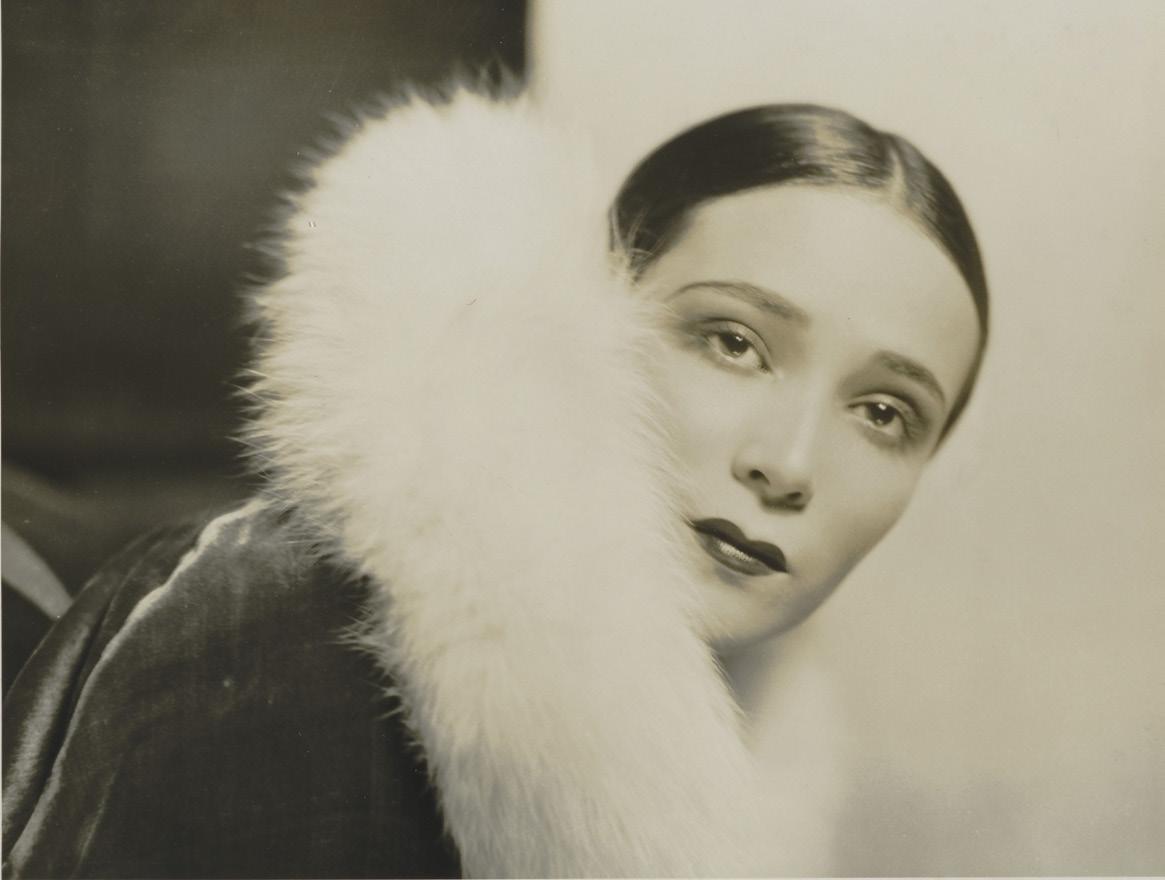
11. Lecture
Marc Chagall: Joy, Color & a Celebration of Jewish Culture
April 8, 6–7 p.m.
This event is the third and final part of the Celebrating Cultural Heritage through Art lecture series. Marc Chagall was an early modernist whose colorful, abstract work incorporates Jewish themes that reflect his cultural heritage. The lecture explores Chagall’s personal and professional lives. Jane Oneail, art historian and educator, presents. This event is virtual and free with registration.
Mystic & Noank Library, mysticnoank.librarycalendar.com
12. Workshop
Drawing Party: Alois Süssmayr, “Studies of Figures and Two Female Heads”
April 18, 7–9 p.m.
Museum educator Kate Wellen leads this relaxing art tutorial held in Fairfield University’s Bellarmine Hall Galleries and SmArt Classroom. This event is free and open to the public, with art supplies provided onsite. This “drawing party” is inspired by Alois Süssmayr’s Studies of Figures and Two Female Heads (detail), c. 19th century, pencil on paper.
Fairfield University Art Museum, Bellarmine Hall, 200 Barlow Rd., Fairfield, CT, events.fairfield.edu
13. Lecture
Shirin Neshat
April 18, 4 p.m.
Shirin Neshat gives the annual Pembroke Public Lecture, hosted by feminist research center The Pembroke Center. Neshat is a widely exhibited and awarded Iranianborn, New York-based artist and filmmaker. She has directed three feature-length films: Women Without Men (2009), winner of the Silver Lion Award for Best Director at the 66th Venice International Film Festival, Looking for Oum Kulthum (2017) and most recently Land of Dreams (2021).
Brown University, Pembroke Hall, 172 Meeting St., Providence, RI, events.brown.edu
14. Gallery Talks
Collection Stories
March 29, April 5 & April 26, 6 p.m.
Join museum staff for this series of gallery tours and lectures surrounding the topic of the collections at the Portland Museum of Art (PMA). On March 29, assistant curator of modern and contemporary art Sayantan Makhopadhyay discusses the works in PMA’s +collection.
Judy and Leonard Lauder Director of the Portland Museum of Art Mark Bessire discusses PMA’s collection on April 5. On April 26, chief preparator Krik Hoffman discusses the care of permanent collection artworks. These events occur on PMA’s Free Fridays.
Portland Museum of Art, 7 Congress Sq., Portland, ME, portlandmuseum.org
March/April 2024 | Art New England 29
3.
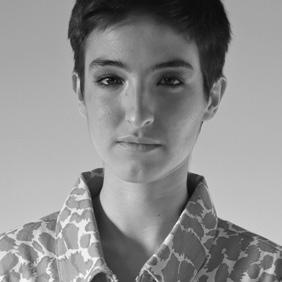
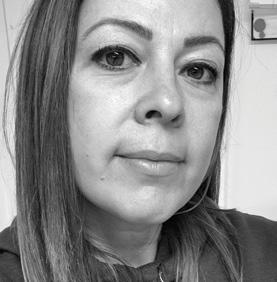
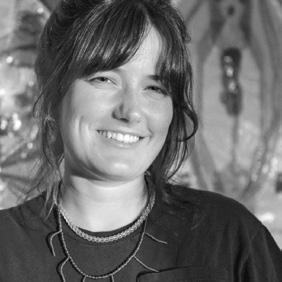
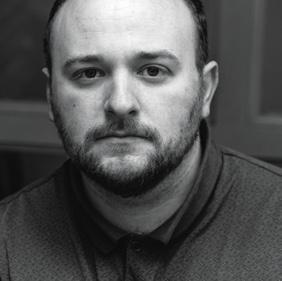
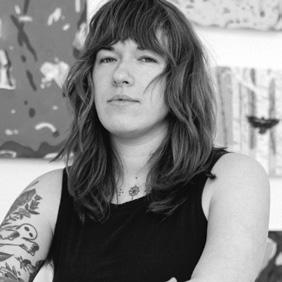
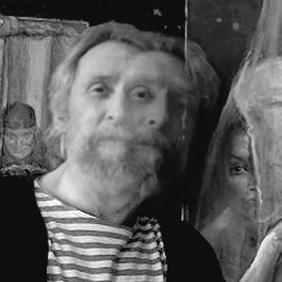

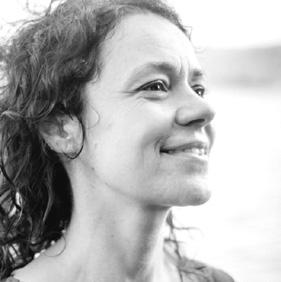


Emerging New England Artists
Art New England ’s Annual Highlight of Ten Exceptional Emerging Voices
The Emerging Artist feature is one of Art New England’s most impactful traditions. After reading this year’s interviews and nominator statements, it’s tempting to change the name of the feature to Soaring Artists. Several actually do soar through dance and movement. Others soar through their brushstrokes, poetry, sculpture, and printmaking. Each year we marvel at how much we learn from these voices and how much bigger the world seems. And when has it ever been more important to soar when we live in a world of such heaviness and grief. Through the eyes and hands and words of these ten artists—as well as through the passion of their nominators—we are offered the gift of fresh perspectives, fascinating thought-processes, and outrageous hopefulness. We are challenged by their questions and demands of themselves and society. And we are relieved to know that there is so much brilliance at work redefining and expanding the definition of “art.”
Art New England is excited to celebrate: Simon Montalvo, currently living on the land of the Massachusett and Pawtucket peoples; Lydia Kern, lives, works, and receives many of her materials on unceded Abenaki sovereign Territory in Burlington, Vermont; Elise Whittemore, Grand Isle, Maine; 2024 Emerging Artist cover artist Sophie Cangelosi, Rockland, Maine; Elisa Vanelli, Essex, Massachusetts; Ngoc-Tran Vu, Dorchester, Massachusetts; Ewa Chrusciel, Wilmot, New Hampshire; Jenna Gross, Westford, Massachusetts; Jay Stern, Mid-Coast, Maine; and Donald Langosy, Boston, MA. Art New England is equally excited to thank this year’s nominators. Here we enjoyed a few fun twists and synchronicities. One of last year’s Emerging Artist’s Laila Franklin nominated her colleague Montalvo. Jackson Tupper, nominator of Cangelosi and Stern was Art New England’s Emerging Artist—and cover artist—in 2020. Nominator Patricia Trafton of Soapbox Arts nominated, unknowingly, fellow nominator Jasmine Parsia of Karma Birdhouse Gallery. New as nominators this year, we turned to Betsy Miller, associate professor of dance, Salem State University; David Blair, poet and educator at University of New Hampshire; Domenic Esposito, president of the New England Sculptors Association; and returned to one of the magazine’s most esteemed colleagues, Suzanne Lee of the lakes gallery at chi-lin. Thank you for your time, collaboration, and for helping Art New England raise these voices higher.

30 Art New England | March/April 2024
JAY STERN
ELISA VANELLI
JENNA GROSS
ELISE WHITTEMORE
EWA CHRUSCIEL
SOPHIE CANGELOSI
SIMON MONTALVO
NGOC-TRAN VU
DONALD LANGOSY
LYDIA KERN
10
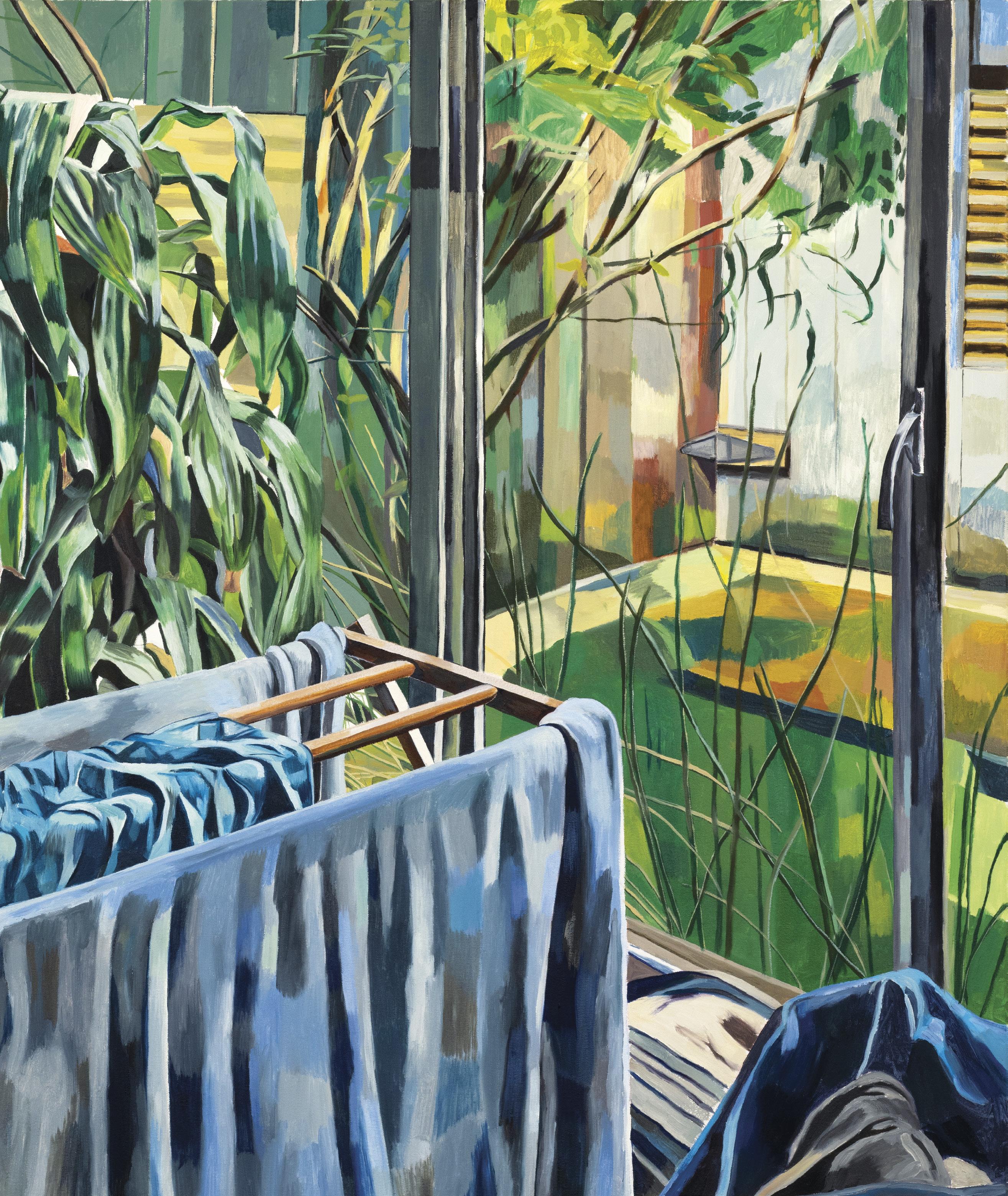
JAY STERN
MID-COAST MAINE
Jay’s work evokes an eerie sense of memory for me. The feeling of finding your way through a familiar place, only in a dream—it’s something I try to capture in my own paintings and the reason I’m so drawn to Jay’s. His cubist lens breaks ordinary subject matter into shards, creating a collage so busy with expressive brush strokes, radiant colors, and impossible perspectives, that the whole image appears to vibrate. With these broken pieces, he masterfully rebuilds scenes that might otherwise seem quiet and dull, yet instead become so full of life. — Jackson Tupper, Art New England’s Emerging Artist cover, March 2020
From a place of safety, the artist can feel empowered enough to declare their identity, to take risks, and break barriers. Jay Stern is an artist who states that for the first time in his life he feels utterly secure. He speaks to life’s in-between spaces and of catching moments in time with affection and stillness. In contrast, his brush stroke is at times outspoken and his lines are architectural. So, when he purposefully paints an abstract section in a painting, contrasted against his assertive lines, one wonders what is being held in that space.
“I’m interested in the moment before we agitate. The moment before history comes in and changes the dishes on the table following a good meal. That moment is a symphony, a
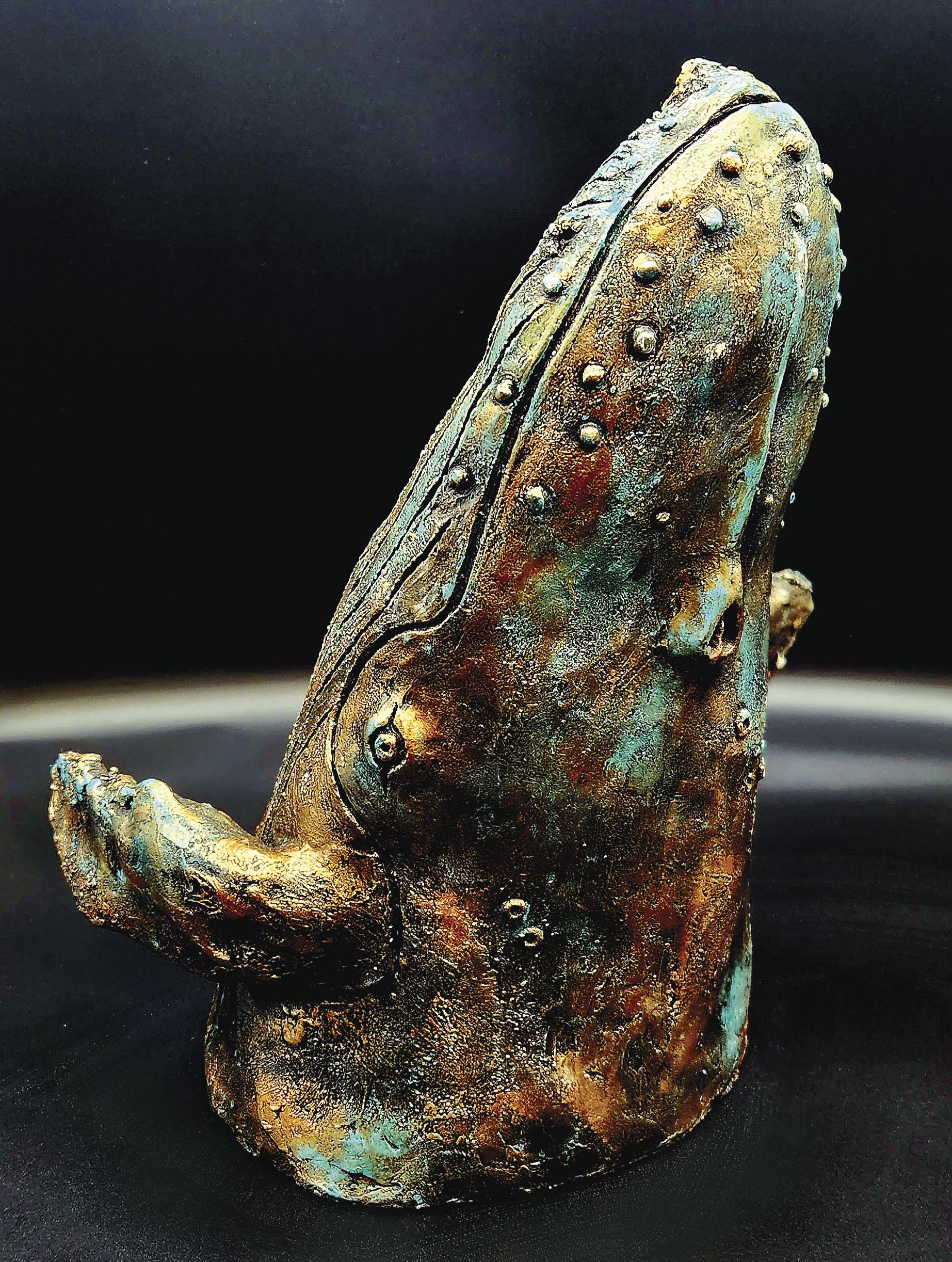
composition of objects that don’t move but are super active and charged. They have history and meaning, then they will be removed and cleaned, that’s when we restart again.”
Stern looks for these moments with an impassioned eye. His art is bold and unique; when one crosses his painting in a gallery there is a distinctive quality that forces a pause of recognition and curiosity. Stern isn’t afraid to stop his walk on the beach, to speak to his partner of the venerable, soft, perfect moment found in admiring a rock formation. He then returns to his studio to transfer his experience of that moment onto a canvas, where time is frozen. Before history reveals the next moment.
In his series, Laundry Day, Stern elegantly shows a portrait, without a face, of his partner or meticulously portrays his vision of domestic life—his partner’s shorts hanging from a clothes rack is a hushed ode to his cozy, conscientious lifestyle. The angles and pointed lines of the clothes rack soften the spaces around the shorts, what Stern calls the mundane. Yet they are not mundane, they speak to the familiarity and security of a quiet albeit rich life.
“I like the in-between-ness and intensity of life. Where I see both the outside of where I’m from, where I’m at and where I might go. I have found spaces in Maine and in my new life where I have felt fully secure and safe. So, when I sit down in my studio, I listen or not listen, I just paint.”
Stern seeks his perfect moment with cadence, identity and dimension. He prefers to leave the table unchanged, to linger, knowing the moment can only be captured in art. — Maureen Canney
ELISA VANELLI ESSEX, MA
Several years ago, I had the pleasure of meeting Elisa at an exhibition where she showcased her artwork at a show sponsored by the New England Sculptors Association. Engaging in conversation about her work, I vividly recall experiencing a tingling sensation as Elisa eloquently described the profound spiritual connection she shares with her art. The impact of her sculptures and the metaphysical resonance they hold left an indelible impression on me. — Domenic Esposito, president, New England Sculptors Association
As you walk into Elisa Vanelli’s studio you feel her art in synchronicity with viewing it. There is intention behind her sculptures. Vanelli taps into the core tenants of humanity, from the Fibonacci spiral to the seven chakras and Masaru Emoto’s informed water theory, and infuses a layered energy into each scultpture that she creates.
Vanelli’s stunning creations have a flow and vitality to them that tricks one’s eye into thinking
32 Art New England | March/April 2024
there is living energy present. One such creation entitled Valentina, a sea turtle in clay with a patina hue, was being held by Vanelli as she brought it to the seashore to photograph. Several individuals stopped her, thinking she was holding a live, rescued sea turtle and that Vanelli was there to release it. The artist strives to evoke a spiritual if not emotional response to her art with the hope the viewer will see the piece by feeling the unseen.
Vanelli adds this second or layered component in all of her sculptures: “What I’ve done is place another sculpture, informed water or crystals into each piece. I want the thing that is not seen by people, to be sensed, that something else is there. That is my confirmation that they see the art in another way.”
In 2019, Vanelli, a painter for more than fourteen years, took her daughter to a pottery class and was introduced to what would become her calling—the art of sculpture. It still took two more years before Vanelli felt the universe influence her commitment to this medium, and since then she feels her life and art have been on an accelerated path.
“I want my pieces to be in the world, to interact with the environment as much as possible. The world is awakening, and we are moving away from the materialistic into the spiritual and physical. Water is everything, water guided me to become who I am, and it is my hope that my art can build more awareness about the environment and how connected we are to it.”
Vanelli draws inspiration from her higher consciousness, connecting to what that creation needs to be whether a sea turtle or mermaid. In art, as in Vanelli’s life, the ancient and contemporary flow easily together like the mutable essence of water itself.
—
Maureen Canney
SOPHIE CANGELOSI ROCKLAND, ME
I first came across Sophie’s work by way of an unlikely source: a southern Maine pizza shop. As a self-described “comber” of charming, quirky restaurant branding, I was stopped in my tracks by an oddly cute, pizza-peel-wielding penguin that forms the logo of the new Peng’s Pizza Pies in Biddeford. A quick search for a credited designer led me to the colorful and calming world of its creator, whose impressive portfolio of expressive acrylic paintings was a surprising discovery given that I was expecting to find more of the linedrawn commercial illustration that Peng’s had teased me with. Instead, I found myself even more drawn to Sophie’s loosely brushed, yet tightly composed intimate paintings that weave both figurative subjects and abstracted environments with vibrant color, beauty, and whimsy.
— Jackson Tupper
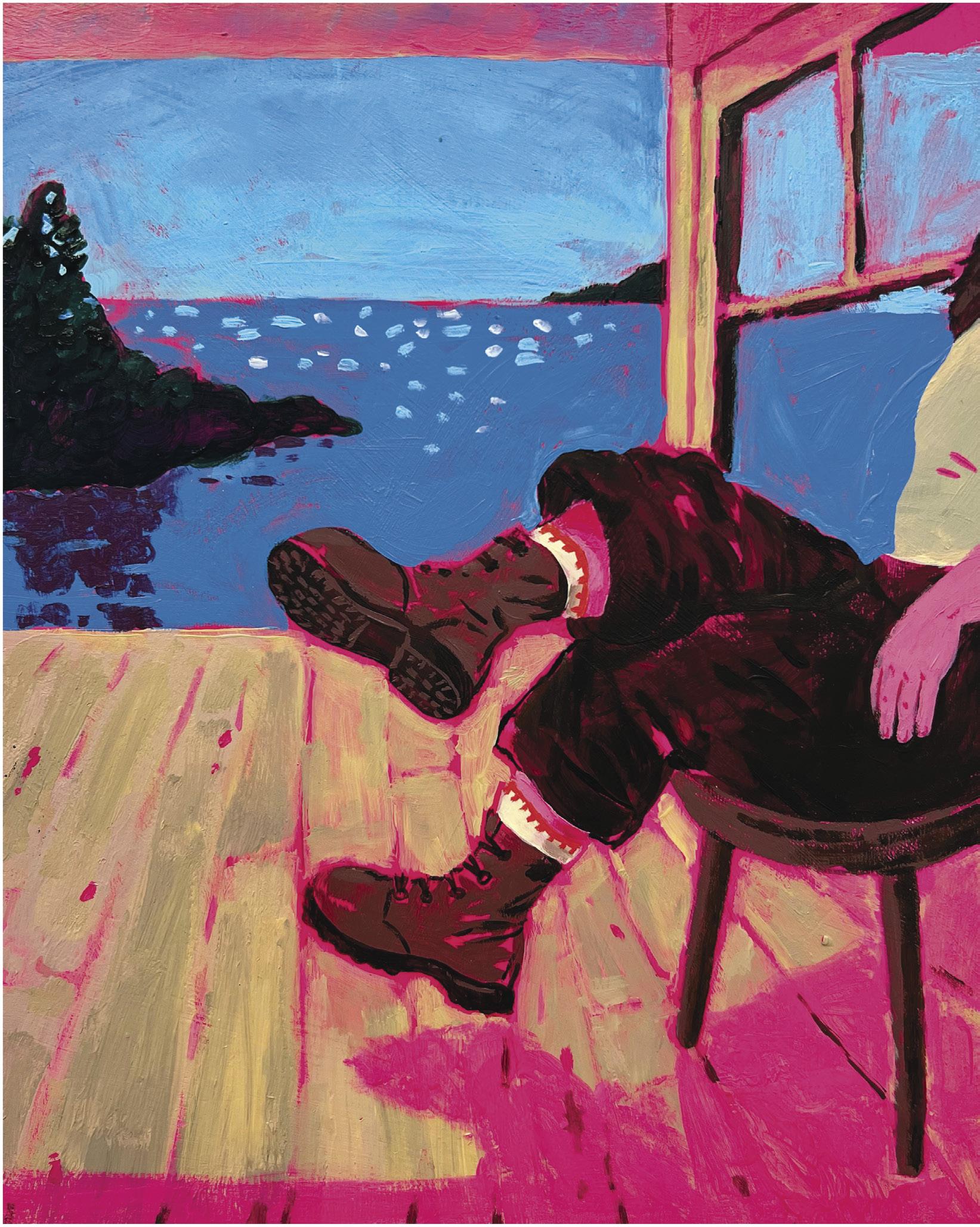
Sophie Cangelosi paints in her studio in the vibrant art hub of Rockland, Maine. She began painting seriously two years ago after working as an illustrator. Illustration has always been a stabilizing part of her mix. Cangelosi is an active participant in public art projects—murals are a passion and she enjoys creative collaboration as part of her artistic practice. As her art career develops, she hopes to paint full time.
Cangelosi pulls directly from her own life field to fuel her practice. She also goes on many walks. “Sometimes when I come into the studio I’m overwhelmed,” she explains. “I spend a lot of time staring at a painting and then I dive in.” The artist primarily works from her photographs. A stylistic trait in her work is the use of neon underpainting. The figures have a playful, confident presence underneath—reflecting
Above: Sophie Cangelosi, Big Dykey Boots, 2024, acrylic on panel, 8 x 10". Courtesy of the artist.
Opposite: Elisa Vanelli, Dancing Whale #1, 2023, Stoneware and Bronze Patina, 13 x 12 x 10". Courtesy of the artist. Previous spread: Jay Stern, Laundry Day 12 (from the series Laundry Day), 2023, 36 x 36".
Courtesy of the artist.
her talent for drawing and illustration—yet have juicy brushstrokes of vibrant color in the forefront.
Cangelosi emphasizes that all of her work is in response to her Maine surroundings, “by the relation and connection—leisure freeze frames about intimate moments between friends and loved ones.” Many of her friends identify as queer. To see Maine depicted with a queer lens is an important intention in her work. Her painting style is both sensual and joyful. Cangelosi’s Big Dykey
March/April 2024 | Art New England 33

Boots presents an intriguing composition where one cannot see the subject’s face, yet can feel her groundedness as she looks out at the ocean. The ocean is built of freeing abstract strokes of paint. Both the figure and the room are aglow with hot pink—emanating girl power.
In Quarry Diver (on the cover) and Iridescent Second at the Secret Beach, color invites attention and exudes confidence as one figure takes the plunge and another lounges on the beach, their skin painted with lively yellow and warm orange tones.
Other paintings like Right Here is a wonderful mixture of form and style—a Venus in the style of Botticelli, head partnered with a fantastically curvy body reclining in the grass with expressive color blocks could be a nod to the styles of Manet or Picasso. The figure is joined by the approaching shadow of another.
Cangelosi is a colorist with an acute sense of pattern, strengthened by her skills as an illustrator. Painted this year, she introduces us to domestic life with Toasting Hazelnuts. The pressing of the hand in the pan is the energy; the viewer is welcomed by the familiar pattern and texture of home in this cozy, serene scene anchored by the heat of a glowing wood stove by the shore.
For Cangelosi, immediate goals include applying to international residencies in the hopes of exhibiting world-wide. Locally, she strives for a home-based studio and painting much larger. She also wants to see the global community take a more peaceful turn to preserve and respect humanity.
— Kelly Holt
JENNA GROSS WESTFORD, MA
I have only had the chance to see one of Jenna’s works live—a piece she performed for the tiny dance stage at Salem Arts Festival last summer which she created with her duet performance partner, Jillian MacLaughlin. I was struck by the whimsical, idiosyncratic and original nature of the piece, and also by the specificity and nuance in the crafting of the choreography and delivery of the performance. Even though the work was quite humorous, there was a maturity to it. In her bio, Jenna references “making serious topics into jokes and taking jokes seriously.” That really comes across in the work. I see a lot of angst-y dance these days, particularly from emerging choreographers. This is a reflection of the spirit of the
anxiousness and uncertainty of these times. Yet precisely because of this feeling of precarity, we need humor now more than ever. Jenna’s work generously addresses that need. There’s something really refreshing about that. — Betsy Miller, Betsy Miller Dance Projects/associate professor of dance, Salem State University
The common phrase of finding solutions instead of seeing only the problem, can be hard to practice. However, artistic innovation is one path to finding your way when life throws you a curve or two. Dancer and choreographer Jenna Gross has emerged into just that kind of artist—one who finds solutions through art and innovation. Gross found herself obstructed in 2020 as a graduate of Roger Williams University’s dance program by the COVID pandemic and subsequent shutdown. Performance art was nonexistent and there was no way of knowing when or if the world would reemerge. Gross
34 Art New England | March/April 2024
Above: Jenna Gross (right) and Jillian MacLaughlin (left) of Rose Woods Dance Collaborative performing Booked and Busy for Ten Tiny Dances, 2022. Photo: Bill Peresta. Opposite: Donald Langosy, Boat of Poets (from his recent show Art/Poetica), 2012, oil on linen, 56 x 51". Courtesy of the artist.
grappled with how to connect and create in such a strange time.
There were not many options for a young dancer trying to find her way without the natural markers of graduation: a first job and being seen as an adult and a professional. After countless doubts and questions about whether to continue with her passion, Gross persevered, bridging the schism with a wag for the absurd and a love for comedy—and movement.
“Dance resonated with me throughout my life. It melds together athleticism and art while highlighting the little details of our existence. Movement really excites me and I’m always looking for those nuances in the mundane. It can be a moment of hysterics and humor that most interests me.”
Despite her wit, one is struck by her intensity of movement and grace. Gross is in a continual study of the subtlety and gesticulation of movement. Feeling alone and isolated, Gross paired herself with dance partner, Jillian MacLaughlin, and started to reach out to other dancers, mentors and choreographers, inundating herself with information, styling, and inspiration. She began a dance troupe with MacLaughlin, and together they studied movement and style in the in-between places, like the fixed dance steps of a gymnast at the end or beginning of a tumbling run.
“I think about the nuances in our daily lives and how that translates to dance. At times I’m trying to complicate details so intensely that the movement comes across as ridiculous, it’s a movement that can’t be replicated twice that really intrigues me.”
Gross and her growing community do not have all of the answers, they simply dance. From her adapting children’s stories through movement to finding humor in a surreal dance while inside a rocking boat, Gross has discovered transmogrification through dance, an elegant solution to finding her own path to success.
— Maureen Canney
DONALD LANGOSY BOSTON, MA
Working with painter Donald Langosy on our collaborative project Country Music Frankenstein: Poems and Collages, which will be coming out from MadHat Press later this year, made me realize the line between poetry and painting is only as thin as the line between conscious and unconscious life. Donald has been physically confined, largely to the small studio in his house north of Boston, by multiple sclerosis for a number of years of intense and joyous creativity. With two recent shows at the Cambridge Multicultural

Art Center, he continues to emerge and emerge and emerge in all his variety. — David Blair, poet and educator, University of New Hampshire
Donald Langosy has been devoted to painting for most of his life, and yet, in his 70s, “emerging artist” is still apt. He has received new appreciation and recognition in recent years. More importantly, his talent for bringing forth new ways of seeing art—and new ways of seeing through art—have defined his work over several decades.
When pressed to define his style, Langosy calls himself a “Baroque metaphysician.” He cites Titian and Giacometti as foundational inspirations. He also has a deep affinity for poetry that permeates both the symbolism and technical approaches in his work. Ultimately, the workings of Langosy’s own mind shape the canvas. As he puts it, he is “amazed by what happens in thought,” and painting is his way to bring that out into the world.
“My linguistic ability is visual,” he says. Over decades Langosy has explored unique ways to make his creations speak. In his early career, he patched multiple paintings on top of each other, which created an effect that conveyed the continuous and evolving nature of ideas and experiences. In this way, he layered the dimensions of space and time onto the images he painted. In the 1990s, he added new dimension in a tangible way; he worked large-scale and bent and folded the canvases. When multiple sclerosis began to limit his physical capacity, he adapted techniques to capture his unique perspective. Langosy now uses digital tools to map out his projects. To bring those concepts into being he relies on his brush and oils, and many hours in the studio.
Langosy’s paintings command the depth of attention and intention that he puts into them. Visitors to his Art/Poetica show at the Multicultural Arts Center in East Cambridge, MA, in fall 2023, lingered for an average of an hour or more with his paintings. It’s easy to see why. In his Boat of Poets, Edna St. Vincent-Millay, Walt Whitman, Ezra Pound, Ralph Waldo Emerson, Emily Dickinson, Edgar Allen Poe, and Henry David Thoreau bob in a reedy vessel that seems to disintegrate into the dappled woods behind them. In the reflection below the boat, these luminaries of poetry become literally that: their faces are moons in a deep night sky. Somehow the image is both transient and timeless; it captivates and transports.
Langosy’s current series, The Journey of Eduardo Gunkla, based on a character of his own imagination, is scheduled for exhibit at the Multicultural Arts Center in fall 2025. A sneak peak of one canvas reveals the signature of his boundless imagination, rendered in layers of symbols and hours of brushstrokes. It promises to continue Langosy’s journey as an artist who transforms. — Emily Avery-Miller
March/April 2024 | Art New England 35

NGOC-TRAN VU DORCHESTER, MA
I was introduced to Tran through a mutual friend. At the time, Tran was contemplating a significant public sculpture. Her immediate impact on me was profound—her thoughtful approach, mastery of scale, and creative use of materials were truly impressive. I admire how her artistic endeavors serve to unite communities, with the added beautyof weaving her Vietnamese heritage into sculptures that are poignant reminders of our shared human experience. Tran’s lasting impression on me is undeniable, and I have no doubt that she will emerge as a formidable presence in the Boston art scene.
— Domenic Esposito
Ngoc-Tran Vu is a visual artist and cultural organizer making her mark on the greater Boston community and beyond. Born in Vietnam and raised in the Boston area, the Dorchester, Massachusetts-based artist began her career
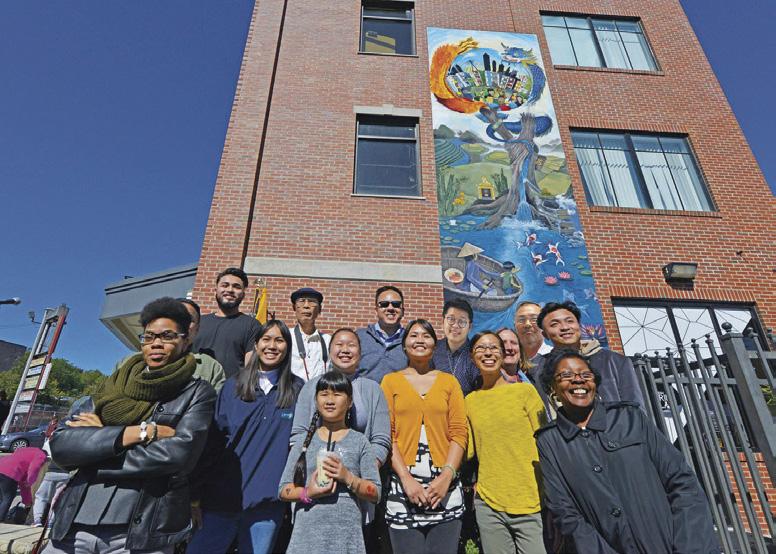
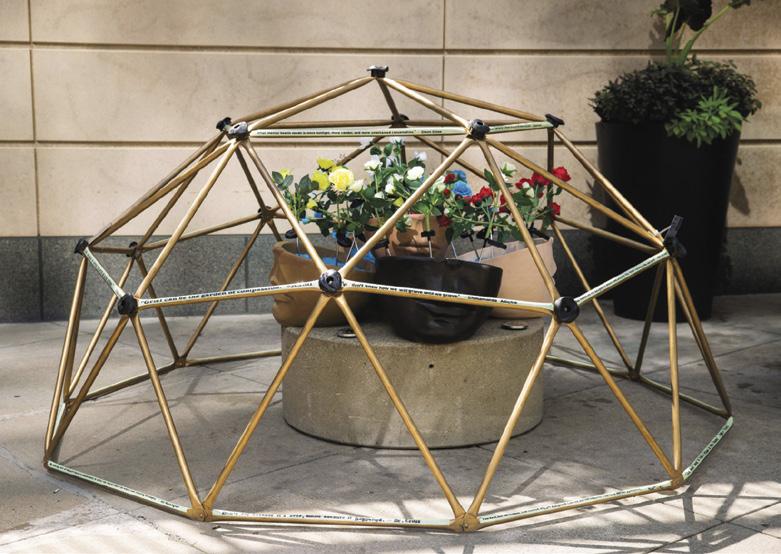
working in painting and photography, yet has recently moved into sculpture and public art. Her practice primarily surrounds “socially engaged art embedded in the community,” she said. Vu knew she wanted to be an artist from an early age. She recalls that her fourth-grade art teacher, Miss Sally, encouraged her to take classes at the Museum of Fine Arts, Boston. “I knew early on that my gifts and talents are in the arts, and it was just a matter of, how do I put that into practice?”
Vu approaches art with a community-oriented mindset. She works closely with Vietnamese and Asian American communities and amplifies unheard voices through her art. Her current project, 1975: A Vietnamese Diaspora Healing Memorial, “is something that is long overdue in the Dorchester community. [There is a] predominantly Vietnamese population here, but there’s no permanent marker of our presence,” she said. The memorial, set to be installed in 2025, marks the fiftieth anniversary of the end of the Vietnam War and the beginning of a significant Vietnamese

diaspora in the U.S. Vu is still exploring what this project will look like, and is considering recent discourse surrounding public monuments and spatial justice. Vu also hopes to travel to Vietnam this year. She is looking to research materials and fabrication methods for the memorial. Vu aims to learn how she can use materials from Vietnam and Southeast Asia in the installation while keeping the memorial sustainable.
Travel is a big part of Vu’s practice. She is part of the Intercultural Leadership Institute, through which she travels with artists from across the country to work and build with each other and different communities. In addition to her public art work, Vu teaches classes and workshops. She works with Assets for Artists and is part of a three-year initiative to share resources with artists through the Artists U curriculum. Vu continues to work in cultural organizing as a freelancer, individual consultant and grant writer, and she also works in climate justice. “[I’m] someone who is always constantly learning what things are happening around me in the world, and how do I infuse it into my work so that it becomes very action-oriented and to inspire and also, to heal?”
— Autumn Duke
EWA CHRUSCIEL WILMOT, NH
Ewa has taught at Colby-Sawyer for a long time after completing her doctorate in the U.S. and is a very seasoned traveler both for conferences and grants and now more recently to pursue her passion for bird photography. She has a light-filled, porchlike studio where she writes and is learning to paint. Having just come back from a writing conference, she shared many books of essays and poetry
36 Art New England | March/April 2024
Above, from left: Ngoc-Tran Vu, A poster for the 1975: A Vietnamese Diaspora Healing Memorial. Courtesy of the artist. Community in Action Mural located in Dorchester, MA. Photo: Linh Pham. Healing Garden located in the Fenway neighborhood temporarily, 2022, mixed media installation, 10 x 10 x 10'. Photo: Zev Fisher. Below: Ewa Chrusciel’s cover art for Yours, Purple Gallinule (Omnidawn, 2022). Courtesy of the artist.
acquired there, explaining what happens at such an event with someone who has never been to one.
I think Ewa is still quite the struggling immigrant here in the U.S., yet her poems and writings present the stories of “foreign encounters” often in a gentle, humorous and very wonderful way that makes them accessible. Her students must love her energy and sensitivity. Ewa is one of the most gracious and energy-filled women that I have met in a long time; being with a true artist is very special. —Suzanne Lee, owner, the lakes gallery at chi-lin
Poet, educator and translator Ewa Chrusciel published works include Yours, Purple Gallinule (Omnidawn, 2022), Of Annunciations (Omnidawn, 2017), and Strata (Emergency Press, 2011). Given all that she’s has produced, we asked how she views herself as emerging? “Since I write in a non-native language, I always feel ever emerging. Writing in a foreign language and being foreign saves me from narcissism and idolatry. I always feel I am in terra incognita; I have to start anew each time I write a new thing. Right now, for example, [I was approached to write] a book of essays on themes to do with misplacement, exile, foreignness in language. I will be truly emerging as an essayist.” While Chrusciel is ever emerging as a writer, she first came to poetry in elementary school while reading Zbigniew Herbert, Czesław Miłosz, and Wisława Szymborska. It is Herbert’s poem, “Cogito and the Imagination,” that most impacted Chrusciel given that the poem centers upon a poet who has a dedication to “…uncertain clarity.” For Chrusciel, this translates to “…a commitment to being bewildered.” Jumping into another language also adds layers to the practice. “In high school, I believed poems were dictated by a daimonion; it felt like a tiger jumping out of you, to paraphrase Miłosz’s ‘Ars Poetica.’ I started to write in English during my PhD studies in USA, because I was asked by my peers to translate some of my Polish poems into English, and I got bored translating myself. I started to mistranslate myself and my first original poems in English came to life this way. I believe when you write in a non-native language, you smuggle images, you shuffle them from one cultural zone into another.”
Chrusciel sees herself very much the smuggler: “Because I did not want to renounce anything, I wanted to keep both languages and worlds. The price was the ceaseless border crossing, smuggling. Writing in English is the work of smuggling metaphors from one language into another. It is a work of bilingualism and mistranslation, so it is a constant mental shifting and shuffling between the two languages, between these two different conceptualizations of the world. Writing in two languages creates bewilderment for us and our readers.” Chrusciel also talked about her connection to birds as metaphor for her work given her most recent book, Yours, Purple Gallinule, that

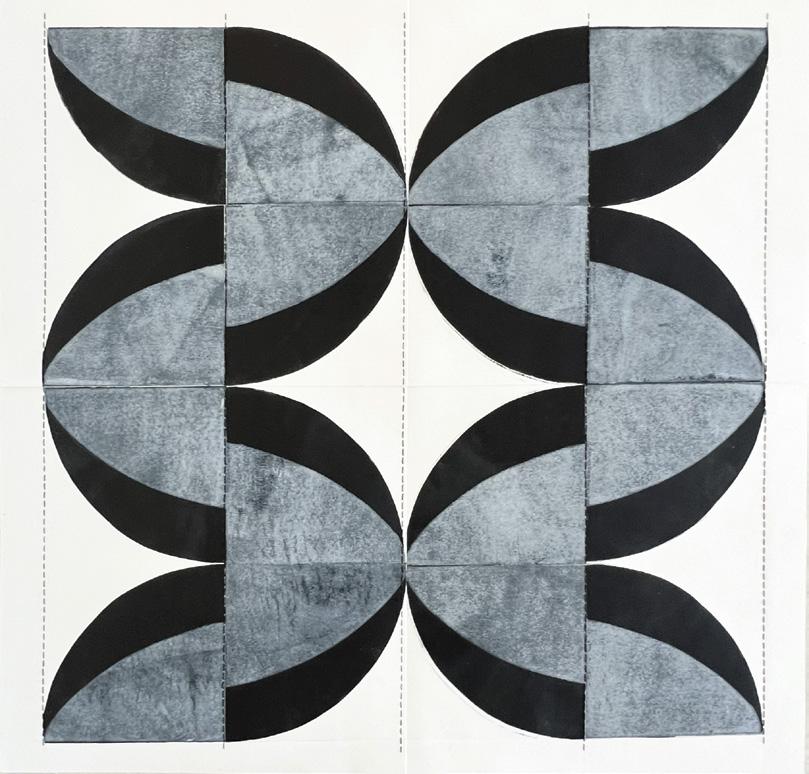
explores society’s relationship to diagnosing, and over-diagnosing, mental illness. She offered: “I was already into birdwatching because Emily Dickinson showed me the strangeness of birds. I like to explore them both as real and as symbols. My last name means a wading bird, such as purple gallinule. That’s how I got a concept for my latest book. On the one hand, there was my fascination with birds, and on the other, I was intrigued by the diagnostic culture we live in.”
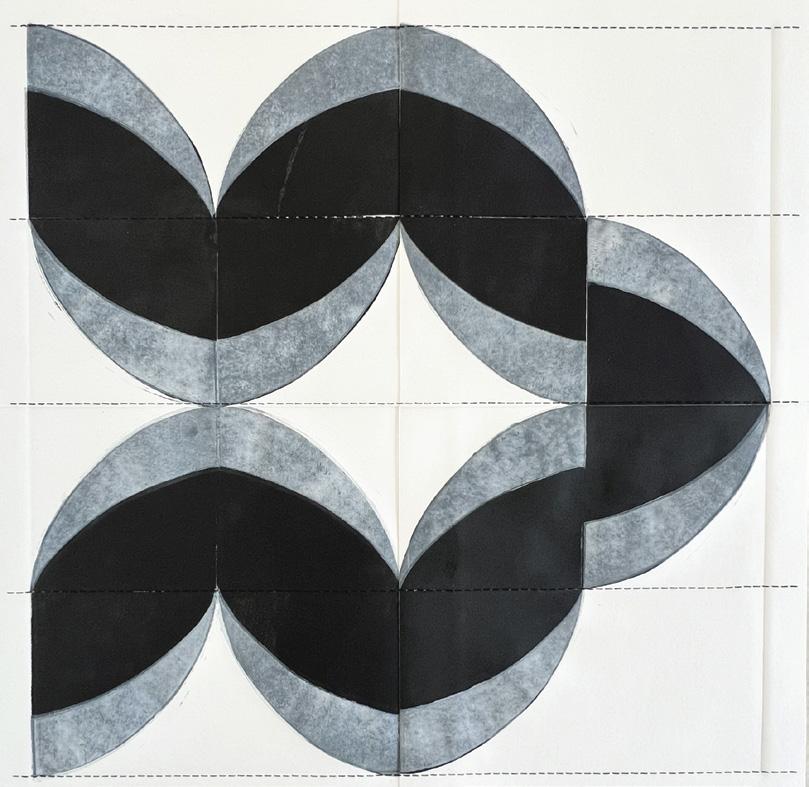
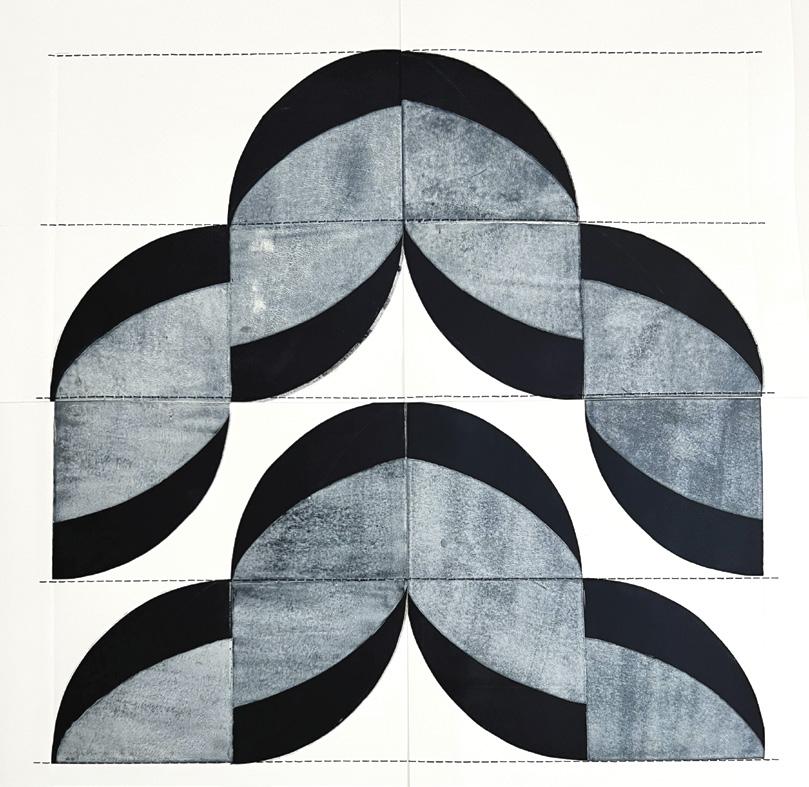
Chrusciel wants us to be engaged with madness in all the good ways, exclaiming, “Being mad is a privilege! All in all, I hope my readers experience bewilderment, some spots of astonishment, and be either delighted or provoked, sometimes touched, and sometimes amused.”
—
Shanta Lee
ELISE WHITTEMORE GRAND ISLE, VT
I’ve known Elise since I was in elementary school and she’s been an artist as long as I’ve had the pleasure of knowing her. We often think of emerging artists as young folks in their twenties, fresh out of art school, working towards their first gallery show and newly navigating the art world. More often than not, the true story is one of artists spending decades pursuing other careers, all while
relegating their private practice to the sidelines out of necessity, something reserved for weekends, stolen moments to oneself. Elise has spent years doing editorial work and teaching in creative spaces as her full-time career. Just a few years ago, she finally built her dream studio space and has returned to her personal artistic practice with admirable intention, dedication, and purpose. The result is work that connects and engages with viewers in a newly intimate and deeply personal capacity and that I personally believe is the best she’s ever made.
— Patricia Trafton, Soapbox Arts, Burlington, VT
Elise Whittemore holds a BFA from Syracuse University where she studied design, photography and printmaking. Her studies have included woodblock printmaking and lithography at the Art Students’ League in New York and a painting residency at the School of Visual Arts. Also a curator and teaching artist, Whittemore has produced many exhibitions throughout Vermont and taught high schoolers through the Young Curators of Vermont.
March/April 2024 | Art New England 37
Above, clockwise from top left: Elise Whittemore, Black Quilt I (Named/Unnamed), Black Quilt II (Named/Unnamed), Black Quilt III (Named/Unnamed), Black Quilt V (Named/Unnamed), 2023, monoprints—soy ink with cotton stitching, 26 x 26". Courtesy of the artist.
Whittemore’s ability to work with different media is amazing. “After years of painting, I took a woodcut class in my 50s. I loved the graphic drawing and the manual labor of making plates… Monoprinting, not making editions but layering images and reusing the same plate over and over again really appealed to the painter in me,” she shares.
Retirement and a move to Grand Isle, Vermont, brought contemplation and discovery in the new landscape. Ideas of maps and moving shapes came into play. Influenced by her mother, a quilting artist, geometric abstractions and stitching emerged from her studio. Shares Whittemore, “I would watch how [my mother] constructed a square, cut it apart, rearranged it, and created more squares from that. Looking into the history of quilt patterns showed me parallels to geometric abstract art—using shapes and repetition to talk about complex ideas of home and place.”
Whittemore’s latest work takes her knowledge of painting, collage and printmaking (woodcuts, monoprints and lithography) and moves into a new experimental space. Current
influences for her in the studio are Agnes Martin and Anni Albers. “I’ve reduced my palette to black and white, making monoprints out of inked cut vellum shapes—simple circles or arcs. I like the strong contrast, another reference to graphic quilts, using the white to define the image as much as the black,” she describes. “I first lay down the heavy black, thinking of it like a statement of sorts, a claim on the page, then lay over the white as a reconsideration of that statement. A pattern does emerge, but the edges of it get blurred, the exactness of it gets reworked, and what starts out as declarative, ends up being more hesitant.” Whittemore’s 2023 series Black Quilt (monoprint and stitching) takes her skill to a new level. Geometric shapes sewn together conjure an organic spirit, breaking into the sculptural realm.
Where is Whittemore headed? “Where I’m going with all this—handling paper and stitching large sheets together is making me think more and more sculpturally, and I’m going to keep exploring where the intersection of pattern and maps take me.” — Kelly Holt

LYDIA KERN
BURLINGTON, VT
Lydia has been working so hard over the past few years and I would love to see her receive time in the spotlight. She is also such a supporter of other artists in the community. We are so lucky to have her in Vermont. — Jasmine Parsia, multi-disciplinary artist. Kern’s website adds, “Lydia creates a spacious symbology surrounding themes of care, preservation, and the immaterial connection that continues with those passed on… Her practice is an autonomous process of meaning-making for experiences in life beyond language.”
Lydia Kern emerges as a multimedia artist with fearlessness. The original Greek translation of the word “apocalypse, to unveil or uncover” is a cornerstone of her practice. Having lost her younger sister during college years, Kern shares, “The simultaneous tragedy and outpouring of love and support… was an unveiling of what really mattered to me—art making and being with the people I love… being a part of a supportive artistic community was forged at this time in a deep way.”
The artist’s career began with her first studio in Burlington, Vermont, in 2015. Community is another cornerstone of her practice. It’s what makes collecting and fabricating possible for her, helping her externalize emotion through artmaking. The spirit of interconnectedness pops up in Kern’s work in the form of holes or portals. In her early career, she developed work for local art festivals such as Art Hop and Waking Windows. She also installed a piece in Exposed! with The Current. A site-specific exhibition at Epsilon Spires in 2022 brought her work to a new level, installing altar shaped pieces into this site of an old Baptist Church.
Kern describes her process as being built on “material poetics.” She uses found objects and collected flowers and plant life from different locations, farms to thrift stores to the side of the road. These objects are the vocabulary of each piece. Objects are encased/sewn into vinyl or other transparent materials, with the intention to allow color and light to interact with them. Shares Kern, “I think about the relationship to suturing a wound and mending a quilt, the care that goes into both acts. The poetics of quilting and healing as a kind of re-patterning are endless.” The objects she collects are used to memorialize and honor. “Some materials have a certain serendipity to them, like finding a double headed mutant sunflower in a field while working on a piece called Ghost Twin. These moments are largely why I do what I do.”
Friends and fans of Kern’s work associate bright pink color with the artist. “After visiting
38 Art New England | March/April 2024

Italian catacombs, American painter Paul Thek said, ‘It delighted me that bodies could be used to decorate a room like flowers. We accept our thingness intellectually, but the emotional acceptance of it can be a joy.’ Flowers are little worlds unto their own, brief and completely transporting if you look up close…objects of gesture that hold more than we can say. We bring them to both the funeral and the wedding.”
With each new series, Kern’s altarpieces, tombstone shapes, arches and portals develop her language of memory and transcendence. There is no doubt that vibrant pink color will find its way to other continents in the future.
— Kelly Holt
SIMON MONTALVO
LAND OF THE MASSACHUSETT AND PAWTUCKET PEOPLES
Simon and I were peers while studying at the Boston Conservatory at Berklee. While working as an alumna on commission, I was paired with Simon as one of my residency rehearsal directors. The curiosity, generosity, care, and humor they brought to the space was palpable. And then I saw their work. Simon creates work that asks us to see ourselves and others. They are invested in community, not just in theory or thematics, but in practice, building long-term processes and long-form dance and film works that highlight the inner intimacies of transgender and gender-non-comforming people’s lives—a “living archive” as they describe it. Simon is a shining example of a young artist whose ethos and the work they create align in a way so deeply inten-
tional, you cannot deny the overwhelming impact on the artists they collaborate with, and in turn the audiences that witness it. — Laila Franklin, dancer, Emerging Artist 2023
When Simon Montalvo was in high school, they realized that dance could be a career. The affirmation “I’m a dancer” was at that point central to their identity. In college, they realized that “I’m actually a human first. I don’t have to drop everything else for this art form I love,” and they started branching out more into more multidisciplinary art. A recent bio identifies the twentyfour-year-old as a “non-binary/transgender movement artist, researcher, and archivist,” and their repertoire of choreography and multimedia productions reflects an omnivorous artistic spirit.
Even as they constantly explore, “movement is still the center,” for Montalvo. With that as a guiding principle, they create work that both pulses with a diversity of perspective and honors the singularity of individual self-expression. Each piece reflects an intensive, improvisational and collaborative process. Montalvo starts with a seed of inspiration—a word, a line of poetry, an image, a testimonial—and they and the other dancers respond with movement. They work through those responses iteratively to create the dance, trying new configurations and keeping space for the movement to evolve. In the performance, every embrace, bow, leap and footstep has the freshness and energy of the original, raw emotion that inspired it. The projects embody a collective vitality and also highlight each dancer’s unique contribution to the moment.
Animated by investigative and omnivorous research, Montalvo says that literature is a key
influence. A primary source of inspiration for their current project, a house with no walls is May Sarton’s Journal of a Solitude, which chronicles the poet’s daily life in rural New Hampshire. After reading it, Montalvo decided, “I wanted to capture that feeling of coming home to a house with lights on and people there.”
Creating the spirit of warmth and welcome is a core motivation for Montalvo. A house with no walls is “a living archive of transgender and gender non-conforming people’s experiences, shared through movement, objects, and the deep intimacy of what it is to be seen as all you are.” The project is based on interviews with transgender and non-binary people that are woven into the choreography, and the casting process is inclusive of dancers of all gender identities.
The latest installment of the project a house with no walls: first floor premieres June 7–9, 2024 at The Boston Center for the Arts (Plaza Theatre) where Montalvo is a Boston Dancemakers resident. It promises to be an event full of stories, of embrace, and of choreographic and multimedia exploration that is ever evolving and expanding. “This is just the beginning,” says Montalvo, and that expansiveness is at the heart of the beauty they create. In a house with no walls, there is always room for more. — Emily Avery-Miller
March/April 2024 | Art New England 39
Above: Simon Montalvo’s upcoming project a house with no walls: first floor featuring (L-R): Meredith Price, Jackson Bradford, Haley Andrews, Jessica Massimino, Ashe Turner, Aliza Franz, Maude Warshaw, Austin Guin. Photo: Olivia Moon. Opposite: Lydia Kern, Ghost Twin, 2023, roses, bleeding hearts, double yolk egg shell from Yundwell Farm, embalming thread, bells, mother’s ultrasound, foxgloves from the Black Forest, daisy, vinyl fabric, resin, wood, ink, 37 x 1 x 38".
Photo: Daniel J. Cardon.
The Metaphysics of Art: Through Engagement and Practice
A Conversation with Nitasia Roland, Candace Jensen, Lux Heljardóttir and Jamie Mohr
BY SHANTA LEE
The comingling of metaphysics and art stretches to the beginning of human history across all continents and artistic mediums. When using the term “metaphysics” here, we refer to the Webster Dictionary definition, “… relating to, or being part of a reality beyond the observable physical universe.” Etymonline.com defines the word as “the science of the inward and essential nature of things.” As related to art, this can mean work that seeks to explore the depths of what it means to be human, to art that transports beyond the boundaries of space, time, and human reality, sometimes blurring the seen and unseen. There is also art that engages the supernatural and esoteric. This feature explores the avenues through which individuals have explored the abstract ideals of metaphysics and the esoteric through their artistic approaches. This includes conversations with poet, esoteric nonfiction writer, independent researcher, publisher, and Tarot deck designer Nitasia Roland; interdisciplinary visual artist, writer, calligrapher, curator and community organizer Candace Jensen; runemaster and vǫlva (Old Norse term for “seeress”) Lux Heljardóttir; and Jamie Mohr, executive director of Epsilon Spires in Brattleboro, Vermont.
Before we proceed, this writer wants to share how the piece is arranged. Think of it as a magic book, an instruction for setting intention and gathering ingredients and insights for your own creative practice. This feature centers around the insights of the artists and keeps the following in mind:
Setting intention and invocation: How did these individuals summon or become summoned by the aspect of metaphysics and art?
Preparation and gathering ingredients: With any creative practice involving the realm of the unseen, one must have the proper ingredients. For these artists, ingredients ranged from deep inquiry to how they individually define metaphysics and art.
Practice and engagement: How have these artists engaged with creative practice as it relates to metaphysics? And can creative practice within metaphysics include the curation of space?
Applicability and instruction: What advice can be shared from these artists?
Exploring the broad and abstract topics of metaphysics within one’s art can start with what calls to us as we live our lives. Nitasia shares, “I feel I have always been mystically inspired and connected to nature and its mysteries from a young age.” When Lux first encountered what later became her work as a heathen and a vǫlva—a practice connected to the ancient Norse tradition that involved witches travelling to different households—she was just a child. “My first memory of interacting with a deity was sitting in my childhood backyard under a forsythia bush. I received the distinct impression of the face of a woman, half-alive and half-dead, visiting me. I later learned she was the Norse goddess Hel, queen of the underworld. Over time, I studied and practiced; I became a runemaster and specialized in the Poetic Edda. I taught classes on these topics, as well as the various Norse magics, which led me
to the talented people who became my group of travelling witches.”
For both Nitasia and Lux, the metaphysical as a bridge towards their art whispered in their ears at an early age. How do they define what it means for them today? Nitasia sees it across many levels: “The philosophical contemplation of the metaphysical is multifaceted. It is a speculative, spiritual, and conceptual experience that helps us understand reality beyond what is observable, quantifiable, and rational. Art and metaphysics mutually inform each other in an unraveling dance of symbiotic exchange and synergistic affinity. The metaphysical artist draws inspiration from dream, vision, inward gazing, and connection to energies from the numinous realms, and pulls gnosis [the knowledge of spiritual mysteries] through the vortex into the material world. Then, either by wild abandon, or
40 Art New England | March/April 2024
Opposite: Nitasia Roland, STARLORE Astronomical Tarot, 2023, Urania Press. Courtesy of the artist.

highly structured skill, utilizes various mediums, metaphors, symbols, archetypes, shapes, textures, tempos, emotions, and poetic structures, to create and communicate what the spirit had conceptualized and envisioned.”
In terms of her work and the preparation for this path, Nitasia pursued her connection to intersections of the metaphysical and art and poetry. Her influences included her desire to be an Egyptologist in her late teens to her encounters with the visionary art and writings of William Blake, and the poetry of Percy Bysshe Shelley, Yeats, and Rainer Maria Rilke.
Like many artists, Nitasia’s road was a culmination of work and encounters inspired from the esoteric, her explorations of the I-Ching, the RiderWaite-Smith Tarot system, the scholarly material of
Henry Corbin, Elaine Pagels’ Gnostic Gospels, Harold Bloom’s Omens of the Millennium: The Gnosis of Angels, Dreams, and Resurrection. As she describes, “I settled mainly on the Western Esoteric Tradition within magic, talismanic and planetary magic, oracular traditions under Apollo as teacher, and ancient Hellenistic household worship and devotion as practice.”
Candace names the metaphysics of and within her art as attending to the “soft mutterings.” Specifically, “In my mind, in bodily memory when I’m making art, or when I’m writing, I have these little bits of language that bubble up, just from being out in the world… If I don’t write the soft mutterings down, they may go away and I forget them. You know, that’s the muse speaking, right? Creativity and metaphysics are coming into a relationship
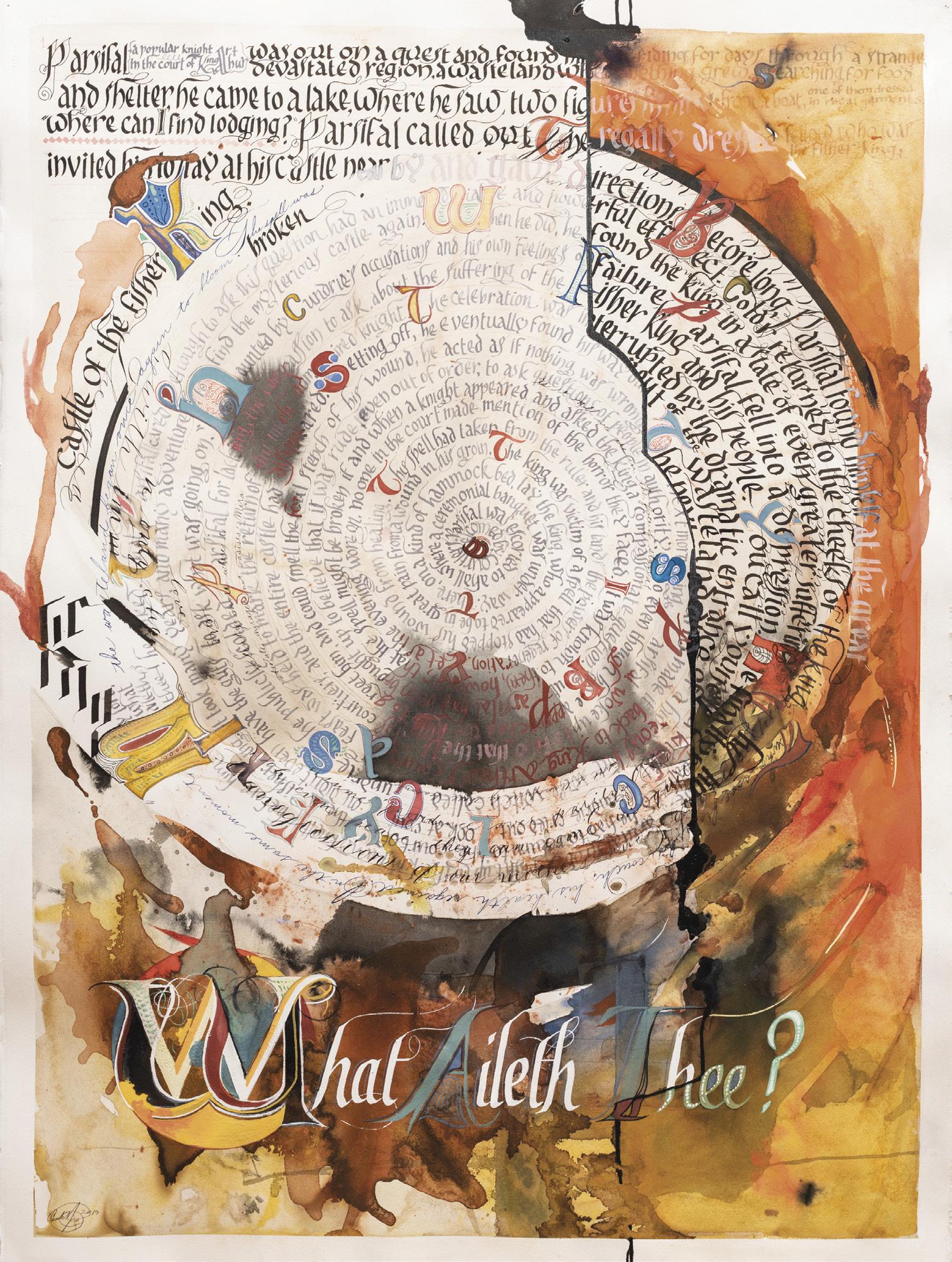
in that moment—I feel there is an expectation to serve the soft mutterings because of the faculties we have—bodily knowing, memory, the mind, we have our senses. We have so many different processes of reception, of ingestion, and all the processes that are related to that… It’s like we become little radio antenna picking up signals from all the stuff around us, I wouldn’t pretend to know where the soft mutterings come from, but creative response to them feels respectful, or even imperative.”
Candace likens the experience to a meditative hike in the woods. “You’re just sitting as leaves fall around you. There’s this powerful presence, surrounded by a community of beings that are all around you, and there are the messages that you’re getting, and some messages that are going over your head. It doesn’t mean that you’re now a spy for the egregore of the woods and you’ve got this very specific message to deliver…it’s not like that! The messages don’t have the same kind of urgency as a letter, with a sender and an addressee. These are like catching bits of song being sung for the joy of singing, not an audience, but the listener hears it all the same.”
Lux connects the metaphysics of art with how the Norse saw magic, “…many common magics weren’t what we’d now consider sorcery—sound, textiles, later writing—yet they were sorcery, creating a kind of protection, will, and immortality.” Speaking to the concepts within the definition of metaphysics, Lux continues stating that art “…transcends time. The artist combines various elements of personal significance in their chosen medium in order to manifest an evocation of something. What is that if not a spell? The artist forms a unique energetic signature in the finished art, an echo of that intentional moment in time. The art continues to elicit its call-and-response magic even after that time, and the artist, no longer remain.”
The most important connection that each of these artists discuss is a sense of articulation, or at least a discovery of what is included in their explorations. And, like the art of cooking, after establishing an understanding and gathering of the ingredients, there is the practice and engagement that must take place. This can be in the form of creating work, curating and creating a space to show said work, entering the realm of performance that brings all of these elements together.
The culmination of the ingredients, or the engagement for Lux occurred on October 21, 2023, in Brattleboro, Vermont, at Epsilon Spires, an arts and culture non-profit that often hosts programming featuring national and international artists across disciplines. The event, “Freyja’s Wisdom: Spirit, Magic Ritual & Rune Divination,” involved Lux and her visiting group, Heiðsær. Epsilon Spires, an old stone church that still has its original stained glass, unique acoustics within the sanctuary, and an original Estey Organ—was transformed into a divinatory and conjuring space to allow the audience a chance
42 Art New England | March/April 2024
to engage with Freyja, the goddess of love, war and magic. The evening was immersive as the audience sat bathed in a combination of silence and chanting while holding space for the Heiðsær to raise the goddess. After Freyja was raised, the audience was invited to leave offerings while they received guidance or asked questions of the individual embodying Freyja.
As an audience member, it is still challenging for this writer to put the experience into words and there are some who say that metaphysical experiences can’t be truly articulated. Speaking further with Lux proved helpful. Lux first engaged with Freyja in 2014; she was invited to anchor a group of ritualists in their exploration of a Norse myth. “I learned a lot about how to not only be alive, but thrive, from Freyja.” Preparation for this experience in Vermont included years of practice with her vǫlur team, Heiðsær. Lux details, “…we practiced seiðr many times and were invited to several homes, during which we honed our skills and our relationships with Norse deities. Some deities are more challenging than others! A lot needs to be cultivated in order to accommodate a spirit or deity within one’s body.”

Sometimes these events culminate in other ways, especially if the artist is not starting with the metaphysical as the main goal. Candace explains this in relation to her solo show, Deep Green Query, that opened during the start of the COVID pandemic. “I wasn’t approaching that show from a mind towards metaphysics, I was approaching with a mind towards animism. Specifically thinking interdependence, interrelatedness, and unseen networks of connectivity. I was focused on responding to The Spell of the Sensuous by David Abram. He was a magician before he was a celebrated spiritual author. Abram was traveling the world learning magic tricks, and showing magic to people while trying to think about magic in terms of its cultural historical roots. He shares a theory around the languages [where] we’ve lost the ability to read, speak and recognize in favor of the written word, in favor of a highly codified logical system that says, ‘if it doesn’t fit, it doesn’t exist.’ I resonated with this message.”
In practice, this was about obscuring the meaning of words, written language, that Candace created for the exhibition. “Embedded there in the drawings are real words with real content, but pushed beyond legibility through my drawing process. I would write essays or have little poetic dialogues or responses to things I had read or experienced, and the ink and the paper and the language of the material was then NOT allowing the viewer full access to it. I created a baffle, a labyrinth for the viewer.” And Candace

admits, at that time, “I don’t think I really understood what I was doing. What does it mean to carefully write an essay, and then carefully transcribe it in calligraphy onto a very large piece of paper, and then do enough intervention that it’s only partially legible, if at all? The paper is told this story—you’re conveying meaning into the material and allowing it to come into some kind of relationship with the inherent material meaning. Then putting word to paper is a risky, animistic alchemy—instead of simply ‘writing.’” She describes it as being connected to her artistic language, her practice of “…making something and putting it into a shape, forming word, or sound, and then letting it become part of the primordial soup that forms the final visual art.”
In Nitasia’s experience, engagement with syncromysticism is key to her spirituality, art, and writing. It is a term coined by filmmaker Jake Kotze in 2006,
as taking patterns or coincidences and noticing their layers of esoteric meaning. For Nitasia, this can be the “…threads that connect in meaningful ways, such as strange meetings, signs and symbols, and dreams that give a sense that they are messages from spirit which convey a potency for personal change and embodiment.” Her approach weaves across all her artistic practices. In terms of her written work, Nitasia describes it as oracular because, “…so much of what I have written has come to pass.”
In the creation of her Tarot decks, Emblemata, Starlore, Chimera, and the upcoming Scrying Angelos with Revelore Press, Nitasia’s application of the metaphysical always dovetails art and magic together. She describes it as “...an amalgamation of poetic connection to the words of the prompts, scrying material and intuition.” For Nitasia, scrying is “seeing or understanding personal truths through gazing in a contemplative trance-like state at reflective surfaces, such as spring water in a basin.” The prompts mentioned in this example relate to Nitasia’s recent foray into collaborating with AI, a controversial topic within and outside of art circles. She has been sharpening her prompts using Mid-Journey AI and continuing to engage with the language she is using for a desired visual output.
March/April 2024 | Art New England 43
Above: Freyja’s Wisdom: Spirit, Magic Ritual & Rune Divination featuring (left to right): Lux Heljardóttir, Jade Njǫrunardóttir, Melissa Óðsdóttir, and Lis Friggjardóttir. Photo: Owen Schuh. Left: A drone image of the interior at Epsilon Spires. Photo: Ezra Distler. Opposite: Candace Jensen, Parzival What Aileth Thee (Gaia Illumination), words by Joanna Macy and Martin Shaw, 2019, coffee, vermilion, sumi, watercolors, gouache, ink, graphite, turmeric on paper. 221/2 x 30". Courtesy of the artist.
A Closing Spell
As one can imagine, this conversation is a mere tip of the iceberg. Each artist shares advice on how we all may bring the metaphysical into our creative space. This advice is abridged yet perhaps it will illuminate your path.




Lux: “Creation. The Norse didn’t perceive separation between the sacred and the mundane. I invite you to hold awareness that the very act of art—of creation—is a divine ritual. Just as weavers were wrapped in holy language for their ability to see patterns and to make fabrics that kept people alive, try to find the sacred in what you do as an artist. Lean into your own agency, see how your own work brings blessings, and highlight more of what you find sacred about it. The word sacred is related to the word consecrate, or to set apart and make holy. Intuition. Many forms of the craft require discernment and intuition, but so few of us are taught how to ‘do’ it. Learn your own language, set aside time to know yourself, study your own patterns, learn what a ‘hunch’ of precognition feels like in the body as opposed to dread, wishful thinking, et cetera. I might sit in a bath and simply be until I notice only the passing of time. Curiosity. Always be willing to be wrong. This isn’t to say you should doubt yourself; it’s to say, be open to new information, new learning, and new perceptions through experiences that feel true to you, even if they contradict what you expect—find the delight in the surprise of not knowing.”
Jamie: “Boldly take risks, your example will inspire others. Everyone connects to learning and experiencing new things in different ways. Making your event as immersive as possible by approaching the subject with different senses ensures your efforts will alight various neurological pathways and make it more memorable for participants.”
Candace: “Make unproductive time so that you can have time to free think. Or do something with your hands. Do something haptic and material. It can be a kind of busy work like shelling beans…let the hands work. And cultivate an automatic writing/drawing practice that is non-judgmental where you’re just writing what comes up. Sometimes it starts off with a grocery list... It’s just letting the mind and language start to loosen. Then you write without knowing meaning and you don’t stop.”
Nitasia: “I follow what lights me up, the path of bliss from the spirit of Eros and Dionysos, and I pay close attention to synchronicities. Noticing signs and symbols and weird and uncanny occurrences that seem to resonate in sympatico, relation, and inspiration. The spiritual journey is a continual quest for the Holy Grail of personal embodiment, sovereignty, and relevant gnosis, where we can find how we can be of service to others, both human and more-than-human, and the planet, while honoring, in my experience, the gods/goddesses, angel guide/messengers, and ancestors, as well as finding kinship with land spirits and soul family, and bringing in our birthright of abundance, joy, and knowledge of why we are here and what our personal mission is in life.”
For Nitasia, perhaps similar to what Candace mentions as engaging with the soft mutterings or Lux’s practice of raising gods and goddesses while engaging with a live audience, it is about finding the right soul family. “Magic never truly worked for me until I started working in ritual with spirits and honoring numinous presences, ancestors, and guides. Syncromysticism works for me because it is about these spirits and deities wanting to align me with my destined spiritual path,” she explains.
Engagement with the metaphysical extends beyond creating art. It can include providing and curating the space for such things to occur. In addition to being an artist, Candace and her husband, Owen, have created In Situ Polyculture, a “…nonprofit arts residency, commons and cultural catalyst” outside of the village of Saxtons River in Vermont. As part of the joint event between In Situ Polyculture and Epsilon Spires, Heiðsær were artists-in-residence at In Situ Polyculture in conjunction with an event they hosted at Epsilon for a more public audience.
Jamie Mohr is a multidisciplinary artist and the executive director of Epsilon Spires, the venue that hosted Heiðsær in collaboration with Candace. Founded in 2019, Epsilon Spires includes a board of national and international artists. As a holder of space and contributor to the arts and culture within Vermont, Jamie shares that her approach to her work is, “…acting as a cultural conduit. I’m driven by an interest in aligning different sensorial elements together to form surprising and memorable new experiences that inspire emerging creative epiphanies for the audience and presenting artists.” Jamie’s insights into the role that metaphysics play in the creation of her art is evident in her approach to creating space for both the artists and community. Jamie seeks “… to venture into new territories for arts curation. I must have faith in my intuition and in my ability to be open as a conduit that invites interesting collisions of people and ideas.” This “collision of people and ideas” is what Jamie connects to transformative alchemy.
Whether we create the artistic happenings or participate in them, we acknowledge that there are elements of the known and the unknown. The intersection between what is planned and unplanned manifests in magic. Jamie’s insights as an artist also connect the reality of how events like the Heiðsær can be understood from a curatorial perspective. “How we approach the mysterious and put our intentions into being must have an openness to both unforeseen outcomes, our agency and our abilities to navigate. Understanding and accepting the limitations of one’s subjective perception invites opportunities for deeper communication with others and curious engagement with the metaphysical.”
Shanta Lee is a photographer and writes across different genres. She is the author of GHETTOCLAUSTROPHOBIA: Dreamin of Mama While Trying to Speak Woman in Woke Tongues (Diode Editions) and Black Metamorphoses (Etruscan Press).
44 Art New England | March/April 2024
EZRA DISTLER (JAMIE MOHR)
Claire Marcus
Fresh Paint Artists
Cultural Center of Cape Cod Studios 307 Old Main St., S. Yarmouth, MA (508) 294-9946
clairemarcus@yahoo.com clairemarcus.com freshpaintartists.com

Lori Bradley
loribradley@comcast.net
BirdAndBrushStudio.com
loribradleyart.com
DIRECTORY
SPRING 2024
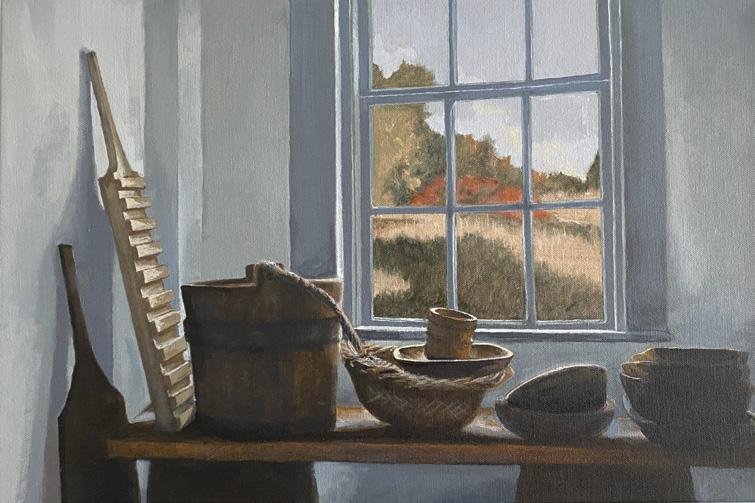
Doug Caves Sr Art Studio 1345 Rindge Road, Fitchburg, MA (978) 587-1085
dhcaves@live.com
dhcaves.com
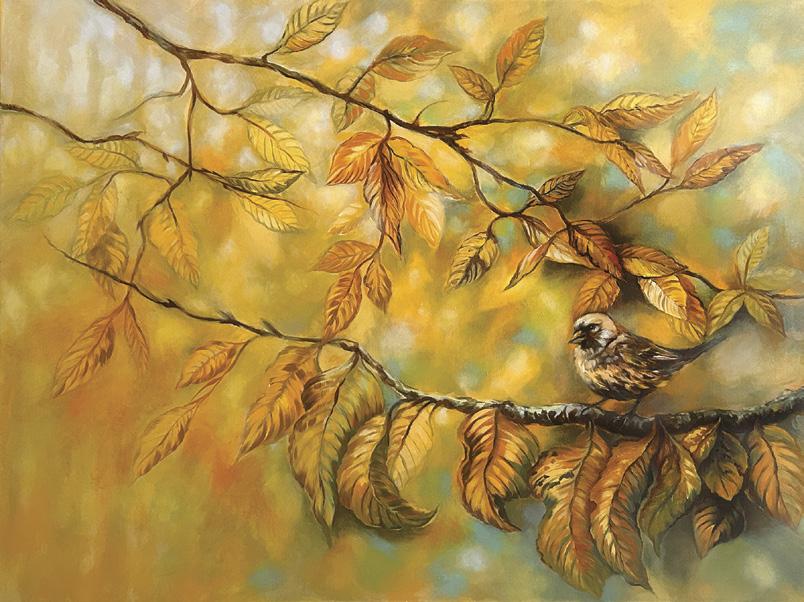
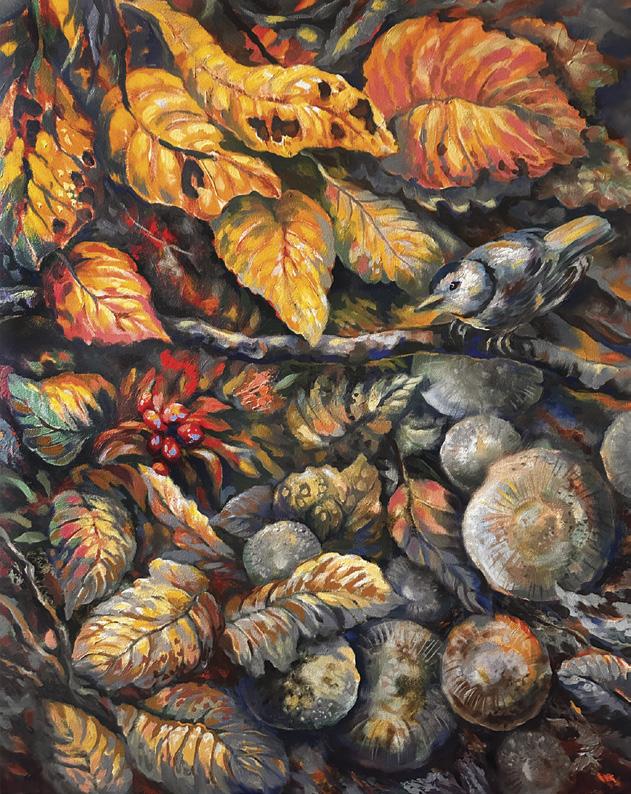
Joan Kocak
Represented by Three Stones Gallery 32 Main St., Concord, MA (978) 371-1333
info@threestonesgallery.com threestonesgallery.com
Meadow IV, 2023,
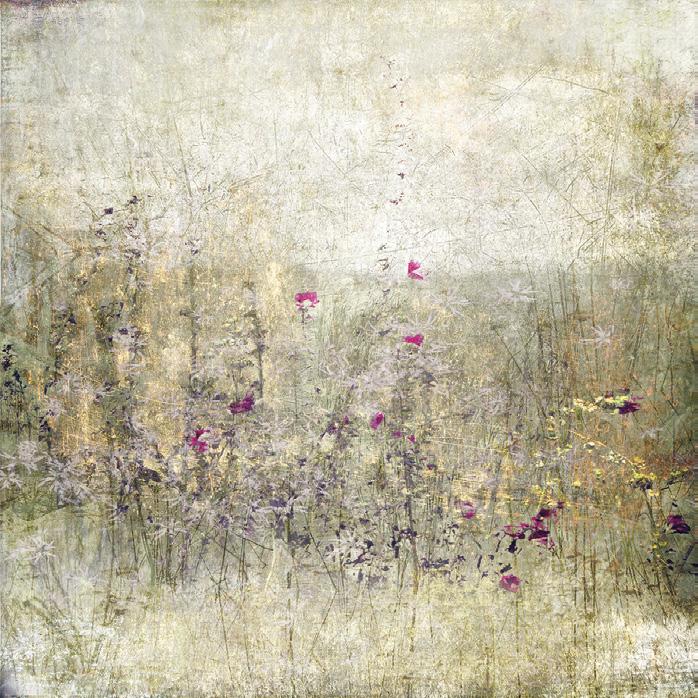
Bobbie Bush
Boston Portrait Artist 271 Western Ave., #112, Lynn, MA (978) 744-6918
bobbie@bobbiebush.com
BostonPortraitArtist.com
Specializing in commissioned portrait paintings of your loved ones
Story Time, 2021, mixed media painting, 11 x 14".

March/April 2024 | Art New England 45
Sweet Tomatoes, watercolor.
photographic encaustic, 24 x 24".
Saturday Morning, acrylic on canvas, 14 x 21".
Yellow Elm and Sparrow, oil on canvas, 36 x 48 x 2".
Bearberries and Bird, oil on canvas, 36 x 24 x 11/2".
Caleb Brown
Paintings with more than one side 46 Willowdale Rd., Groton, MA (978) 604-8043
studio@calebbrown.art calebbrown.art
Tamara Gonda Studio 24 Dow St., Pepperell, MA (978) 868-6976
TamGonda@gmail.com
TamaraGonda.com
Instagram @TamaraGonda.art
Summers and Winters, 2023, acrylic on canvas, 36 x 36".

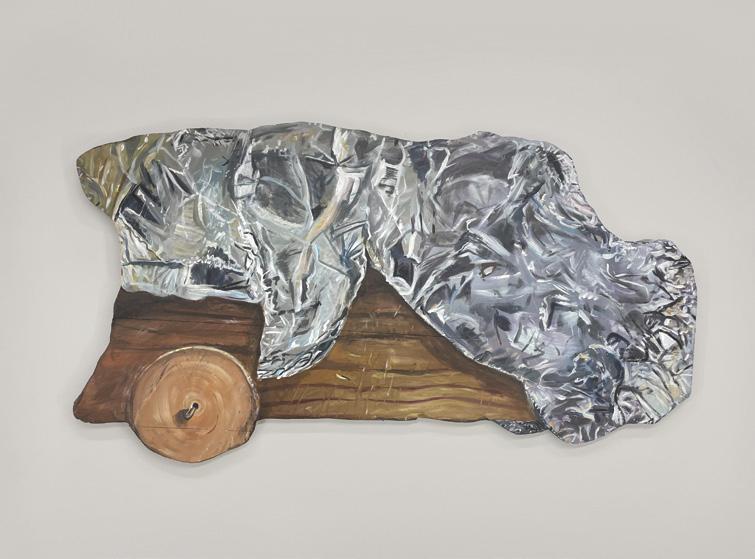

Joanne Tarlin Harpswell, ME (508) 542-2115
joannetarlin@gmail.com joannetarlin.com
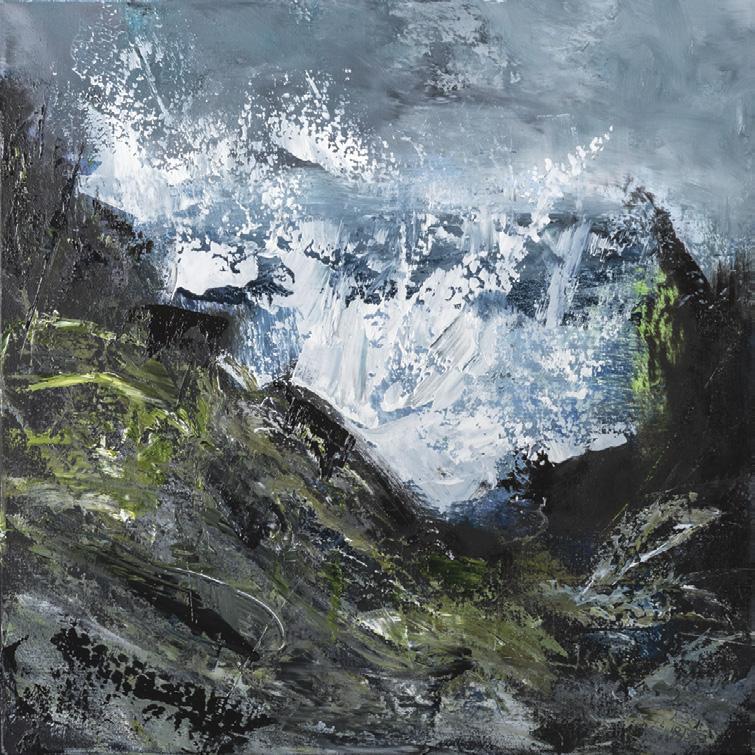
NW Cassidy Fine Art Conway, NH (603) 662-2074
nwcassidyfineart@gmail.com
nancycassidy.com


46 Art New England | March/April 2024
SPRING 2024
DIRECTORY
Bountiful Abundance, 2024, acrylics (metallic and matte), molding paste and composite metal leaf on canvas, 36 x 48".
Harmony, 2024, acrylics (metallic and matte), on cradled birch panel, 24 x 24".
Shop Car (obverse), 2024, acrylic on extruded polystyrene foam, approx. 25¼ x 47 x 1".
Shop Car (reverse), 2024, acrylic on extruded polystyrene foam, approx. 25¼ x 47 x 1".
Crash, 2023, oil on canvas, 20 x 20” .
Edith Beal Tuttle, Painter of Delight (603) 933-8059
edith@edithtuttle.com
edithtuttle.com
By appointment
Ingrid Scheibler (617) 669-9091
ingridscheibler.com
@IngridScheibler
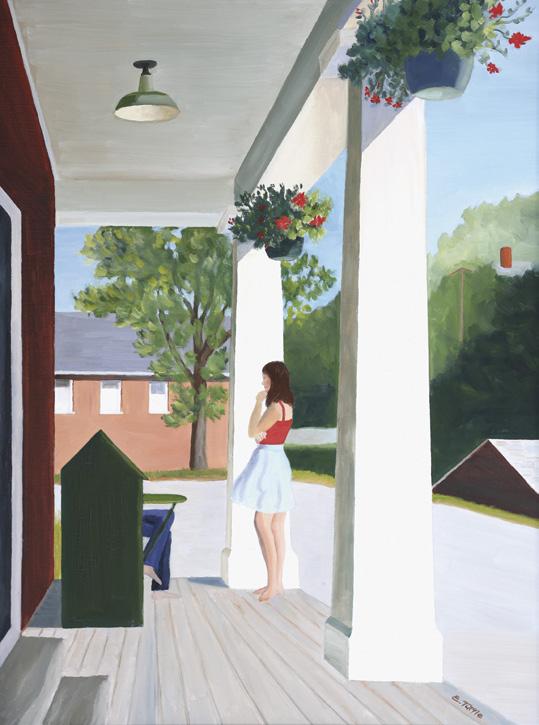
Julie C Baer Atlantic Works Gallery juliecbaer.art@gmail.com
@jcbaer_natureart juliebaer.com
(Psaltriparus
Burlingame,


Jill Goldman-Callahan
The Arts Umbrella Studio 303 40 Stow St., Concord, MA (203) 209-0115
jillgoldman-callahanstudio.com
Cherry Blossoms, acrylic/mixed media, 48 x 48".

Elise Freda (845) 701-1135
elise@elisefreda.com elisefreda.com

March/April 2024 | Art New England 47
Bushtit
minimus) in Fennel (Foeniculum vulgare),
2023, mixed media on wood panel, 36 x 36".
On The Porch, oil on linen, 24 x 18".
Flowering Trees, 2024, acrylic, 24 x 24".
Transport, mixed media, 24 x 36".
DIRECTORY
SPRING 2024

Margi Smith (978) 852-3828
margismithartworks@gmail.com margismithartworks.com
Kelly Holt Studio
316 Flynn Ave. #305, Burlington, VT (802) 498-3509
kelly@kellyholtart.com
kellyholtart.com
@kellyholtart
Firenze, 2022, archival digital photo collages and mixed media (acrylic, spray paint, graphite) on kozo paper mounted on birch panel,



Daylight Fading, 36 x 36".
Marcia Crumley
Expressive Landscapes
Cape Elizabeth, ME and 450 Harrison Ave., #225, Boston, MA (617) 794-6497
marcia.crumley@gmail.com
marciacrumleyart.com
@marciacrumleyart
Lori Pedrick
Peterborough, NH (215) 880-8494
info@loripedrick.com
loripedrick.com
@loripedrick
Bread Still Life Study II, 2024, archival inkjet print, 13 x 19".

48 Art New England | March/April 2024
24 x 24".
Dreams of Lagos, 2023, acrylic on paper, 24 x 18".
DESTINATION: NEW ENGLAND
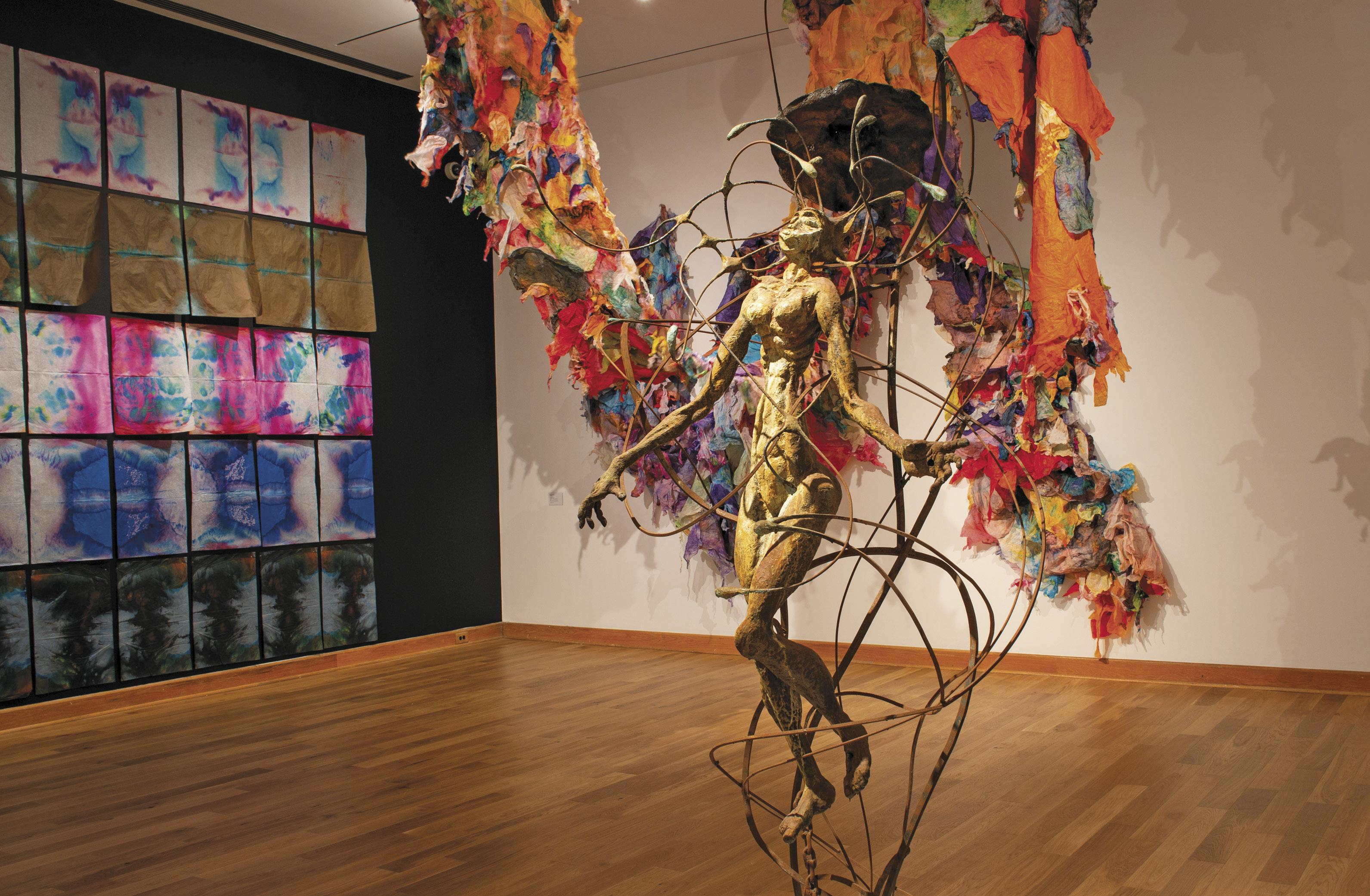
March and April enjoy the remnants of winter and the first signs of spring. They can be mysterious months, however. We’re never sure how long winter will last or if spring’s early appearance in some spots is to be believed. That’s why we love New England; she keeps us guessing.
One thing is for certain—the ebb and flow of art is ceaseless and seasonless. The destinations on these pages announce several of the most interesting and anticipated exhibitions of the year. It’s the perfect time to plan spring and early summer travel.
Currier Museum of Art—Manchester, NH
The Currier Museum of Art’s 2024 exhibitions begin with Kara Walker: Harper’s Pictorial History of the Civil War (Annotated), a touring exhibition
that showcases Walker’s art alongside the Winslow Homer illustrations that inspired it. As a young artist, Homer served as a war correspondent for Harper’s Magazine. His drawings of soldiers on the front lines of battle and civilians caught up in the war’s horrors became a visual history of the Civil War, and they were published after the war in the magazine’s 1866 two-volume anthology. Walker revisits these prints, utilizing her signature silhouettes to introduce new elements. She surfaces race and gender-based biases, highlights profound sociopolitical inequalities, and brings to the fore a silenced history of violence that complicates Homer’s initial narrative. Opening March 7, the Currier will present the work of French artist Raphaël Barontini (b. 1984) in an exhibition titled I live a journey of a thousand years. The exhibition
comprises about twenty works and is Barontini’s largest presentation to date at a U.S. institution. Closely following the commission titled We Could be Heroes at the Panthéon in Paris—part of the Carte blanche series organized by France’s National Monuments Center—the exhibition at the Currier features La Bataille de Vertières (2023) as its centerpiece, a monumental 65-foot-wide painting that first premiered inside the Panthéon and will be on view here in the U.S. for the first time.
Williams College Museum of Art Williams, MA
The Williams College Museum of Art (WCMA) creates and inspires opportunities for students, faculty, and the public to have meaningful experiences with art. New this spring is Emancipation: The Unfinished Project of Liberation, which visualizes
March/April 2024 | Art New England 49
SPECIAL ADVERTISING SECTION
Emancipation: The Unfinished Project of Liberation, on display through July 14 at the Williams College Museum of Art, visualizes what freedom looks like for Black Americans today and the legacy of the Civil War today and beyond. Photo: Bradley Wakoff.

what freedom looks like for Black Americans today and the legacy of the Civil War today and beyond. Highlighting the perspectives of contemporary Black artists, Emancipation features commissioned and recent works by Sadie Barnette, Alfred Conteh, Maya Freelon, Hugh Hayden, Letitia Huckaby, Jeffrey Meris, and Sable Elyse Smith. The seven installations span sculpture, photography, and paper and textile fabrications. Other highlights include Remixing the Hall, an ongoing exhibition of objects from the collection displayed in a loose thematic framework so that visitors can construct their own meaning from the myriad ways in which objects resonate with each other and with the present; and Object Lab, a hybrid gallery-classroom in which Williams College faculty work with WCMA staff each semester to select art that connects with course concepts. These works of art are then installed in the gallery, grouped by course. Through museum visits combined with close-looking assignments and digital projects, students engage deeply with the objects throughout the semester.
Lyman Allyn Art Museum
New London, CT
The Lyman Allyn Art Museum was founded in 1926 and opened its doors in 1932. In the more than ninety years since then, the Museum has gathered a collection of more than 17,000 objects and made its mark as a community landmark in Southeastern Connecticut. The Museum features changing exhibitions throughout the year. This spring, visitors will see the works of Connecticut artist Beatrice Cuming in Beatrice Cuming: Connecticut Precisionist, on view through May 26. Cuming was born in New York in 1903 and moved to New London in 1934. She depicted the
50 Art New England | March/April 2024 SPECIAL ADVERTISING SECTION
US @ARTNEWENGLANDMAGAZINE OR VISIT ARTNEWENGLAND.COM MARGARET BOURKE-WHITE MARIE HANSEN MARTHA HOLMES LISA LARSEN NINA LEEN HANSEL MIETH MARCH 6–JULY 7, 2024 47 Strickland Road, Cos Cob, CT | 203.869.6899 | greenwichhistory.org
FOLLOW

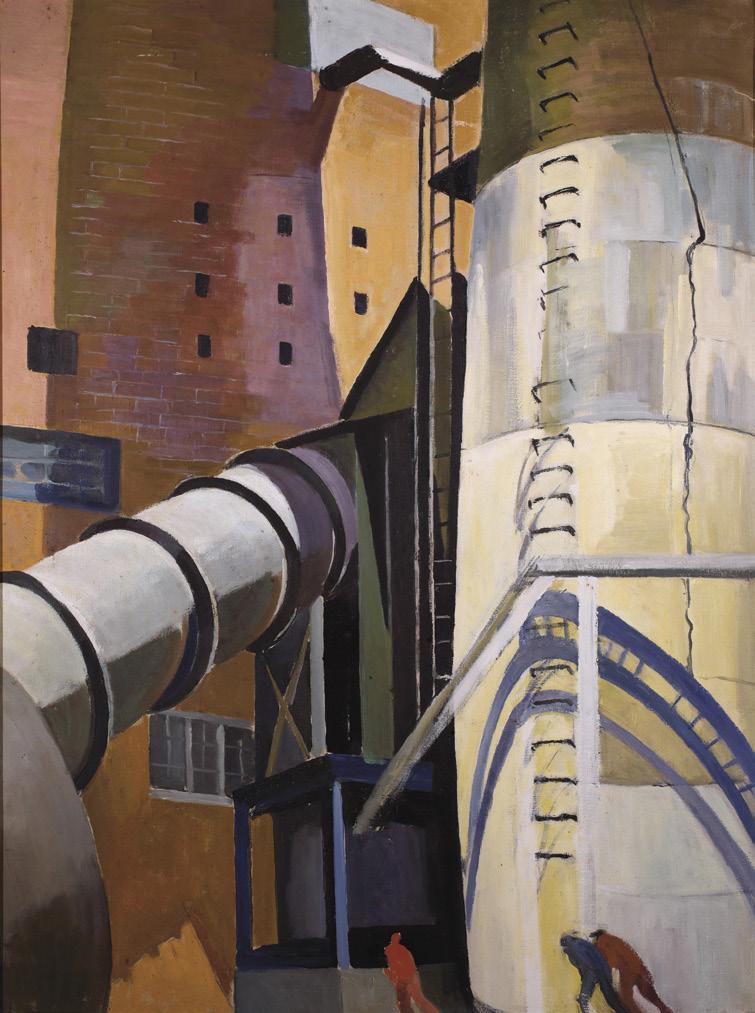
is on view through April 14 and is organized in conjunction with the Florence Griswold Museum in nearby Old Lyme. The Florence Griswold Museum’s companion exhibit, Fun and Games? Leo Jensen’s Pop Art is on view through May 19.
LIFE: Six Women Photographers is on view from March 6 through July 7. The exhibition features over seventy images from female photographers Margaret Bourke-White (1904–1971), Marie Hansen (1918–1969), Martha Holmes (1923–2006), Lisa Larsen (circa 1925–1959), Lina Leen (circa 1909–1995) and Hansel Mieth (1909–1998). LIFE founder and editor-in-chief Henry R. Luce, longtime Greenwich resident, pushed for photojournalism, and coined “photo essays,” to shape people’s vision of America. For decades, Americans saw the world through the lens of the photographers at LIFE. The six artists featured in this exhibition were the only women photographers employed full-time by LIFE magazine from the late 1930s to early 1970s. The GHS campus includes a nationally accredited museum, library and archives, a museum store, café and a community education center.
urban and industrial landscape of New London in her work, and described the views of the city as “obviously beautiful, powerful, dramatic [and] exciting.” The exhibit boasts more than forty paintings and works on paper. Also on view this spring is Art in Play: Leo Jensen, exploring the work of pop artist Leo Jensen, whose work in a wide variety of mediums draws inspiration from his life in the circus and rodeo. This exhibition
Greenwich Historical Society Cos Cobb, CT
Greenwich Historical Society (GHS) was founded in 1931 to preserve and interpret Greenwich history to strengthen the community’s connection to the past, to each other and to the future. The circa 1730 National Historic Landmark Bush-Holley House in which the GHS is housed became the site of Connecticut’s first American Impressionist art colony from 1890 to 1920.
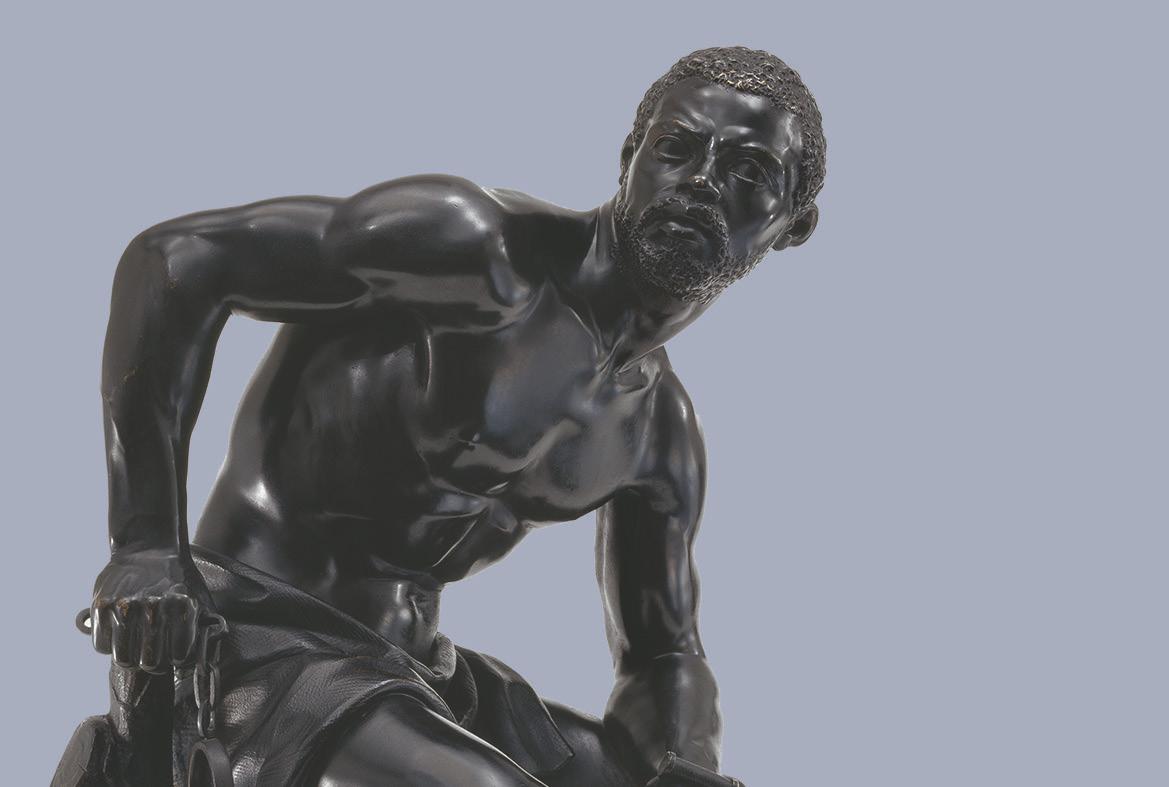
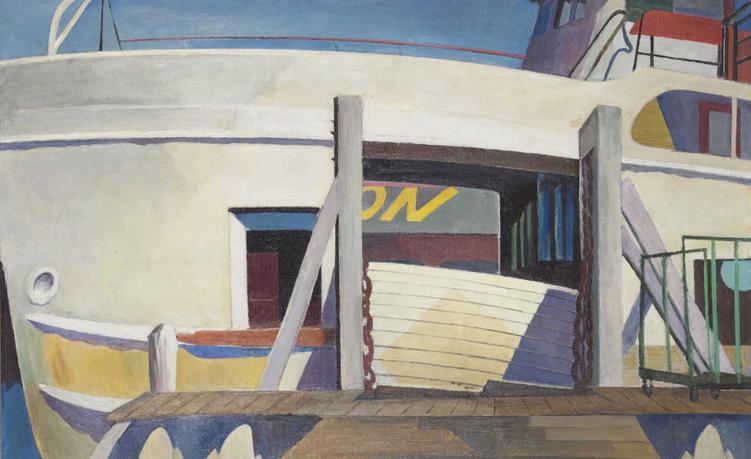
March/April 2024 | Art New England 51 Lyman Allyn AR T MUSEUM 625 Williams Street New London, CT 06320 Exit 83 off I-95 BEATRICE CUMING: Connecticut Precisionist Feb. 24 - May 26, 2024 Impact of White detail, ca. 1951, oil on canvas. Museum Purchase, 1968.107. SPECIAL ADVERTISING SECTION
15 Lawrence Hall Drive | Williamstown, Massachusetts | artmuseum.williams.edu Free Admission | Catalogue Available John Quincy Adams Ward, The Freedman, 1863 WILLIAMS COLLEGE MUSEUM OF ART
16–JULY 14, 2024
Above, from left: Nina Leen, unpublished photograph from “American Woman’s Dilemma,” LIFE, June 16, 1947. © LIFE Picture Collection, Dotdash Meredith Corp; Beatrice Cuming, Industrial Scene, Montville Stacks, ca. 1938, oil on canvas. 35½ x 27¼". Mystic Museum of Art Permanent Collection, Donated by Otto E. Liebig.
FEBRUARY
Art Schools + Workshops
SCHOOLS
College of Visual and Performing Arts University of Massachusetts Dartmouth 285 Old Westport Road Dartmouth, MA 02747 (508) 999-9295
cvpainfo@umassd.edu
umassd.edu/cvpa
CVPA, The College of Visual and Performing Arts, is a comprehensive arts college with Bachelor’s and Master’s programs that include studies in art + design, art education, art history, and music.

Concord Art
Contact: lisapohl@concordart.org
37 Lexington Road Concord, MA 01742 (978) 369-2578
concordart.org
From accomplished artists to those just beginning or seeking to try something new, Concord Art offers adult classes and workshops for everyone. Their faculty—painters, printmakers, sculptors, and more— are among the best at their creative focus and instruction.

Danforth Art School at Framingham State University
14 Vernon Street, Floor 3 Framingham, MA 01701 (508) 215-5116
danforthartschool@ framingham.edu
danforth.framingham.edu
Danforth Art School offers exceptional art classes for all ages and experience levels. Featuring

several innovative workshops on weekends for adults in addition to weekly study in painting, drawing and printmaking. Fun, museumcentered classes for children afterschool and on Saturdays.

Fuller Craft Museum
455 Oak Street Brockton, MA 02301 (508) 588-6000
kbrinson@fullercraft.org fullercraft.org
Find the Maker in you at Fuller Craft
Museum! The Museum offers a wide variety of craft media classes and workshops, including a full suite of ceramics courses. They’re pleased to offer scholarships to classes in order to increase access to the arts. Email Kendall Brinson at kbrinson@ fullercraft.org with any questions.
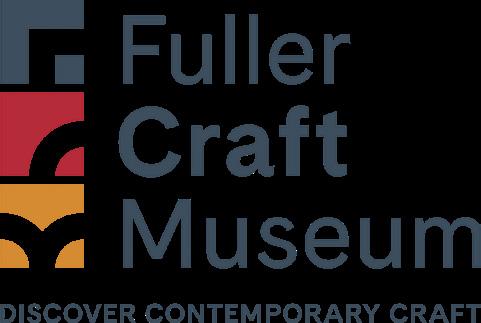
Marlboro Studio School
P.O. Box 28 Marlboro, Vermont 05344 school@marlborostudioschool.org marlborostudioschool.org
Marlboro Studio School is an all-levels arts program in the hills of Southern Vermont offering studio classes and residential workshops in craft and fine art media including ceramics, jewelry, printmaking, drawing, painting, sculpture, and more.

52 Art New England | March/April 2024
Above: Marlboro Studio School in Marlboro, VT.
Montserrat College of Art
23 Essex Street Beverly, MA 01915 (978) 921-4242
communications@montserrat.edu montserrat.edu
Montserrat College of Art is a private college of art, design, and visual communications in historic, coastal Beverly offering the Bachelor of Fine Arts Degree in 10 concentrations and five minors, including Art Education.

North Bennet Street School
150 North Street Boston, MA 02109 (617) 227-0155
info@nbss.edu
nbss.edu/CE
Elevate your art, or explore an entirely new discipline. NBSS offers intensive, hands-on training and an inspiring community. Beginner through advanced classes in bookbinding, jewelry making, furniture making, carpentry, and musical instruments. Located in Boston’s historic North End.
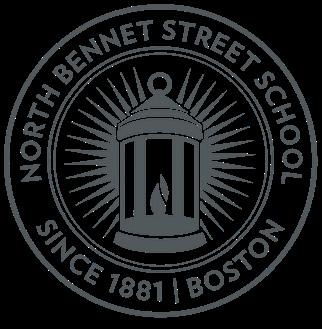
WORKSHOPS
David Skinner Painting Workshops
(828) 774-8431
dpskinner@earthlink.net dskinner.net
Join contemporary landscape painter David Skinner for weeklong painting workshops in Italy and Ireland. Art supplies are provided, along with guided tours, delicious meals, and wonderful camaraderie. For 2024, wait list now open for Italy and just four spots available for Ireland. For more details and to book for summer 2025, go to dskinner.net.

Truro Center for the Arts at Castle Hill & Edgewood Farm
10 Meetinghouse Road P.O. Box 756
Truro, MA 02666 (508) 349-7511
info@castlehill.org
castlehill.org
Truro Center for the Arts offers events and programming in art, writing, and much more in an idyllic Cape Cod setting. Workshops include painting, printmaking, ceramics, sculpture, photography, jewelry, fiber, culinary arts, and kids programming.
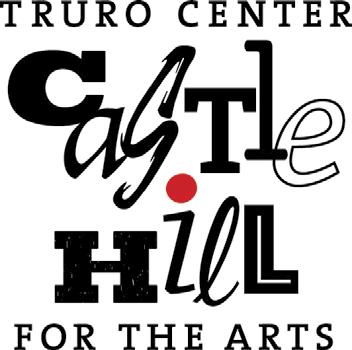
Watermark Press Printmaking Studio
Contact: Martha Jeffrey Galuszka 30 Arbor Street #205 Hartford, CT 06106 (860) 930-5491
watermarkprs@aol.com
watermarkprs.com
A premier fine art studio specializing in chemical-free processes custom tailored to your printmaking interests. Etching press: monotype, intaglio, drypoint, carborundum, solar plate, pronto plates; Vandercook: relief, monotype and polymer letterpress. Private lessons, flexible schedules, and free press time.

UPCOMING DEADLINE for
Guide to Art Schools and Workshops
May/June 2024
Space Reservation: March 22, 2024
Materials Due: March 29, 2024
The Guide to Art Schools and Workshops also appears online at artnewengland.com
March/April 2024 | Art New England 53
Above: David Skinner Painting Workshops in Italy.
Art Guide
Arts and Cultural Events Across the Region CONNECTICUT
The Sue and Eugene Mercy Jr. Gallery
Art Museum at University of St. Joseph

Valerie Hammond and Nathaniel (Tate) Klacsmann

Valerie

April 2 – June 2, 2024





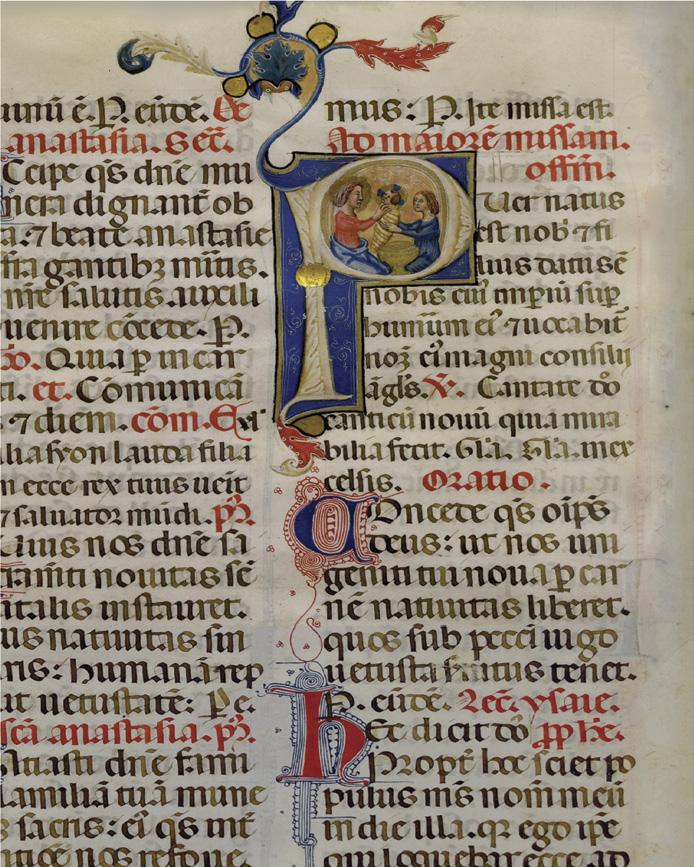
54 Art New England | March/April 2024
Tremaine Art Galler y
Dialogue: Art in Conversation
Hammond, The Birds Had Flown, 2023
Blue Swa l lows a n d B l a kc Mhto s 2 3202
NathanielKlacsmann
usj.edu/artmuseum
Tremaine Gallery
–
by the Reading Public
Reading, Pennsylvania.
Painted Pages: Illuminated Manuscripts, 13th
18th Centuries, is organized
Museum,
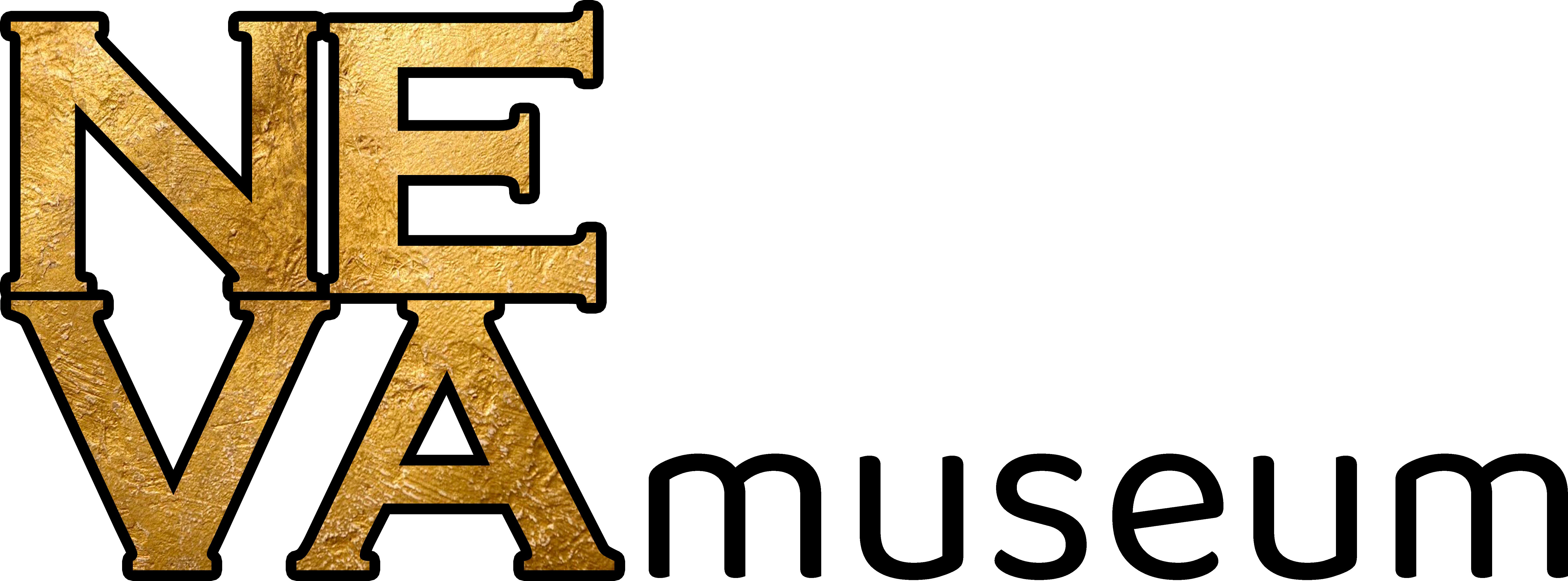

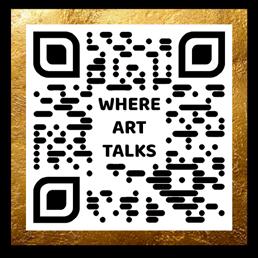
518 Pleasant Street, Northampton MA 01060 neva-museum. org (413) 588-4337





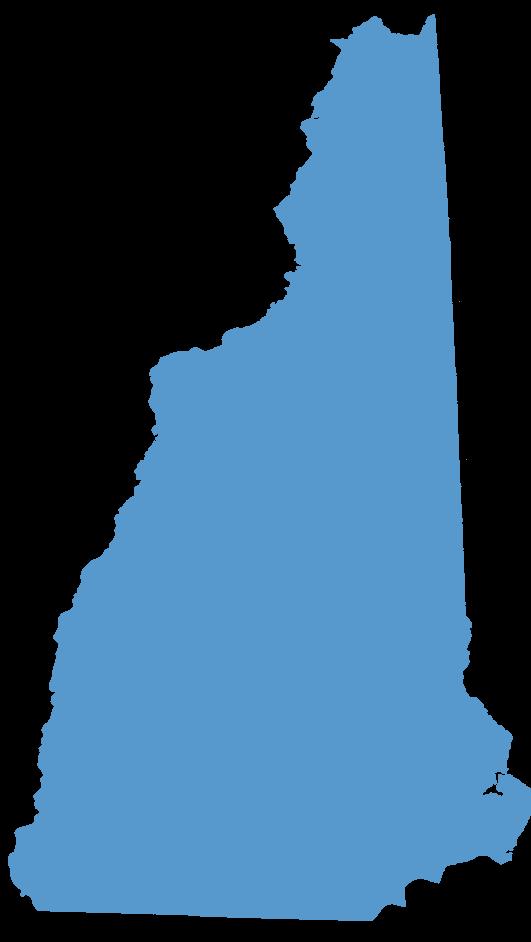
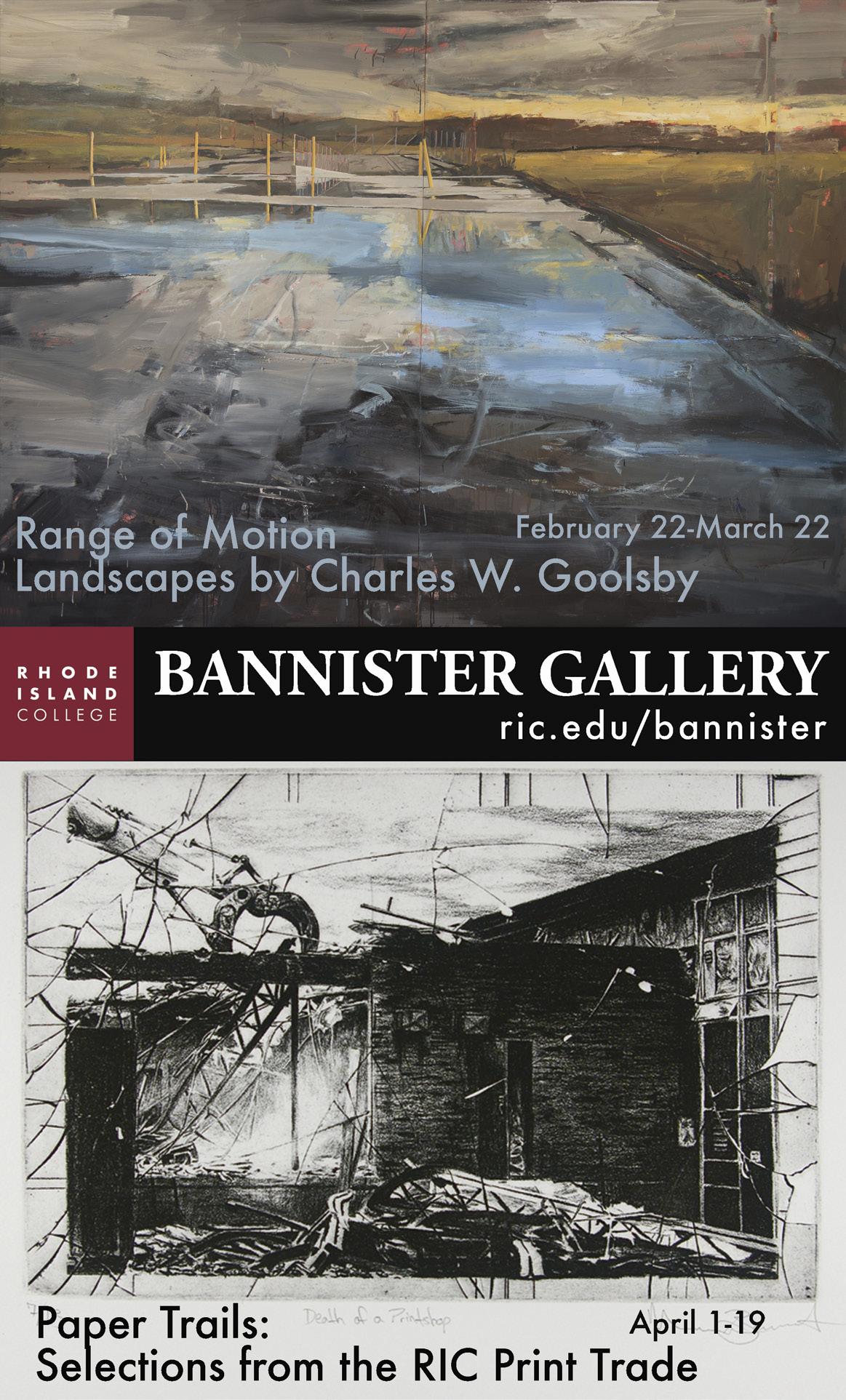
56 Art New England | March/April 2024 RHODE ISLAND Bannister Gallery NEW HAMPSHIRE Lamont Gallery Artist and Writer Coaching (Individual & Group) | Arts Consulting | Custom Publishing | Web Design | Digital Production | Portfolio Reviews | Workshops MAKE YOUR MARK—WE’LL DO THE REST Contact Rita Fucillo for more information rita@artnewengland.com | 857-366-8131 New England CONTEMPORARY ART AND CULTURE Creative Services HIDDEN TREASURES 6 M A R C H 1 9 – A P R I L 1 3 , 2 0 2 4 Lamont Gallery Phillips Exeter Academy www exeter edu/lamontgallery KELLY MCGAHIE Sweet Spot Durham NH 2023 Digital photograph CLOTHESLINE PROJECT at Exeter April 19-May 11, 2024 PEA096_artne_6th_Hidden 6.qxp 2/6/24 9:13 AM Page 1
Father and Daughter: William Zorach and Dahlov Ipcar
Maine Jewish Museum, Portland, ME • mainejewishmuseum.org • Through May 3, 2024
In a televised interview with the legendary broadcast journalist Edward Murrow in 1957, William Zorach (1887–1966) was asked what art is. The sculptor replied, in part, “Art is love. It’s a feeling so intense that the artist has to record it for humanity.”
As Zorach showed Murrow his studio, he stopped at a cast of Head of Moses, which he explained was originally carved from Labrador granite. Later cast in bronze in an edition of six, one of which appears in this exhibition, the piece is a bold rendering of the bearded prophet looking skyward, his gaze placid yet profound.
The head of Moses is part of a group of what guest curator Rachel Walls calls “deeply personal works” Zorach created between 1949 and 1956 in response to the Holocaust and World War II. Each of the seven bronzes reflects that “humanity” he told Murrow he sought to convey in his art.
Refugees and Their Annihilation (Woman and Child) remain moving and relevant seventy or so years after their making. Another poignant piece,

The Prayer, represents a kneeling man exhorting the heavens. The sculpture had several alternative titles over the years, including I Will Lift Up My Eyes unto the Mountains, borrowed from Psalms 121 1-2.
Zorach was also a fine watercolorist with a keen sense of place as evidenced by eleven
paintings in the show. Made during his stays at Georgetown, Maine, between 1945 and 1956, they offer lively renderings of local spots in the southern midcoast region: Popham Beach, Five Islands Harbor, Spinney’s Wharf, and the Kennebec and Sheepscot rivers.
Zorach and his wife, painter and textile artist Marguerite Zorach (1887–1968), encouraged their daughter, Dahlov Ipcar (1917–2017), to pursue creative activities from an early age, providing supplies and surrounding her with modern art. As curator Walls notes, Ipcar was her parents’ “greatest creative experiment.”

In 1939, at age twenty-one, Ipcar showed oils, watercolors, embroidery, drawings, and prints, plus ceramics and wood carvings, at the Museum
roosters and horses—to the wild: zebras, giraffes, tigers, and other creatures. “Animal life,” critic Edgar Allen Beem wrote, was the “armature to which Ipcar applied pattern and color.”
Ipcar’s remarkable sense of design is on full display. Works like Year of the Rooster, Gold and Silver, and Cats Entwined are delightful arrangements of feathers and fur while Harlequin Jungle, Island of King Minos, and the amazing cloth collage Garden of Eden exemplify her kaleidoscopic visions. An early two-sided screen, Winter in Maine, 1935, manifests both her love of horses and her appreciation of country living.
Ipcar had a special passion for the story of Noah and his ark. In the 1971 oil Embarkation, Noah and his family herd the animal pairs onto a great sailing ship as storm clouds form in the sky. A peaceable kingdom effect occurs as the creatures converge to climb the gangway, led by two horned beasts.
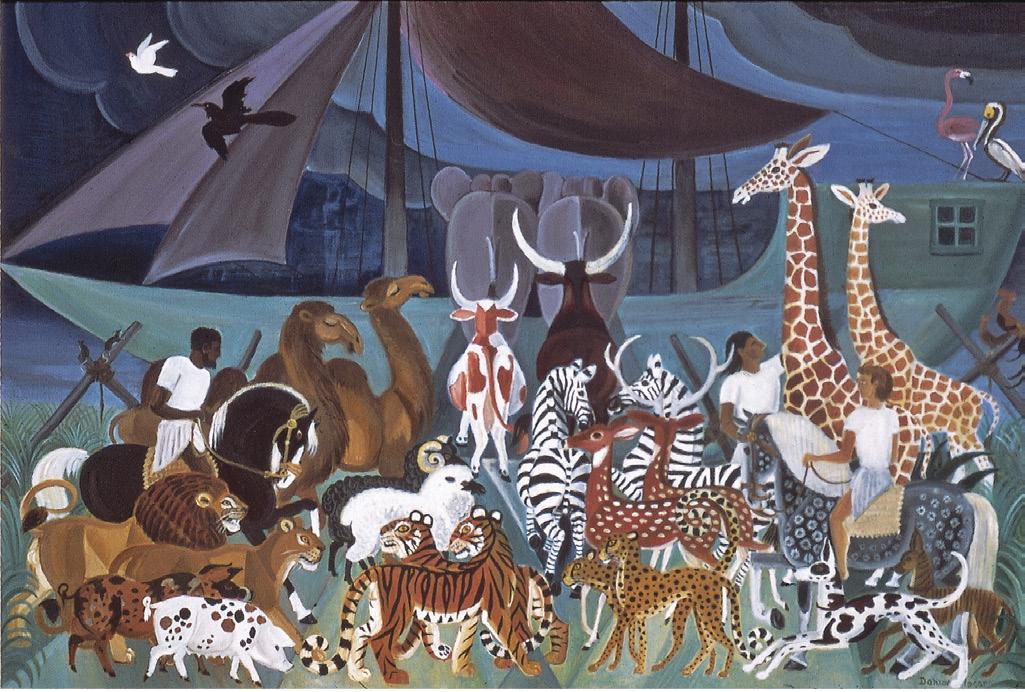
of Modern Art. With Creative Growth: Childhood to Maturity, she became the youngest artist and the first woman to have a solo show at MoMA.
The twenty pieces in the Maine Jewish Museum show highlight Ipcar, the brilliant animalier. Her repertoire ranged from the domestic—cats and dogs—to the barnyard—
Marguerite Zorach makes a cameo/art appearance through an unfinished portrait of her daughter and a delightful tapestry, The Ipcar Family at Robinhood Farm, 1944, showing Dahlov and her husband Adolph and their two boys in the kitchen of their Maine home. She and her husband are also represented by a pair of portraits Ipcar painted of them in 1944.
In addition to her fine art work, which included paintings, prints, soft sculpture, and rugs, Ipcar was an acclaimed children’s book author and illustrator. Last year the Society of Illustrators awarded her a posthumous Lifetime Achievement Award in recognition of her innovative and pioneering contributions to the field of children’s book illustration. She brought that same creative spirit to all her work. — Carl Little
March/April 2024 | Art New England 57
SPOTLIGHT REVIEW
Above, from left: Dahlov Ipcar, Portrait of My Mother, Marguerite Zorach, 1944, oil on canvas. Courtesy of Rachel Walls Fine Art; Dahlov Ipcar, Embarkation, 1971, oil on linen, 26 x 38". Courtesy of Rachel Walls Fine Art. Top: William Zorach, Head of Moses, bronze, edition 6/6, modeled in 1956. Courtesy of Gerald Peters Gallery.
Women Reframe American Landscape
New Britain Museum of American Art, New Britain, CT • nbmaa.org • Through March 31, 2024
In this intergenerational, traveling group exhibition, the first room of its contemporary section includes a commissioned poster by the Guerrilla Girls. A “Reality Check” about the Hudson River School—a 19th-century group of artists who painted idyllic landscapes of New York’s Hudson River Valley—its first line reads: “It wasn’t a school, it was a club… of white men!” Through its placement and its critiques, the poster serves as a hinge between the historical Hudson River era works—Susie Barstow and Her Circle—and the present-day pieces—Contemporary Practices—on view at the New Britain Museum.
Thomas Cole is considered the “founder” of the Hudson River School, so it may surprise some visitors that the stewards of his work would decenter Cole’s “club” and “[recenter] women in the history of American art and [expand] how we see land and landscape”; however, this exhibition is part of a lineage of curators and artists interrogating dominant social and historical narratives—an approach that gained traction in the early 1990s with projects like artist Fred

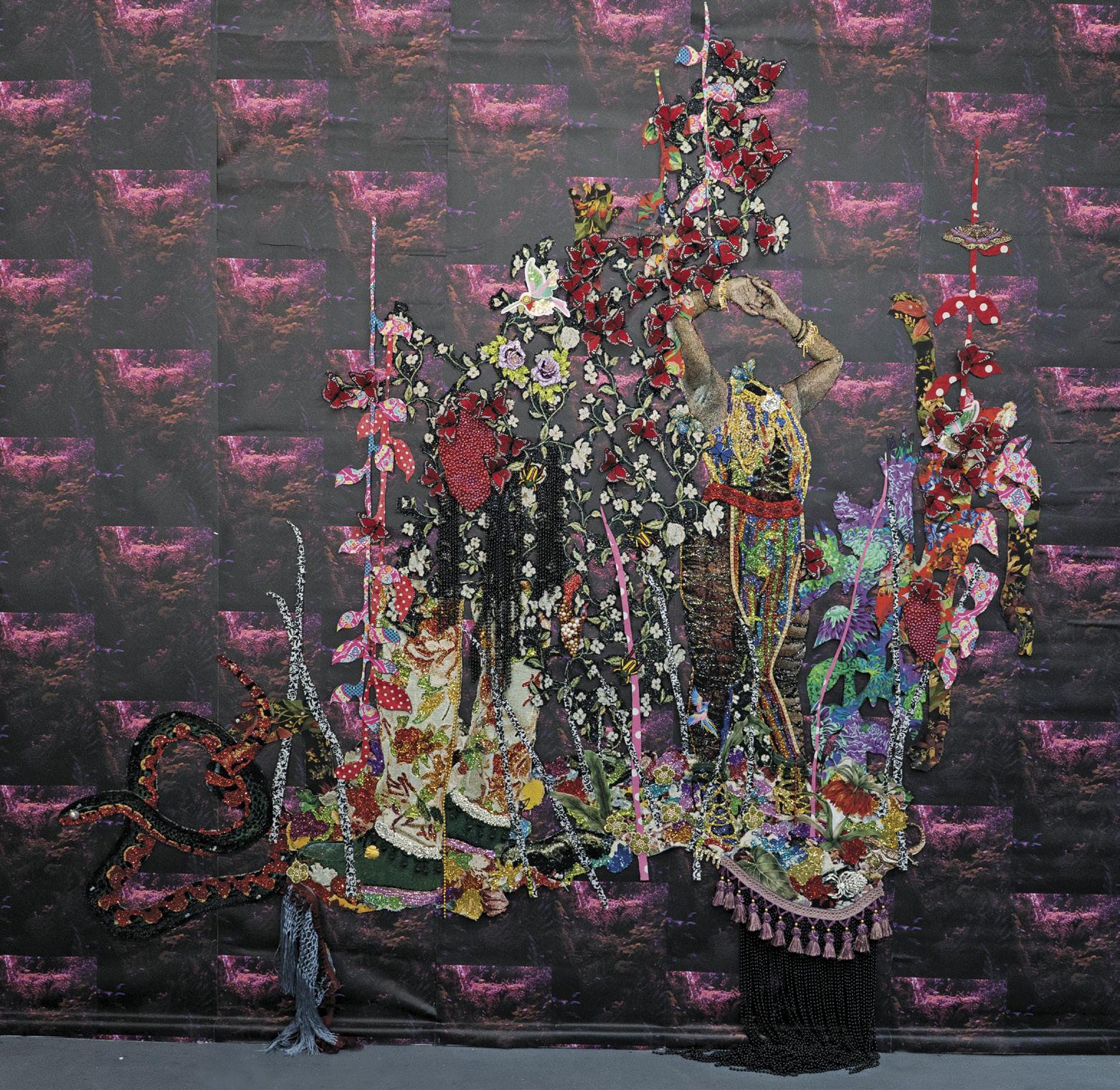
Wilson’s Mining the Museum (1992), which foregrounded racist histories in the Maryland Historical Society’s collection; and Mary Jane Jacob’s public art project Places with a Past (1991, Charleston, SC) where artists created site-specific installations that shone light on marginalized local histories. Similarly, since 2015 the Cole Site’s curatorial programming has engaged in contemporary art projects that respond to the contexts of their own history and location.
At the New Britain Museum, this thoughtfully arranged exhibition begins with paintings by Susie Barstow and six women artists in her orbit. Barstow’s paintings are skillful and often feature dense forest scenes that are moody and divinatory. The exhibition also includes sketches by Barstow, her painters box, and photographs of the artist. Through wall texts, the
Above: Ebony G. Patterson, ...the wailing...ushers us home...and there is a bellying on the land..., 2021, mixed media on jacquard woven photo tapestry and custom vinyl wallpaper, approximately 96 x 104". Courtesy the artist and Monique Meloche Gallery, Chicago, IL. Left: Guerrilla Girls, Guerrilla Girls Reality Check: The Hudson River School, 2023, ink on vinyl, 88 x 52". © Guerrilla Girls. Opposite: Jaune Quickto-see Smith, Stolen Map / $ Map, 2021, beads, 8¼ x 12". Courtesy the artist and Garth Greenan Gallery, New York, NY.
viewer learns that Barstow traveled extensively, often with her life partner, Florence Nightingale Thallon; sold works at prominent New York galleries; and was “recognized continuously in the press as an important artist.” This is the “first solo show dedicated to a woman artist painting landscapes in the style of the Hudson River,” opening one hundred years after Barstow’s
58 Art New England | March/April 2024
SPOTLIGHT REVIEW
death, which further highlights art history’s erasure of her work.
The exhibition’s contemporary works reframe the landscape genre itself, primarily using an intersectional feminist lens that considers gender, indigenous histories, environmentalism, and more. For example, Jean Shin’s sculptures repurpose discarded crates made for traveling Cole’s guitar, gem collection, etc., and fills them with her “artist’s project remnants” (denim, pottery shards, cords) and dirt from the Cole house, continuing Shin’s inquiry into how “industry and global economies change the land and its very make up.” Here, she also is highlighting waste in the art world with its “traveling exhibitions that require cross-country shipping and robust wooden art crates, which are often disposed of afterwards,” arguably implicating the traveling exhibition in which her own work appears. Considering power dynamics and landscape, Teresita Fernández and Ebony G. Patterson simultaneously recognize violent histories on U.S. soil while “illuminating the possibilities of a generative relationship with land.” In other works, Indigenous artists Wendy Red Star and Jaune Quick-to-See Smith “examine land theft and displacement, and ask: Who owns the land and who has the power to name it?”

The New Britain Museum is the first stop after this exhibition’s inaugural installation at Thomas Cole’s house and studio. Having seen both iterations, the curators (from both venues) did a superb job of transitioning the show from a domestic space to the Museum’s largescale galleries. And while the historic site that
inspired this exhibition can’t travel with it, the diverse and elucidating perspectives it inspired most certainly will. — Terri C Smith
All quotes in this article are curatorial texts excerpted from the exhibition’s wall labels.
REVIEW: MAINE
The Portland Show
Greenhut Galleries, Portland, ME • greenhutgalleries.com • Through April 27, 2024
Greenhut Galleries has been showcasing images of its home city for a quarter century, soliciting artists from across the state and beyond to share their visions of Portland. This, their 12th biennial show features 43 artists responding to the Forest City from diverse angles and in a variety of mediums.
The city’s precious working waterfront is a perennial focus. This time around Philip Frey, Tom Glover, Jeff Bye, and Roy Germon, among others, find their muse along the wharves. Frey and Glover turn to bright colors in their respective images of the Custom House Wharf. Bye’s and Germon’s riffs are more subdued yet no less redolent of the harbor milieu.

Portland’s architecture gets its fair share of attention. C. Michael Lewis offers a remarkable study of monumental arches and a handsome bird’seye view of Back Cove as it looked in 1913. Thomas Connolly, who is known for his portraits of buildings, turns his attention to a vintage three-story apartment house on Marshall Street in the city’s West End.
Two linocuts by Daniel Minter evoke the Abyssinian Meeting House, the third oldest standing African American meeting house in the United States,
as it looked in 2017 when the artist installed a show of his work there. Minter fills the woodbeamed structure with objects and figures associated with the history of Maine’s Black communities.
In her City View from Altitude, Jenny Scheu regards the city from on high, abstracting blocks and byways into a becoming crazy quilt. Equally complex and striking is Chris Beneman’s Around Town, a representation of the seaside city under constant construction, replete with cranes and scaffolding.
Not all is hunky-dory. In one of his signature paintings that features interlocked lettering, Ryan Adams evokes profit and loss. Elsewhere, Tom Hall’s dark Tent City references the ongoing tensions around homelessness.
Such mainstays of the Portland Show as Tina Ingraham, Alison Goodwin, Lindsay Hancock, William Irvine, Matt Blackwell, Nancy Morgan Barnes, Grant Drumheller, Alison Rector, Alice Spencer and Richard Wilson are joined by a number of first-timers. With each iteration this tribute to Longfellow’s “beautiful town…seated by the sea” expands and deepens.
— Carl Little
March/April 2024 | Art New England 59
Daniel Minter, Meeting House I, linocut, 16 x 24¾". Courtesy of the artist.
The Myth of Normal: A Celebration of Authentic Expression
MassArt Art Museum, Boston, MA • maam.massart.edu • Through May 19, 2024
The experience of The Myth of Normal: A Celebration of Authentic Expression, an alumni exhibition at MassArt Art Museum, begins before visitors enter the building. The Majestic by Cedric Douglas (Class of 2011), large portraits of two poised MassArt students, spray painted on vinyl, reigns over the museum’s entrance. And even higher, where “Boston Normal School” is etched into the building’s 19th century façade, Steve Locke (’97) highlights “normal” in pink neon to call out that the museum occupies what once was a “normal school” that trained art teachers. But art is everything other than normal.

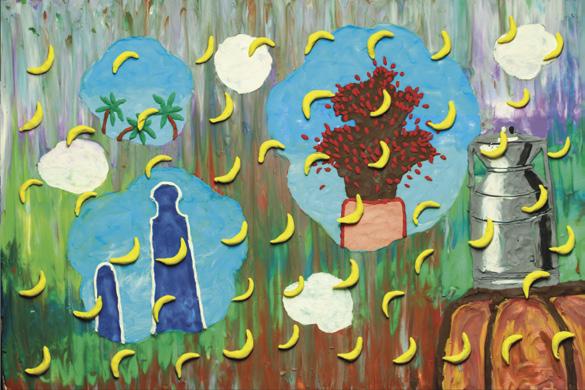

Presented in honor of the 150th anniversary of Mass College of Art and Design, the nation’s only independent public college of art and design, the exhibition showcases the experiences and creations of 30 MassArt alumni. It draws its inspiration, according to guest curator Mari Spirito (’92), from the 2022 book, The Myth of Normal: Trauma, Illness, and Healing in a Toxic Culture, by renowned physician Gabor Maté and his son Daniel. The book posits that cultural and social norms, especially the mainstays of capitalism, competition and individualism, negatively impact our overall well-being. Maté maintains that authentic expression is a key means to treading the pathway to health and wholeness. (Copies of the book and explanatory guides are placed throughout the exhibition.)
“When Maté’s book came out,” says Spirito, “it was in line with so many conversations I was already having with Mass Art alumni who are addressing pain and justice. It was clearly a timely, compassionate fit.”
Spirito has divided the exhibition into three, thematically related sections. Presented in the first-floor galleries, the initial zone addresses the body as architecture that must bear societal constraints and personal trauma. Lead Paint by Kate Finneran (’92) pictures a
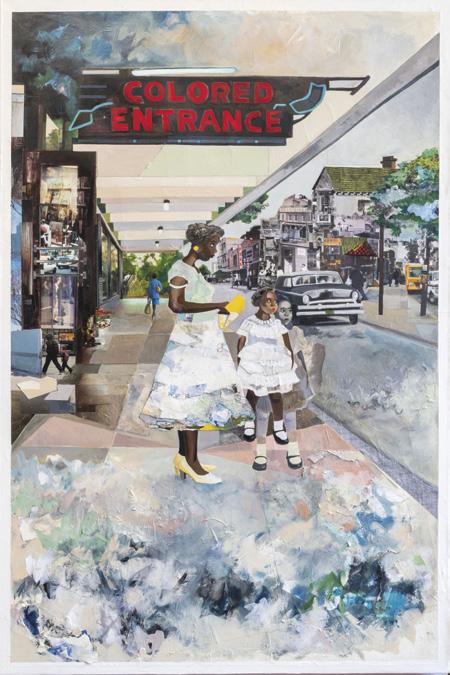
cat backed into a corner (subbing for a dislocated human?), by a window that reveals an inviting but unreachable garden. Paying homage to Gordon Park’s iconic photograph Department Store, Mobile Alabama, Chanda Méndrez-Ortiz (’05) in her painting Parks Entrance expands, with magazine photos and her personal archives, the narrative of a family living in rural Alabama to covey the lurking tension and terror. The second gallery brings personal stories and untold histories into the open—artists observing and sharing through various media. An Accident, a gigantic weaving by Erin M. Riley (’07), magnifies a bloodied and bruised hand, as if splayed on the floor in the aftermath of domestic violence. One wall features a bank of four engaging videos, each with its own restaurant-like booth for up-close viewing and discussion. In Una Favola Vera (A True Fairytale), Ezra Wube (’04) portrays the story of Italy’s 1935 invasion of Ethiopia though stop animation that recalls William Kentridge’s political videos, only more colorful and playful. But the rise of Mussolini’s visage underscores that this is war.
Above: Ezra Wube. Una Favola Vera (A True Fairytale), 2020, HD single-channel video, sound, 8 minutes 9 seconds. Courtesy of the artist and Microscope Gallery, NY. Below: Stephen Hamilton. Worshippers of the Water Spirit, 2022, acrylic, natural dyes, and pigments on copper, wood, denim, and handwoven cotton cloth, 110 x 108". Courtesy of the artist and special thanks to LaiSun Keane Gallery, MA. Bottom: Chandra MéndezOrtiz. Parks Entrance, 2023, mixed media collage on canvas, 60 x 40". Courtesy of the artist and Gallery Kayafas, MA.
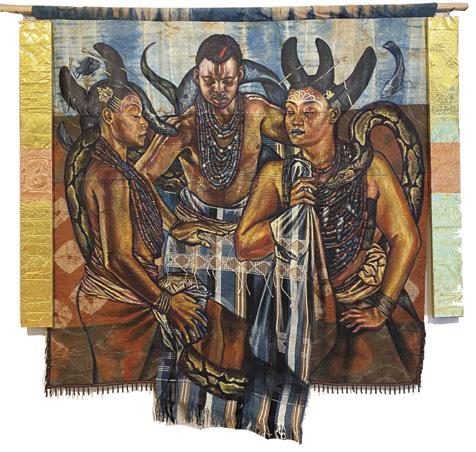
Ogun, Stephen Hamilton (’09) uses acrylic, copper, denim, and cotton cloth to portray commanding figures in ceremonial costumes, reverentially evoking the religious traditions and deities of the Yorùbá people of West Africa and paying tribute to his own origins.
In her huge mural, Tryzub Trio, a symphony of circus-like color and shape, Maya Hayuk (’91) riffs off the Ukrainian trident, in salute to her Ukrainian heritage. At the bottom right of her mural, she’s scrawled “CЛABA YKPAÏHI,” which means “Glory to Ukraine.” The patterns in the blown-glass orbs, Apricot Shimmer and Laguna Shimmer by Nancy Callan (’96), suggest a sorrow-defying dance of joy.
Onto the third section, in the open and bright upstairs gallery, “an exhale of expression,” as dubbed by Spirito, offers up a glorious outburst of authentic expression. In his large wall-hangings, Worshippers of the Water Spirits and Iya
“This exhibition provides an additional space of conversation, solidarity, and reflection, which all supports the on-going healing process,” says Spirito. “Ideally, all the art in The Myth of Normal together creates the presence of connection.” Artists necessarily strive to express themselves authentically. In the strivings of the artists of The Myth of Normal, there’s an expression of hope that their creations and the public experience of their work can help remedy modern society’s root maladies. — Jack Curtis
60 Art New England | March/April 2024
SPOTLIGHT
REVIEW
As the World Burns: Queer Photography and Nightlife in Boston
Tufts University Art Gallery, Boston, MA • artgalleries.tufts.edu • Through April 21, 2024
Presented simultaneously with Christian Walker: The Profane and the Poignant, As the World Burns: Queer Photography and Nightlife in Boston takes a deep dive into the photography of Boston’s queer scene from 1974 to 1984, corresponding with Walker’s time in the city. Defying genres, the exhibition unites fine art, instructional, vernacular, and documentary photography with experimental video and photographically derived textiles. Curated by Jackson Davidow, Ph.D., in collaboration with the TUAG curator, Laurel V. McLaughlin, the exhibition highlights a new presentation of photographically generated works formed from LGBTQ+ histories contextualized within Boston and its changing cityscape.

Upon entering, we follow Walker’s series The Theatre Project, a line of analog black and white prints diving into the cruising culture of the Pilgrim Theatre, the images reveal shifting scenes of lone figures dimly glimpsed and couples kissing. These photos set the exhibition tone–contemplative, passionate, considerate, and frank–often located on the streets of the Combat Zone, in nightclubs, and glancing in on intimate scenes.
On one wall, photographs highlight a single fashion show at Spit, a
REVIEW: MASSACHUSETTS
former nightclub on Lansdowne Street, where Gail Thacker, one of the performers, captured the excitement of readying for the night. The only depiction of the fashion show itself is Philip Phlash’s Mark Morrisroe, Pat Hearn and Friends, capturing the performers giddy on stage.
Images surround Mark Winer’s Super 8 film, after which the exhibition is named, As the World Burns (1973)–dreamlike and almost erotic, Winer envisions Bobby Busnach’s life as a hustler and others pictured throughout the exhibition. Haunting and hypnotizing, it is hard to look away, as music entices viewers into scenes of friendship intermingled with masturbation and sexually explicit flirtations.
Illuminating Boston’s unseen queer histories, As the World Burns expands the canon of the Boston School, first coined by Nan Goldin and solidified by Lia Gangitano and Milan Kalinovska’s exhibition The Boston School. As the World Burns expands this canon to include many previously unconsidered artists. Focusing on a single decade and inviting a new perspective on community, passion, and intimacy, Davidow unearths the history of LGBTQ+ artists in Boston. — Abbi Kenny
List Projects 29: Brittni Ann Harvey and Harry Gould Harvey IV
MIT List Center, Boston, MA • listart.mit.edu • Through June 20, 2024
List Projects 29: Brittni Ann Harvey and Harry Gould Harvey IV is the final presentation in a series of experimental programming commemorating the tenth anniversary of the List Projects and promises to be an expansive and considerate view into the artists’ practices.
The pair’s artworks span mediums from drawing and assemblage to sculpture. In addition to their artistic collaboration, they founded the Fall River Museum of Contemporary Art, passionately supporting the community and well-being of arts in Fall River and the coastal region beyond. Both artists share intimate connections to the area, born in Newport, RI, and Fall River, MA, respectively; the interdisciplinary artists engage in the region’s history through their reflection on economics, industry, and class. Both artists actively and critically consider their place within the changing New England landscape and southeastern Massachusetts. They incorporate elements of this evolution, sometimes integrating actual pieces of the architecture into their work, such as in Harry Gould Harvey IV’s I Was Standing in a Window a Calling My Mother’s Name Crying Mother Mother Save Me as I Fell Back in the Flame.
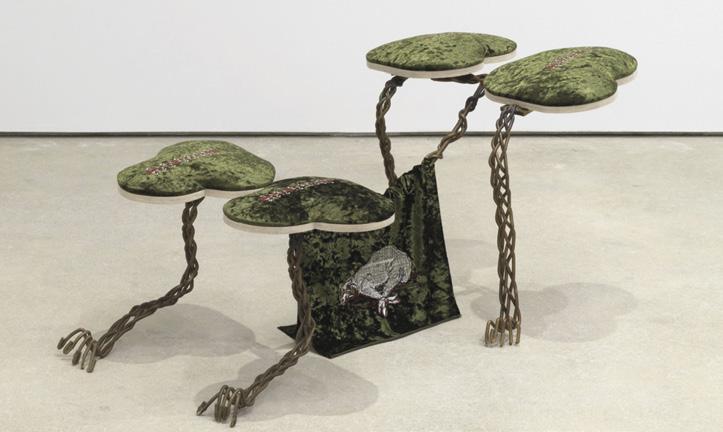
Dog (2021–present), sculptures transcending the boundaries of craft, technology, and fine art. Utilizing her background in textiles and family history in New England, watching the disappearance of the textile industry, the series considers the connection between this decline and the rise of tech companies. Brittni Ann’s Lamb of God (Bowing Robot Dog) a bench-like sculpture crawls on all fours, and incorporates a machine-embroidered lamb on the central fabric drape, borrowing from Francisco de Zurbarán’s Agnus Dei
Harry’s work delves into the history and religious imagery encompassed by his draughtsmanship and craft. Utilizing woodworking to create exquisite frames, he allows the drawings to expand past their borders into three-dimensional objects.
The exhibition includes works from Brittni Ann Harvey’s series Robot
Sharing a similar aesthetic sensibility, the artists offer the viewer quandary and contradiction. They are stewards of their homes and look to the past and present for inspiration and sources of questioning. The works disrupt expectations pulling from unexpected and incongruous sources yet come together to create a complex vision and inquiry of people and their region. — Abbi Kenny
March/April 2024 | Art New England 61 REVIEW: MASSACHUSETTS
Mark Winer, As the World Burns, 1973, digitized super 8 film, 18:00 min. Courtesy of the artist.
Above: Brittni Ann Harvey, Lamb of God (Bowing Robot Dog), 2021, embroidered polyester, plywood, polyfill, bronze, 193/4 × 413/8 × 235/8". Courtesy of the artist and Someday, New York.
Eat & Drink
ClipArt Gallery, East Boston, MA • clippershipwharf.com/art • Through April 6, 2024
Curators Maryellen Cahill and X Bonnie Woods write that, when selecting the art for this exhibition, they were continually drawn to works that were “luminous, luscious, and painterly.” Eat & Drink is filled with the light and energy of their choices.
Marian Dioguardi paints layer and jumbles of neon-colored, transparent plastic cups. Masterfully executed in oil, the depth of color and intensity of texture is like a magnet. The chutzpah that she showed as a child selling her paintings to neighbors for five cents in East Boston is still fully evident in her most recent dynamic work.

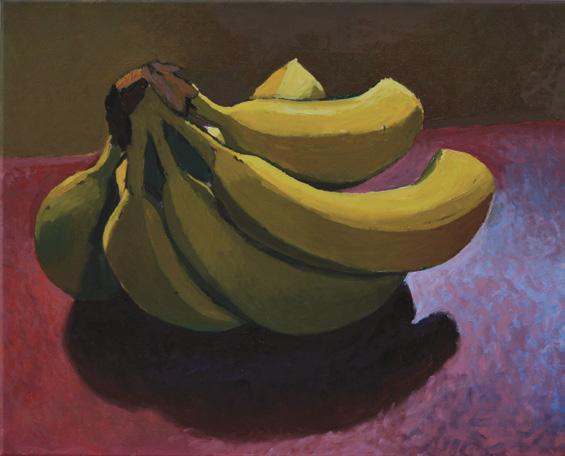
Also painting in oil, Paul Kerepka portrays mushrooms illuminated by the sun’s rays, and follows their trajectory to the cutting board. In Study of Bananas, he poses a bunch of full, ripe yellow bananas on a deeply hued magenta and blue-purple ground, thereby bringing the fruit to a new life. His attention to detail and color bring Vermeer to mind.
Mai Mai Pietrowski hopes that her paintings will inspire joy within the viewer. It is completely impossible not to feel uplifted when seeing her wall
REVIEW: MASSACHUSETTS
of eight joyous pastries painted in bold colors. She plays with the effect of shadows and neutral colors, as well as with patterns and shapes. Pastries 12 looks as if it’s inviting the viewer to pick it up and bite into the rich frosting.
The fourth artist, John Rufo, paints in a style so spare, it suggests a visual poetry. In Blue Espresso 6, he chooses a familiar object that we use every morning, so intimate that we barely realize that it represents home, comfort, and is, in fact, an anchor in the day. Rufo is a student of haiku and tanka (“short song” in Japanese), and his paintings reflect the essence of his subject.
The curators themselves are represented by one work each. Cahill’s Noodles is comprised of an antique fork with delicate threads and beads woven through the tines. Wood’s Peach Half is sumptuous ink on paper. Both artists are members of the Atlantic Works Gallery which maintains ClipArt Gallery, an exquisite location right on the edge of Boston Harbor.
— B. Amore
Gary Lichtenstein Editions at MASS MoCA
MASS MoCA, North Adams, MA • gleditions.com
MASS MoCA is currently home to an expansive, privately managed printing center, Gary Lichtenstein Editions. The gallery is clean and gorgeously lit. The walls display the creative labor of contemporary, up-andcoming, and established artists. Lichtenstein has been creating silkscreens for forty-five years with a diverse group of artists including Jessica Stockholder, Roz Chast, Cey Adams, and Shepard Fairey. The gallery offers printing services as well as assistance in marketing, exhibiting, and promotion.

A few commonalities between the artists Lichtenstein works with are striking color combinations, pop culture references, and a jocular sensibility. Another grouping falls under abstraction, with some pushing close to Op art. All are visually arresting. Lichtenstein bases his artist selection process on cultural happenings, commissions, and artistic serendipity.
Adams, former creative director at Def Jam Recordings and graffiti artist, exemplifies one type of Lichtenstein’s curation. The gallery exhibits a handful of his portraits of RUN DMC in various poses and a few street scene snapshots. Car Wash is a nearly photorealist view of an urban carwash which juxtaposes a graffiti spelling of ‘car wash,’ with its more proper sign. It has an 80s
vibe with its garish colors and funky beat. Another style altogether is the non-representational prints by Duane Slick. Threshold in Blue and Threshold in Red and Black are comprised of horizontal lines of varying width, length, and thickness. Some swaths resemble diaphanous fabric, while others have a viscous appearance, resembling Navajo rugs, or infinite perspectives in space.
Lichtenstein is himself an adept artist. The Butler Institute of American Art, in summer 2023, exhibited a virtual retrospective of decades of output, showcasing Lichtenstein’s print collaborations, and highlighted his paintings, which they characterized as ‘color field’ inspirations. The influence of Southern California was apparent in the amorphous pastel nebulas, which have the efficacy of a Dan Flavin halo. In fact, Lichtenstein mentions how much the Light and Space movement inspired him.
Printmaking requires focus and an innate understanding of color and line. Lichtenstein is generous with his knowledge and encourages public curiosity and educational outreach. Richard Klein of the Aldrich Art Center observed that for Lichtenstein printing and art is an “adventure punctuated by frolicking detours than a series of premeditated tasks.” — Bret Chenkin
62 Art New England | March/April 2024
MASSACHUSETTS
REVIEW:
Above, from left: John Rufo, Blue Expresso 6, oil on panel, 5 x 5"; Paul Kerepka, Study of Bananas, oil on canvas, 16 x 20". Courtesy of the artists.
Above: Gary Lichtenstein and Al Diaz II at the printing center. Courtesy of Gary Lichtenstein Editions.
Whale’s-Eye View—Wu Tsang: Of Whales
ICA, Boston, MA • icaboston.org • Through August 4, 2024
It is particularly American to make monsters out of one’s fears and to project those fears onto the big screen, Hollywood-style. Think Godzilla and Jaws. Which brings us to Moby Dick, the fictional whale of Herman Melville’s classic novel of the same name. While one can read Melville’s man vs. beast narrative as a psychological exploration of how our inner demons can swallow us whole if we are not careful, it is also de rigueur to impart a queer, post-colonial, anti-capitalist, and/or ecological lens on the classics—those we keep returning to for their capacity to help us recast our understanding of ourselves, and to make things right.
Such is the case with American artist Wu Tsang, whose fascination with the novel led to two collaborative, interdisciplinary art projects that explored Moby Dick through this multifaceted lens: her silent art film Moby Dick; or, The Whale, and Of Whales, Tsang’s VR installation that peers through the imagined eyes of the storied whale—first created for the Venice Biennale, and now on view at the ICA in Boston.
Captain Ahab’s adversary, the massive albino sperm whale called Moby Dick, rules the sea, and some say that was Melville’s central message: you can’t conquer nature (nor should you try). She will always win, and we (humans) will end up destroying ourselves in the process. This is a message of our time, no doubt; and Tsang recognizes and celebrates this with her homage to this Poseidon of our collective imagination.
The real-time video, displayed in a continuous loop on a vast, whale-scale screen, includes zero actual footage of the ocean; instead, Tsang has recreated and riffed on it in CGI (set to the hypnotic musical score by Asma Maroff and Daniel Paneda), to stunning effect. Seated in the darkened gallery in one of the many beanbag chairs strewn around the space, one easily settles in for the imaginary dive as the virtual ocean pulls us into its heights and depths. Anyone with a poetic bent will be inspired to ekphrasis as the images spill forth on the screen. These fantastical and at times un-oceanic flourishes call to mind other

bombastically visual creations, from Disney’s Fantasia to various ice cream toppings. And thus, a dialogue ensues—between what the whale sees and what Wu Tsang sees.

And then there’s us. What we see might be cosmic confetti morphing into a cotton candy sky, puffed up into blue and pink spun sugar as seabirds wing past—a clue that our whale has come up for air. Or perhaps we see plankton stars, conjuring constellations of mysterious lights from unfathomable depths as our whale emerges and engulfs the screen. Or maybe we see glow sticks tapping out the rhythms of wind instruments. As the burgeoning metaverse with its dizzying complexity explodes with possibilities, from gaming to live entertainment to industry applications, it’s no wonder artists would seize the opportunity to enter this playground and pick up its tools. The possibilities are endless—as deep as Moby Dick’s ultimately unknowable ocean. Through this newish medium, Tsang does what she has always done—give voice to the unvoiced (her documentary Wildness is a gritty, and edgier, early example of this): in this case, she gives voice to the whale, both as genuine article and as poster
child for nature. Tsang, who is from Worcester, Massachusetts, and now based in New York and Berlin, is a MacArthur genius and among today’s celebrated artists who are making waves with their activist-driven platform. Among Tsang’s predecessors, Judy Chicago and her The Dinner Party showed us that artists can make beautiful things and say profound and important things. Today, Seneca artist Marie Watt is among many Native artists speaking to post-colonial awareness, and Ai Weiwei is known for his powerful installations that confront democracy and human rights abuses in China. In each of these cases, the artists are driven by their own identities and a desire to give a voice to the silenced, to paraphrase Wu Tsang’s narrator in Wildness Whether or not audiences will have any idea of Tsang’s message (the exhibition materials help make those connections), Tsang has tapped into an unmistakable zeitgeist: a growing admission that planet Earth is in grave danger. Let’s hope that Tsang’s vision of what lies beneath does not become the only way for us to remember what was lost. — Julianna Thibodeaux
March/April 2024 | Art New England 63
SPOTLIGHT REVIEW
Above: Wu Tsang, Of Whales, 2022. Installation view, The Milk of Dreams, 59th International Art Exhibition, La Biennale di Venezia, 2022. Courtesy the artist and Galerie Isabella Bortolozzi, Berlin. Photo: Matteo De Fina. © Wu Tsang. Below: Wu Tsang, 2023.
Photo: © Schauspielhaus Zurich/Gina Folly.
Total Eclipse of the Art
The Gallery at WREN, Bethlehem, NH • wrenworks.org • On view March 8 to April 12, 2024
For most of recorded history, humans have feared and been in awe of the solar eclipse. Many cultures regarded it as an omen from the gods or the universe predicting future events and casting judgement on current ones. Now, of course, we know that these astonishing astronomical events are caused when the moon passes between the Earth and the sun, causing the moon to obscure the sun’s light and cast its own shadow down on our planet. Yet, we still find beauty, magic and majesty in this, as can be seen in the Gallery at WREN’s Total Eclipse of the Art.
WREN held an open call for submissions from its artist members on the theme of the solar eclipse, and these artists responded, as expected, with beautiful, innovative artworks. Oil painter Rebecca Fullerton is one of the more than twenty artists featured in the show. Her piece, titled Sogalikas Blocks Out the Sun, imagines the effects of the eclipse over the iconic White Mountains.
“With this being the first time New Hampshire has been in the path of totality in sixty-five years, I gave myself full license to bring the drama of the White Mountains and the eclipse together. I used bold colors and dynamic composition to show off the Presidential Range under the light of this rare celestial event,” said Fullerton. Her varied brushstroke mixes soft, ethereal blending with sharp detail. The scenery is awash in eerie blue and deep green woods, with only the barest hint of gold from the hidden sun scattered across the mountaintops.
“Sogalikas” is the Abenaki name for April’s maple sugaring moon, which sits in a place of honor in this piece, surrounded by the iconic ring of fire from the upcoming solar eclipse.

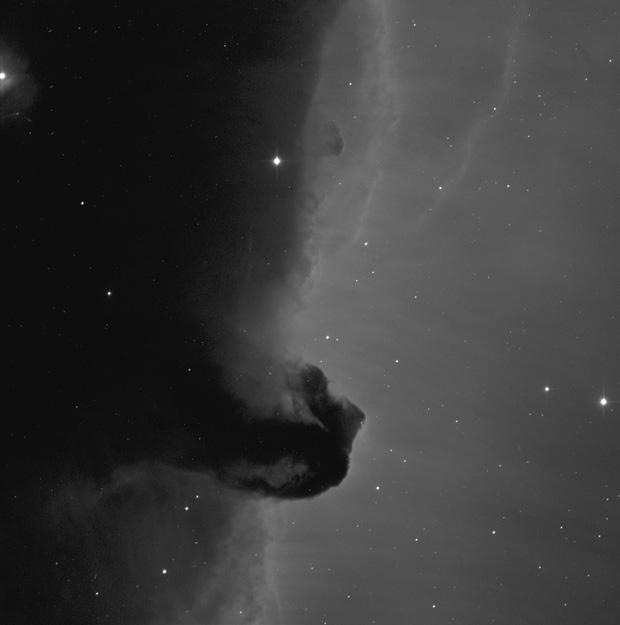
Located in Bethlehem, NH, in the North Country, the Gallery at WREN will be only a few miles away from the path of the total solar eclipse on April 8, 2024. North America will not experience totality again until 2033, when Alaska alone will fall in the eclipse’s path. In 2044, totality will reach Western Canada, Montana and North Dakota. In other words, seeing the total
solar eclipse here, in New England, is very nearly a once-in-a-lifetime event. And WREN was not going to let it pass without commemoration. “For a gallery located almost directly in the line of totality of a significant solar eclipse, we felt it was important to take advantage of this moment in art,” said Douglas Weisman, WREN Gallery Committee member and curator of the exhibition. Part of the show circles around the powerful astronomical photography of Douglas Arion, PhD, professor emeritus of physics and astronomy and Donald D. Hedbery Distinguished Professor Emeritus of Entrepreneurial Studies at Carthage College. He founded Galileoscope, an international project to provide high-quality, low-cost telescopes for use in science education around the world. Arion was a driving force in the creation of the AMC Maine Woods International Dark Sky Park, which protects more than 75,000 acres of land in the last dark sky region in the Eastern United States. Arion’s photography depicts the cosmos that surrounds us in crisp, clear black and white, bringing those far-off vistas a little closer to home. His work in the show is printed on archival Hahnemühle Metallic Photo Rag® by master printer Eric Lunder at Digital Silver Imaging in
Belmont, MA, and subsequently mounted on substrate and block mounts to create the illusion of “floating” off gallery walls.
WREN, the Women’s Entrepreneurial Network, was founded in 1994 with the goal of providing support to women working and living in the North Country through access to education, economic and professional development and a supportive community. The Gallery and Store were opened in 2001 to support this vision and provide space for WREN members to show their art and for community members to show their appreciation. The Gallery holds opening receptions for every exhibition as part of this dedication to community and connection, and Total Eclipse of the Art is no exception. “The whole community’s invited. We have nice hors d’oeuvres, we serve wine, it’s a place people can come together and chat,” said Pam Sullivan, WREN’s executive director and arts administrator.
Artists featured in the exhibition in addition to Fullerton, Weisman and Arion include Bernadette Waystack, Stephen Dignazio, Lorna Colquhoun, Kim Stockwell, Kathy Shuster, Sylvia Dodge, Nathan Cohen, Michele Johnsen, Barbara Morse and Li Parsons. The show opens with a reception on March 8, (snow date March 9), and closes on April 12, four days after the eclipse.
— Autumn Duke
64 Art New England | March/April 2024
SPOTLIGHT REVIEW
Above: Above: Rebecca Fullerton, Sogalikas Blocks Out the Sun, 2024, oil on panel, 12 x 24". Courtesy of the artist. Below: Douglas Arion, The Horsehead in Orion, printed on archival Hahnemühle Metallic Photo Rag®, 30 x 30". Courtesy of the artist.
Reshaping Abstraction
Concord Art, Concord, MA • concordart.org • Through May 12, 2024
Reshaping Abstraction is a fun-filled, intensely serious exhibit. Curator Adria Arch has chosen wonderfully skilled artists who are making work in which meaning transcends the immediate first impression.
Cadence Geirsbach is inspired by nature and her work as a gardener. She Wolf incorporates an ancient column capital as an archetype with paint dripping and flowing in organic fashion over the roughly modeled forms. Bonny Liebowitz redefines “nature” in her work. She intentionally blurs the boundaries between the manufactured and natural to elucidate her premise that nature is no longer separate from human culture and technology. Her Small Shifts and Massive Alteration, at over seven feet tall, is a major focal point of the exhibit.

In contrast to this wider view of nature, Gregg Blaisdel offers us Life and Death Rattle 18. He writes that “after a recent medical event, I made a rattle in my studio from scraps of leftover wood.” This return to a psychically safe space of childhood presaged his meeting with healers who spoke of vibrations and rhythms being essential com-
REVIEW: NEW HAMPSHIRE
Justin O’Rourke: A Matter of Time
ponents of healing. His fantastical rattles entice the hand, eye and ear.
Both Olivia Baldwin and Vanessa Irzyk have created works that are highly sculptural. Baldwin’s Secret Passage is a three-dimensional built form made of canvas, wire and thread that has a free form haptic approach – similar to clothing strewn on a bed. It is carefully painted in modulated colors that enhance the shapes.
Irzyk’s Double Hump creates the illusion of a sculpture in space. She starts with a dynamic shape on heavy watercolor paper which she then develops with gradated shadow, intricate patterns and washes of color. Both playful and multi-layered, the form looks as if it is about to pop off the surface.
Arch, a sculptor herself, has curated the works of contemporary artists who have made a conscious choice to create buoyant, joyful work in the face of the barrage of negativity that we confront daily. Arch has succeeded in finding artists who support her premise. The result is an unusually energetic, skillful, and completely enjoyable adventure. — B. Amore
AVA Gallery and Art Center, Lebanon, NH • avagallery.org • Through March 30, 2024
“I’ve always been curious about how things work,” said artist Justin O’Rourke in a recent interview on the occasion of his current show at AVA Gallery and Art Center in Lebanon, New Hampshire. O’Rourke grew up in West Rutland, Vermont, a community built around marble quarries and the timber industry. From a young age, O’Rourke attended The Carving Studio and Sculpture in his hometown where he was exposed to makers across many disciplines. Sculptors, metalsmiths, and other craftspeople took O’Rourke under their wing and his innate sense of curiosity flourished.
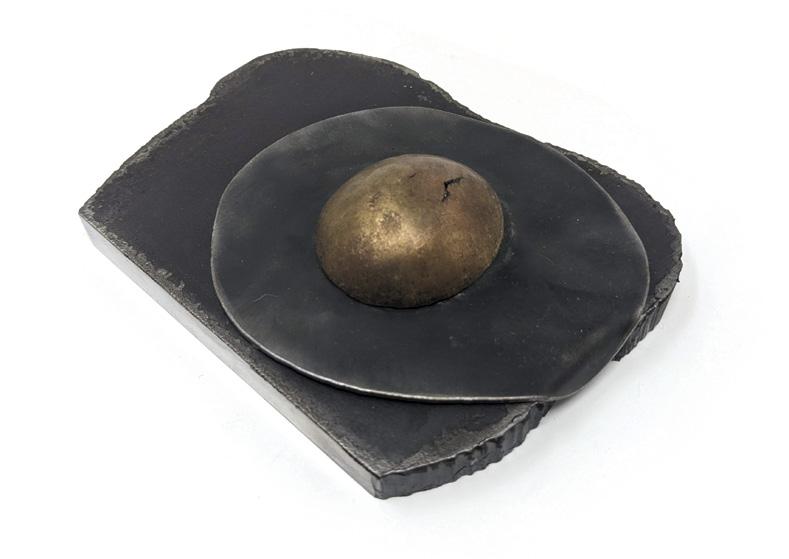
O’Rourke studied engineering at Dartmouth College and continued to develop his artistic practice there. “I found a home in the sculpture department,” he said. His interest in sculpture was fortified while studying under sculptor Brenda Garand. Upon graduation, O’Rourke rented a studio and learned welding, which led to a career in hydroelectrics. Time, labor, art and industry are among the major themes that run through O’Rourke’s recent work.
The aptly-titled exhibition A Matter of Time features a selection of metal sculptures and works on paper from 2022 to the present. Leek of
Steel (2022) is a prime example of O’Rourke’s facility with metal work. The detailed folds and layers of the leek form appear delicate, despite their forged steel construction. Throughout the show, O’Rourke tows the line between elegant minimalism and Pop art sensibility with a wry sense of humor infusing the work. The range of surfaces and textures O’Rourke achieves with steel evinces his years of technical experience. A trio of cushion sculptures look soft and supple with details like buttons and stitched seams adding to their realism.
Most of the sculptures on view are figurative or recognizable as objects that exist in the world. The luminous black patina of the sculptures adds an almost supernatural quality to them. Some of the works feature copper or brass elements which creates little glimmering surprises as one moves through the show. Egg Toast (2023) consists of two flattened steel sheets with a bronze dome that forms the egg “yolk.” The bounty of food forms reminds one of the communal aspect of eating together—how food is so intrinsically linked to memory, and by extension, to time.
— Eric Sutphin
March/April 2024 | Art New England 65 REVIEW: MASSACHUSETTS
Bonnie Liebowitz, Small Shifts and Massive Alteration, wax and pigment on Tyvek, 86 x 73". Courtesy of the artist.
Above: Justin O’Rourke, Egg Toast, 2023, steel and bronze, 4 x 6". Courtesy of the artist.
Dreams of a Common Language
Overlap is a dynamic new gallery located just outside downtown Newport in a refurbished glass shop. Co-directed by artists Susan Matthews and Alicia Renadette, Overlap is committed to showcasing work that highlights rigor in craft, creating a space for underrepresented art that features textiles, installations, and other material investigations often spilling off the wall. Their upcoming exhibition Dreams of a Common Language promises a unique interpretation of fiber arts which will continue to push the gallery into the forefront of Rhode Island’s art scene.
The exhibition features three Rhode Island-based artists and educators. Lu Heintz, Elizabeth Duffy, and Anna McNeary are united in their explorations of gender, craft, and identity through textiles, installation, and performance. Dreams of a Common Language takes its name from an Adrienne Rich collection of poetry from which the three artists have taken to sending excerpts to each other as a grounding, meditative practice.

Meticulous in craft, Duffy studies the cyclical nature of clothing through her current project Wearing. This series involves her carefully unwinding braided scrap rugs, ironing and patchworking tattered scraps, and metamor-

Left: Lu Heintz, Habitus, 2021-ongoing, wood, plaster, steel, fabric, plastic, paper pulp, and found objects, dimensions variable. Photo: Lu Heintz.
phosing them into garments and wall hangings. The works often remain tethered to the placental mass of the original rug, disrupting their use as either clothing or rug.
Tethering and transformation are reflected in McNeary’s performative works. She explores the vulnerability of social intimacy through modular clothing that links together participants. Additionally, McNeary utilizes screen printed textiles featuring repeated words such as “certainty,” “now,” and “never” to create quilt style wall hangings where words become abstracted. Like the connective clothing, the words undulate in and out of recognition and blur their function as statement or pattern.
Heintz continues the themes of transfiguration in her installation Habitus, a whimsical display of furniture and household objects. Closer inspection will reveal an organ-like plushie slouching in the chair, a red stocking dangling seductively off of a coat stand turned foot, and other bodily mirages that hint these objects may be anthropomorphizing. The works of Duffy, McNeary, and Heintz are playful, transformative, and reject the language of object, artwork, and entity. —
Eleanor Q. C. Olson




66 Art New England | March/April 2024
Overlap Gallery and Project Space, Newport, RI • overlapnewport.com • Through June 15, 2024
REVIEW: RHODE ISLAND
OFFERING Artist and Writer Coaching (Individual & Group) Arts Consulting Custom Publishing Web Design Digital Production Portfolio Reviews Workshops MAKE YOUR MARK—WE’LL DO THE REST Contact Rita Fucillo for more information rita@artnewengland.com; 857-366-8131 Creative Services New England CONTEMPORARY ART AND CULTURE
In the Garden: A Platform for Artists, Poets and Performers
The Current, Stowe, VT • thecurrentnow.org • Through April 11, 2024
In the Garden brings together seven artists whose work uses gardens as a metaphor: for redlining and other racist practices, feminist embodiment, migration and more. Interesting gestures all, yet what may be more intriguing is the position in which many of the works cast the viewer. Self-awareness, not unmitigated viewing pleasure, is the order of the day.
The gallery welcomes viewers with Mexican multimedia artist Carlos Amorales’ Black Cloud, an installation of black paper butterflies individually glued to the walls and ceiling in an elegant, dense swarm. Viewers might be simultaneously amazed and repulsed, mentally
measuring the distance between themselves and this strikingly realistic infestation whose color can signify death.
Installations of Amorales’ 2007 work, some with up to 45,000 butterflies, have appeared everywhere from a spacious baroque church interior in Spain to a hallway in the Power Plant Contemporary Art Gallery in Toronto. Rachel Moore, the Current’s executive director and director of exhibitions, installed this version.
A single 40-by-60-inch painting by Vermont artist Wylie Garcia, whose subject has long been floral imagery, makes the viewer a participant. Garcia’s Through a Space in the Garden Bough,
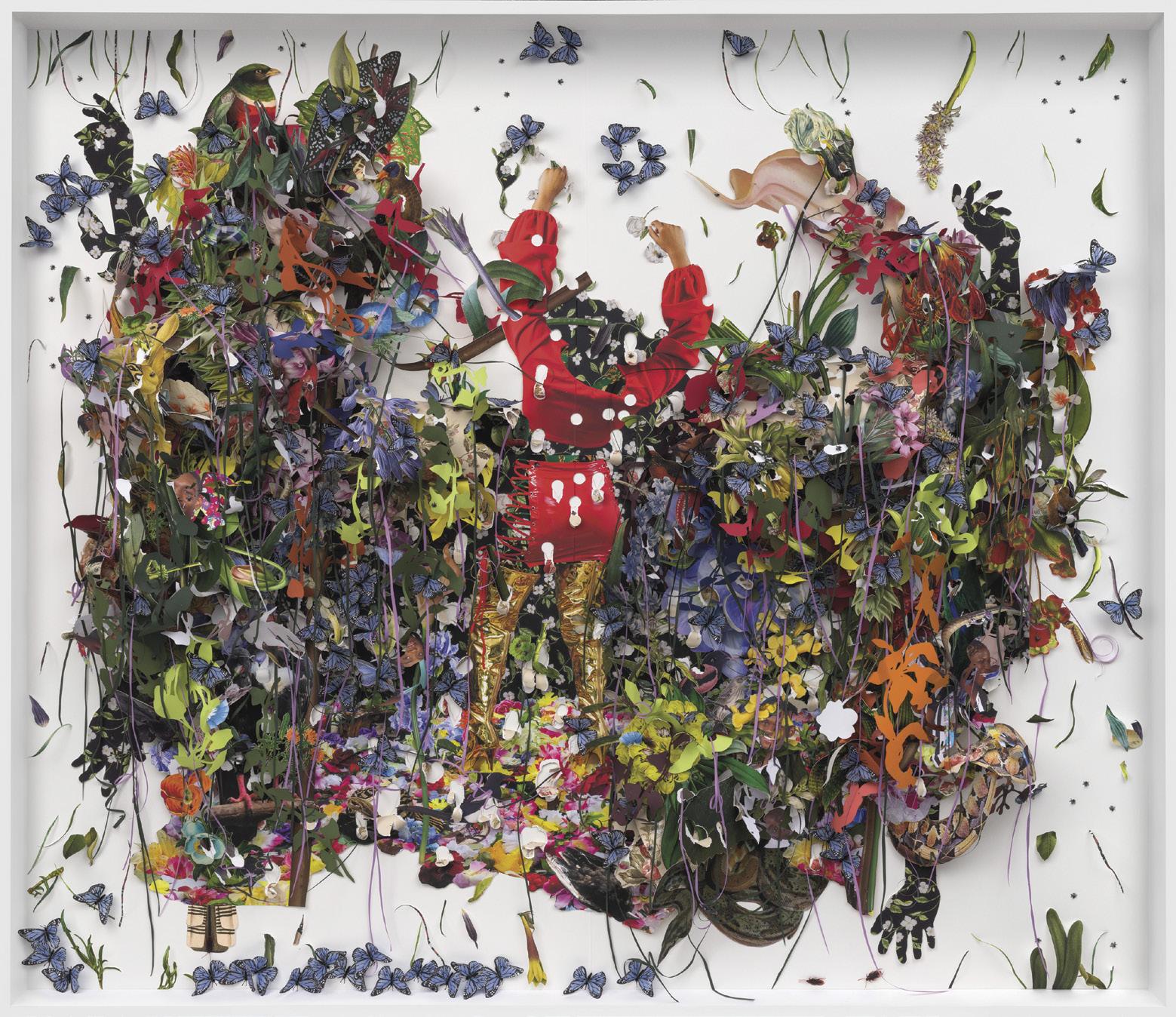

I See Light Over the Horizon takes inspiration from a late-19th century painting by Thomas Moran depicting an offshore ship and distant horizon but no humans. Instead, the viewers become The Lotus Eaters of Moran’s title by virtue of their position near the foregrounded shore. Similarly, Garcia’s painting positions the viewer as the “I” of her title, who peeks through an opening in the flowers that crowd the canvas.
Nine of the show’s nineteen works are by upstate New York-based Valerie Hammond, whose array of materials include watercolor, pigment, encaustic, glass beads and thread on everything from handmade Indigo paper to silk. Traces (Nightshade), a 74-by-35-inch work in pigment, colored pencil and encaustic on deep blue Japanese paper, depicts two ghostly-white, raised hands whose forearms morph into hanging vines, photographed flowers and translucent white leaves.
Hammond’s art asks viewers to enter a liminal space between the spiritual and real worlds—“the material and immaterial,” as her statement puts it—where female physicality dissolves into natural phenomena yet gains beauty and strength.
The show’s centerpiece is …there is a rumble as the garden folds, rolls, shreds, devours…itself, a 66-by-109-by-15-inch white box containing a 3D paper garden, by Ebony G. Patterson. The Jamaica-born artist hand cut or tore each digital-print element of this intricate, colorful jungle of a garden, building layers of blooms, vines, coiled snakes, plastic insects and half-visible brown faces. At the center, partly screened by the overgrowth, is a headless female figure seen from behind, arms raised and dressed in a red
March/April 2024 | Art New England 67
SPOTLIGHT REVIEW
Above: Ebony G Patterson, ...there is a rumble as the garden folds, rolls, shreds, devours...itself, 2021–2022, digital print on archival watercolor paper with hand-cut torn elements, construction paper, plastic, feathers mounted on wallpaper, 96 x 109 x 15" (in frame). Courtesy of Ebony G. Patterson, Monique Meloche Gallery and Hales Gallery. Collection of Rishabh and Lopa Mehrotra. Below: Valerie Hammond, Constellation 2, 2019, ink, paint, powder pigment on handmade Indigo paper, 211/2 x 151/2". Courtesy of the artist and Matt Neckers.
outfit and thigh-high gold boots. The garden as memorial here cuts both ways: as tribute and symbol of death.
Patterson, intimately attuned to the act of seeing, explores how colonial legacies render individuals invisible. Her work “uses beauty to trap the viewer,” according to Monique Meloche Gallery in Chicago, which represents her.
Three works from Paul Anthony Smith’s Dreams Deferred series, the larger two 60 by 40 inches, equally weight the viewer’s position. Smith uses oil applied to inkjet prints on Dibond to depict gardens as seen through chain link fences. Some fences are doubled, with a spray-painted diagonal grid overlaying a photographed one. Viewers are by definition excluded from the enticing gardens they glimpse through foregrounded chain links.
In an interview for his 2023 solo show at the Blaffer Art Museum, Smith said that Dreams Deferred is about how zip codes and redlining affect opportunities for Black Americans. Some of his gardens begin as a photograph of a stark urban lot in New York, where the Jamaican-born artist lives. “It’s about camouflaging information within a subject matter,” he explained.
Gardens are, in the end, human-managed nature. Two final artists in the exhibition pursue the ecological implications of that relationship.
REVIEW: VERMONT

Retired University of Vermont professor Cameron Davis taught painting and drawing while also serving as an affiliate in the environmental sciences department. Her sole painting in the
show, Encounter II (48 by 36 inches), comes from her Poetic Ecologies series. These acrylic compositions layer plant motifs so subtly that puzzling out their depths leads to a kind of immersive viewing. Nature, in the series, is a subjective experience for humans.
New York City artist-activist Mary Mattingly is best known for art projects that directly tackle flooding, food insecurity and other social-environmental issues, including Swale (2016–19)—a floating barge planted with foraging fields available to the public. The project inspired the city’s parks department to open its first officially sanctioned foraging site, the Bronx River Foodway.
Mattingly has four 12.75-inch-square giclee prints in the exhibition. The photographs, whose subject is riparian areas, depict “underwater” fields of blooming flowers that the artist built in fish tanks against starry nighttime skies created through digital collage. Viewers, the series implies, need not despair over ecological disasters if they can imagine a way forward.
Indeed, as Moore points out in her introduction, “one is free to create anything imaginable” in a garden; even the word “paradise” comes from a Persian phrase for “walled garden.” In the Garden asks where you, the viewer, are in its many versions of paradise. — Amy Lilly
When the Light Breaks into Pieces, Carolina Ellenbogen
Ellenbogen Gallery, Manchester Center, VT • ellenbogengallery.art • Ongoing
The Ellenbogen Gallery resides within a stately, deep blue building with a fire red door; contemporary art displayed under bright lights in large street-level windows. Artists Carolina and Michael Ellenbogen own and curate the gallery and enjoy a working studio on the premises.
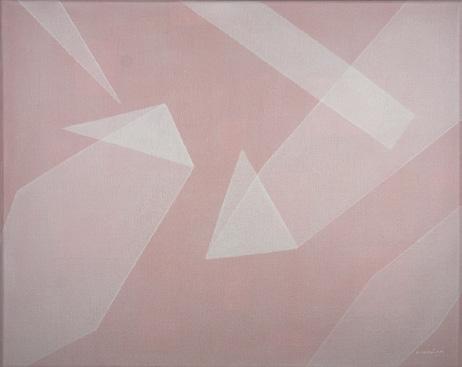
Carolina’s current show When the Light Breaks into Pieces, comprises a dozen or so canvases, painted in acrylic. Consisting of fragmenting slices of pearl upon a dark blue ground, these are ghostly silhouettes at times coalescing as geometric forms. Carolina has a penchant for light and its relationship with reality. Another group of paintings depict amorphous shapes that echo platonic ideas, for they’re titled as ‘similes’ (Like Ostriches and Like Screens). Compositionally, they resemble James Turrell’s glass holographic constructions. Carolina is looking at how light is actually a patterned reality, breaking up, forever vibrating, and leaving us with a false sense of solidity. The use of acrylic presents a plasticity, or artificial aura, which reinforces the luminosity she is seeking. Works such as Constellation and Void demonstrate Carolina’s background in architecture, with how they vacillate between waves of dashes and a hint

at a structure. This is modern divisionism, with a historical connection to Paul Signac and a contemporary parallel with Barbara Takenaga and even photographer, Christopher Bucklow’s Guest series. Michael’s works are blurry compositions of everyday objects or scenes, often in a tilted or awkward perspective. He acknowledges the influence of color field painters. This is obvious in the hazy abstract showings such as Pink Slip and Purple/Empire. In the first, a line of amorphous pastel rectangles float upon the lower half, suggesting a Frankenthaler soak. The second has a neo-noir low angle shot of the Empire State Building lit at night. Michael straddles the line between ambiguity and a recognizable monument. One cannot help but think of Bill Jacobson’s fuzzy urban views or classic ECM album covers.
The space comprises a menagerie of artists: Jen Violette’s glass bulb worlds with their nostalgic barns have a surreal effect. Richard Weis’s compact paintings follow De Kooning’s example with the swaying strokes and wild contortions. Wood, metal and bronze offer material variety, from wall hangings by Gregory Smith, loops of wood by Fermin Castro, and classical figures of Fred Brownstein. — Bret Chenkin
68 Art New England | March/April 2024
Above, from left: Carolina Ellenbogen, Like Ostriches, 2013, oil on canvas. Carolina Ellenbogen, Like Screens, 2013, oil on canvas. Courtesy of the artist.
Above, from left: Cameron Davis, Encounter II from the Poetic Ecologies series, 2022, acrylic on canvas, 48 x 36". Courtesy of the artist.
Exhibitions
New England’s Premier Resource for Galleries, Openings and Events Around the Region
Connecticut
Art Museum, University of Saint Joseph 1678 Asylum Ave., West Hartford, CT (860) 231-5399
usj.edu/artmuseum
W–Sa 11–4
Opening March 23: (R)evolution: Identity and Power in Puerto Rican and Diasporican Art This exhibition, inspired by a painting by Miguel Luciano created in response to the 1998 centennial of the U.S. annexation of Puerto Rico, brings the painting together with works by other artists to explore the historical and contemporary complexities of colonialism and resistance. Opening reception: Friday, March 22, 5–7:30 p.m. Saturday, April 13: Family Bomba/Plena Workshop, 1–4 p.m.; and Noche Boricua, 7:30 p.m., celebrate Puerto Rican music and dance, featuring William Cepeda.


Fairfield University Art Museum
Fairfield University
200 Barlow Rd., Fairfield, CT (203) 254-4046
fairfield.edu/museum
Tu–Sa 11–4, Th 11–8
Through April 27, Walsh Gallery (Quick Center): Streaming: Sculpture by Christy Rupp. A robust survey of eco-artist and activist Rupp’s wall installations and free-standing sculptures of animals, created from detritus from the waste stream. Through March 16, Bellarmine Hall Galleries: Helen Glazer: Walking in Antarctica. Photographs, sculpture and audio narrative by Glazer transport the viewer on a journey to an extraordinary, remote environment. Opening April 5: Suzanne Chamlin: Studies in Color. Landscape and still life paintings with harmoniously focused color palettes.
phers presents the work of pioneering women photographers employed by LIFE magazine between the late 1930s and early 1970s, whose iconic images captured an evolving world and helped create modern photojournalism. Featuring over 70 images by Margaret Bourke-White, Nina Leen, Lisa Larsen, Hansel Mieth, Martha Holmes, and Marie Hansen, the exhibition details how these photographers and their work were integral to LIFE founder and editor-in-chief Henry R. Luce’s vision for an “American Century.” Organized by the New-York Historical Society.

Hartford Art School Galleries
Hartford Art School, University of Hartford 200 Bloomfield Ave., West Hartford, CT (860) 768-5522
hartford.edu/galleries
ECOCA
51 Trumbull St., New Haven, CT (203) 507-7320
info@elycenter.org
elycenter.org
April 14–June 2: W, Th, Su 12–5
This spring ECOCA’s gallery will be filled with works that touch upon the many aspects of the environment and climate change. The Spring Heat exhibitions include solo shows by Sariah Park, Hanlyn Davies, and group exhibitions from Yvonne Short & Rebecca West, Thinking about Water, Water Women, Nua Collective and more. Opening reception: Sunday, April 14, 1–3 p.m.

Greenwich Historical Society
47 Strickland Rd., Cos Cob, CT (203) 869-6899
greenwichhistory.org
W–Su 12–4
Opening March 6: LIFE: Six Women Photogra-
M–Th 12–6, F-Sa 1–5
Through March 23: Twice the Legal Minute, a solo exhibition by Jonathan Herrera Soto in Joseloff Gallery, explores the stakes of mistranslation, plausibility, and solitude in printmaking. Artist talk: Wednesday, March 20, 5–6:30 p.m.
April 4–16: The first round of BFA Thesis Exhibitions features Illustration in Joseloff Gallery and Photography and Printmaking in Silpe Gallery. Opening reception: Saturday, April 6, 6–8 p.m. April 25–May 7: BFA Thesis Exhibitions continue with Visual Communications Design in Joseloff Gallery and Ceramics, Painting, and Integrated Media Arts in Silpe Gallery. Opening reception: Saturday, April 21, 6–8 p.m.
March/April 2024 | Art New England 69
Miguel Luciano (b. 1972), Cómo se dice Boricua en Inglés, 1998, acrylic on wood, 48 x 84". Lent by Anthony De Jesús and Madeline Pérez De Jesús. © 1998, Miguel Luciano. Art Museum, University of Saint Joseph.
Hanlyn Davies, Celebrity (mock orange), 2021–23, digital print. Courtesy of the artist. At ECOCA.
Christy Rupp, Aquatic Larvae, 2019–2020, welded steel and collected single use plastics. At Fairfield University.
Margaret Bourke-White, photograph from “Franklin Roosevelt’s Wild West,” LIFE, November 23, 1936. © LIFE Picture Collection, Dotdash Meredith Corp. At Greenwich Historical Society.
Exhibitions
Openings and Events Around the Region
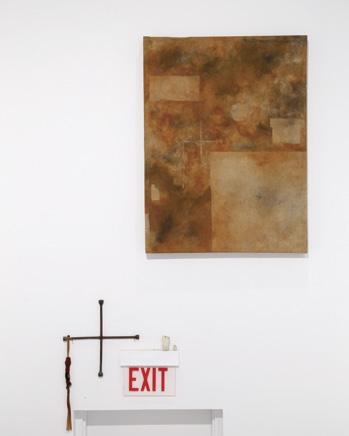
Jonathan Herrera Soto, Through (installation view), 2023, shellac, used motor oil, ash, charcoal, saw dust, and clay powder on stretched drop cloth over wooden 2x4s, courtesy of the artist. Photo: Pat
The Mercy Gallery at The Loomis Chaffee School
4 Batchelder Rd., Windsor, CT christian_ryan@loomis.org loomischaffee.org/arts/mercy-gallery
M–F 10–5, Su 1–5 (September–June)
From September through June, The Mercy Gallery invites groundbreaking artists working in a variety of media, representing diverse endeavors and cultural + geographic perspectives to share their art with the community and public. Opening April 4: Traci Talasco: TIPPING POINT. Presenting a series of conceptual sculptures that use architecture as a social/political space dealing with power imbalances stemming from gender, race, and identity.
New Britain Museum of American Art 56 Lexington St., New Britain, CT (860) 229-0257
nbmaa@nbmaa.org
nbmaa.org
Ongoing: The Land Carries Our Ancestors: Contemporary Art by Native Americans. Curated by artist Jaune Quick-to-See Smith (Citizen of the Confederated Salish and Kootenai Nation), the exhibition highlights artworks by nearly 50 living Native artists that powerfully visualize Indigenous culture and knowledge of the land. Brought together by Smith, this multigenerational, diverse group of artists works across the U.S. and spans a range of practices, including weaving, beadwork, sculpture, painting, drawing, photography, performance, and video.

Steven Yazzie (Diné/Pueblo of Laguna, New Mexico/ European descent), Orchestrating a Blooming Desert, 2003, oil on canvas, Collection of Christy Vezolles. © 2003 Steven J. Yazzie. All rights reserved. Courtesy of the Heard Museum, photo by Craig Smith. At New Britain Museum of American Art.
Spectrum Art Gallery and Artisans Store
61 Main St., Centerbrook, CT (860) 767-0742
events@spectrumartgallery.org
spectrumartgallery.org
W–Sa 12–6, Su 12–5
Voted Best Gallery for Art and Gifts on the Shoreline, Spectrum offers painting, mixed media, sculpture, photography, and a Store with artisan crafts. March 22–May 11: Reaching for the Sky, established and emerging artists present original artwork that explores the wonder and vastness of “the sky.” Work reflects the beauty, legends, and beliefs of this timeless theme. Artisan Store offers pottery, glass, fiber, home décor, jewelry and accessories. Shop online: SpectrumAnytime. com. Shipping throughout U.S.
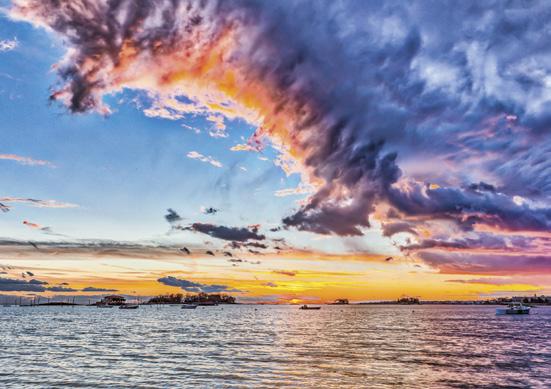
Robert Thomas, Angry Nimbus, 2023, limited edition fine art photograph. At Spectrum Art Gallery.
Tremaine Gallery at The Hotchkiss School
11 Interlaken Rd., Lakeville, CT (860) 435-3663
hotchkiss.org/arts
Tu–Sa 10–4, Su 12–4, when school is in session Opening April 2: Dialogue: Art in Conversation explores the work and processes of Valerie Hammond and Nathaniel (Tate) Klacsmann. Their work reverberates around questions of social inequity, magic, myth, and the environment, creating a group of pieces filled with reflective echoes, offering opportunity for intersection and dialogue.
Yale University Art Gallery
1111 Chapel St., New Haven, CT (203) 432-0600
artgallery.yale.edu
Tu–F 10–5, Sa & Su 11–5
The Gallery’s encyclopedic holdings range from ancient times to the present day and represent cultures from around the globe. Ongoing: Munch and Kirchner: Anxiety and Expression and Sheila Levrant de Bretteville: Community, Activism, and Design. Opening March 15: Year of the Dragon. Free and open to the public.

Maine
Bates College Museum of Art
75 Russell St., Lewiston, ME (207) 786-6158
bates.edu/museum
M, W 10–7:30, Tu, Th–Sa 10–5, and by appointment. Closed holidays and between exhibitions. Through March 4: Exploding Native Inevitable, an exhibition of contemporary Indigenous art from a land we now call America. Through March 4: Brad Kahlhamer: Nomadic Studio, Maine Camp, an exhibition of many sketchbooks, accompanied by a selection of related paintings and prints. Opening April 8: Senior Thesis Exhibition 2024, work selected from thesis projects of graduating seniors majoring in Studio Art. Opening April 8: Neue Slowenische Kunst | Monumental Spectacular, an exhibition of prints and multi-media by this Slovenian art collective.
Colby College Museum of Art
5600 Mayflower Hill, Waterville, ME (207) 859-5629
museum.colby.edu
Tu–Sa 10–5, Th 10–9, Su 12–5
Located on the campus of Colby College in Waterville, Maine, the Colby College Museum of Art inspires connections between art and people through distinctive exhibitions, programs, publications, and an outstanding collection that emphasizes American and contemporary art. Ongoing: The World Outside: Louise Nevelson at Midcentury. Through May 12: A Lot More Inside: Esopus Magazine. Ongoing: Painted: Our
70 Art New England | March/April 2024
Garcia Jr. At Joseloff Gallery.
Sheila Levrant de Bretteville, Women in Design: The Next Decade, 1975, Diazo lithograph on paper. Courtesy Sheila Levrant de Bretteville. At Yale University Art Gallery.
Bodies, Hearts, and Village. Through March 29: Alex Katz:
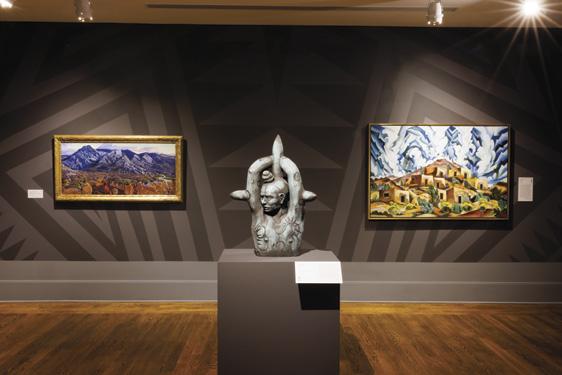
The Colby Museum’s Joan Dignam Schmaltz Gallery of Art
@ the Paul J. Schupf Art Center
93 Main St., Waterville, ME (207) 859-5629
museum.colby.edu
W–M 11–7
The Colby College Museum of Art’s Joan Dignam Schmaltz Gallery of Art at the Paul J. Schupf Art Center offers a place in downtown Waterville, Maine, for connections between art and people through distinctive exhibitions and programs. The art center is also home to Waterville Creates and the diverse film, visual, and performing arts programming presented through its Maine Film Center, Ticonic Gallery + Studios, and the Waterville Opera House. Through April 22: Playscape: Contemporary Art from the Colby Museum’s Collection
Moss Galleries
100 Fore St., Portland, ME (207) 804-0459
251 US-1, Falmouth, ME (207) 781-2620
liz@elizabethmossgalleries.com
elizabethmossgalleries.com
Portland: Tu–Sa 10–5
Falmouth: Tu–Sa 10–5
Through April 6, Portland Gallery: Alice Jones. Through March 16, Falmouth Gallery: Robert Wieferich: Deep in the Woods. Through March 16: Sarah Meyers Brent: Wild Things. Opening March 22: Brita Holmquist and Lynn Sisler.

Massachusetts
Boston and Surrounding Areas
Alpha Gallery
450 Harrison Avenue, #55, Boston, MA (617) 536-4465
alphagallery.com
W–F 12–6, Sa 12–5 and by appointment
March 1–30: ransome, a delicate balance. ransome’s newest body of work explores themes of Black migration and identity through portraiture, cityscapes, still lifes and assemblages. This is ransome’s second solo exhibition with Alpha Gallery. Opening reception: Friday, March 1, 6–8 p.m.

Atlantic Works Gallery
80 Border St., East Boston, MA (857) 302-8363
contact@atlanticworks.org atlanticworks.org
F & Sa 2–6 or by appointment March 2–30: Contemporary Dialogues, Richard Dorff, John Greiner-Ferris and Joan Ryan. Opening reception: Saturday, March 2, 2–6 p.m. Third Thursday: March 21, 6–9 p.m. Performance: Stations of the XX: Saturday, March 23, 3 p.m. April 5–27: In the Woods, Nature-Inspired Paintings and Drawings by Joan Ryan and Julie C Baer. Opening reception: Saturday, April 6, 4–7 p.m. Third Thursday: April 18, 6–9 p.m.

Boston Sculptors Gallery
486 Harrison Ave., Boston, MA (617) 482-7781
bostonsculptors@gmail.com
bostonsculptors.com
W–Su 11–5
Through March 31: Ed Andrews, Random Order and Leslie Wilcox, OUTWITS. First Friday: March 1. Artists’ reception: Saturday, March 16,
2–5 p.m. with artist talks at 3 p.m. Opening April
4: Jessica Straus, Packing for Mars and Marilu Swett, Off Center. First Fridays: April 5 and May 3, 5–8:30 p.m. Artist’s reception: Saturday, April 13, 2:30–5 p.m. with artist talks at 2:30 p.m.

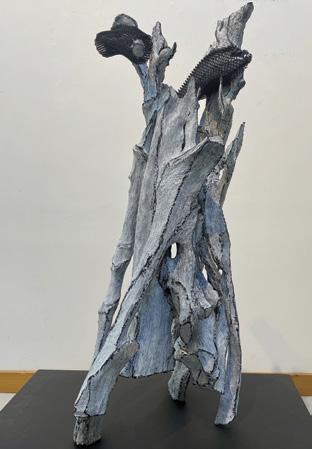

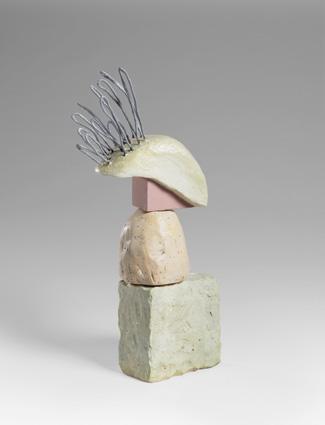
Brickbottom Gallery
1 Fitchburg St., Somerville, MA (651) 245-9710
gallery@brickbottom.org brickbottom.org
Th–Sa 12–5
Through March 24: CITIES HERE AND THERE: Today’s cities exist in a constant state of change… highlights work by five artists: Fred Kasha Simon, Mark Faverman, Dan Coughlin, Adam
March/April 2024 | Art New England 71
Repetitions.
Installation view, Painted: Our Bodies, Hearts, and Village. Photo: Stephen Davis Phillips. At Colby College Museum of Art.
Robert Wieferich, Hiking Baxter, oil on canvas, 40 x 30". Courtesy of the artist. At Moss Galleries.
Elijah, 2023, acrylic and collage on wood panel, 30 x 30". At Alpha Gallery.
Joan Ryan, Picnic By The Wall, 2023, oil on paper. At Atlantic Works Gallery.
Ed Andrews, Not Knotted Now, 2024, acrylic paint on perforated aluminum, 24" diameter X 1.5". At Boston Sculptors Gallery.
Leslie Wilcox, WIT’heads, 2022, driftwood, steel screen, oil pastel, 36 x 18 x 18" (detail). At Boston Sculptors Gallery.
Jessica Straus, Missing You, 2023, wood, paint, inkjet on paper, found object, 18 x 16 x 15". At Boston Sculptors Gallery.
Marilu Swett, Snafu, 2023, mixed media, 24 x 7 x 11". Photo: Julia Featheringill. At Boston Sculptors Gallery.
Exhibitions
Openings and Events Around the Region
Leveille and Liliana Marquez. Curated by Alexandra Rozenman. Reception: Saturday, March 2, 3–5 p.m. April 4–28: THE FIRE WITHIN: COLOR AND EXPRESSION in the paintings of Jo Ann Rothschild, Jeannie Motherwell, Philip Gerstein and Gordon Fearey. Curated by Philip Gerstein. Reception: Saturday, April 6, 3–5 p.m.
Concord Art
37 Lexington Rd., Concord, MA (978) 369-2578
info@concordart.org
concordart.org
Tu–Sa 10–4:30, Su 12–4
Through March 22: Members Juried 2: Collage, Crafts, Drawing, Graphics, Mixed Media, Photography, Printmaking 2024 (Main Gallery) and Chasing Color: Christiane Corcelle and Carole Rabe (Members Gallery). Opening March 28: Reshaping Abstraction (Main Gallery) and Juni Van Dyke and Caryl Hull Leavitt (Members Gallery). Reception: March 28, 5:30 p.m.

Danforth Art Museum at Framingham State University
14 Vernon St., Framingham, MA (508) 215-5110
danforthartmuseum@framingham.edu danforth.framingham.edu
The Museum has a permanent collection focusing on American art from the 19th century to the present day, with rotating exhibitions of contemporary, regional artists. Ongoing: Sandra Matthews: Unearthing; Jennifer Davis Carey and Scarlett Hoey: Not a Story to Pass On; and Harvest, Foraged, Found, featuring work by Madge Evers, Lynda Goldberg, Bob Kephart, Saberah Malik, and Sarah Sockbeson. See website for hours and events.

Davis Museum at Wellesley College
106 Central St., Wellesley, MA (781) 283-2051
thedavis.org
Tu–Su 11–5
The first retrospective of an artist who has been a critical voice in performance, conceptual, and feminist art for more than four decades, the exhibition of Lorraine O’Grady: Both/And represents a homecoming for the artist in her hometown and at her alma mater. Ongoing, free, and open to the public.

Fountain Street Gallery
460C Harrison Ave., Suite 2, Boston, MA (857) 302-3067
director@fsfaboston.com
Th–Su 12–4
Through March 24: Gladly Beyond. Taken from e. e. cummings’ poem “somewhere i have never travelled, gladly beyond” the Gallery’s final exhibition, by artists working in a variety of media, is a tribute to the irrepressible nature of creative endeavors and to the artists of Fountain Street as we prepare to close our doors on March 31, 2024. SoWa First Friday Reception: March 1, 5–8 p.m.
The Griffin Museum of Photography
67 Shore Rd., Winchester, MA (781) 729-1158
griffinmuseum.org
Tu–Su 12–4
Opening April 4: The Griffin is pleased to present Traces of Existence. Featuring the work of Muriel Hasbun, Alejandro Cartagena, Alejandro Luperca Morales, Rodrigo Valenzuela, and Ileana Doble
Hernandez, Traces of Existence combines photography, installation, and the moving image to investigate notions of migration and identity and in Latin American communities.

©Muriel Hasbun, Pulse: Seismic Register 2020.02.26.013 (Terremoto, 1986), 2020. At Griffin Museum.
The Guild of Boston Artists
162 Newbury St., Boston, MA (617) 536-7660
bostonguild@gmail.com
guildofbostonartists.org
Tu–Sa 10:30–5:30
Through March 23: Waking to Beauty, a spring exhibition kicking off the season with a collection of new works from the Guild's members. Opening March 30: All About Boston—Paintings by Frederick Kubitz, a solo retrospective exhibition of cityscapes in oil and watercolor from the forty-year career of a nationally recognized artist and prominent local architect. Opening reception: Saturday, March 30, 3–5 p.m.
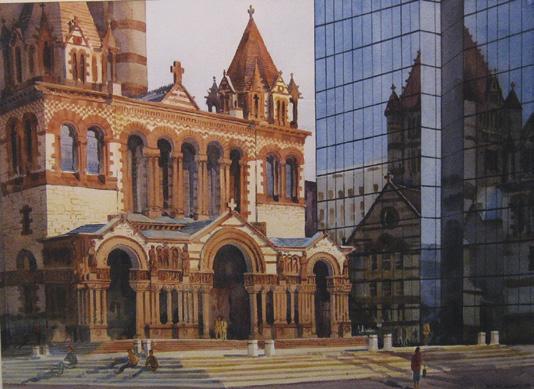
Harvard Art Museums
32 Quincy St., Cambridge, MA (617) 495-9400
harvardartmuseums.org
Opening March 1: LaToya M. Hobbs: It’s Time Immerse yourself in a day in the life of contemporary artist, LaToya M. Hobbs, through a tour de force of monumental printmaking. See how Hobbs shares the labor and intimacy of her private life in these prints, centering the negotiations she brokers daily to balance her manifold responsibilities—as a wife, mother, educator, and artist. Opening March 1: Future Minded: New Works in the Collection. Examine the museums’ recent acquisitions, spanning centuries and media. The works are by roughly 30 artists, including Jean (Hans) Arp, Edward Mitchell Bannister,
72 Art New England | March/April 2024
Sandra Matthews, Amira and Nancy in 1989; Amira and Samari in 2008, 2008. At Danforth Art Museum.
Lorraine O’Grady (American, born 1934), Family Portrait 1 (Formal, Composed), 2020, Fujiflex print, 60 x 48" (152.4 × 121.9 cm). Edition of 10 plus 3 artist’s proofs. © Lorraine O’Grady/Artists Rights Society (ARS), New York . At the Davis Museum at Wellesley College.
Frederick Kubitz, Reflections—Trinity Church, watercolor, 22 x 30". At The Guild of Boston Artists.
Bonny Leibowitz, Small Shifts and Massive Alterations, 2018, wax, pigment, and ink on Masa paper, 86 x 73". At Concord Art.
Willie Cole, Pietro Damini, Svenja Deininger, Jeffrey Gibson, Baldwin Lee, Ana Mendieta, Lucia Moholy, Toyin Ojih Odutola, Noriko Saito -, Melissa Shook, Jane Yang-D’Haene, and many others.
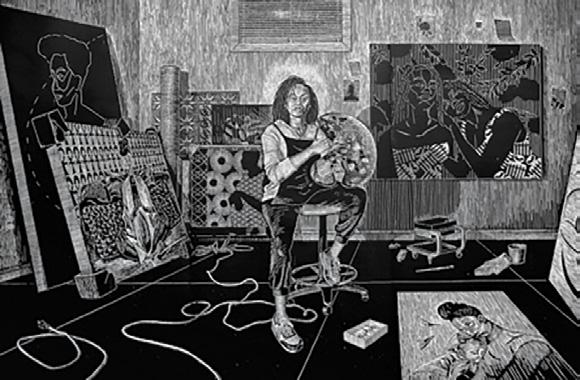
LaToya M. Hobbs, Scene 5: The Studio, from Carving Out Time, 2020–21, woodcut
cotton paper. Harvard Art Museums/Fogg Museum, Margaret Fisher Fund, 2022.224.5. © LaToya M. Hobbs. Photo: Ariston Jacks; courtesy of the artist. At Harvard Art Museums.

Noriko Saitō, Japanese, Sunbeam, 2002, ink and color on paper; drypoint with aquatint. Harvard Art Museums/Arthur M. Sackler Museum, Purchase through the generosity of the David L. Klein, Jr. Foundation in memory of Sylvan Barnet and William Burto, 2018.200. © Noriko Saitō. At Harvard Art Museums.
Inner Space Fine Arts
189 Main St., North Reading, MA (978) 223-8438
innerspace.finearts@gmail.com
innerspace-fineart.com
Th & F 1–6, Sa & Su 12–4
Opening May 4: Juni Van Dyke: Color is one of my favorite things. A Cape Ann treasure, Juni’s colorist paintings are informed by the area’s natural beauty; the light sweeping across granite; coastal views; hillside vistas—Cape Ann is an ever-present force in her work. Using abstract forms, Juni invites the viewer to experience her work without interruption of title. Energized by the interaction, she finds the varied interpretations fascinating and exciting—valid without exception. Artist reception: Saturday, May 4, 5–7 p.m.
Kingston Gallery
450 Harrison Ave., No. 43, Boston, MA (617) 423-4113
info@kingstongallery.com
W–Su 12–5 or by appointment
Through March 31: Mira Cantor, DIG, and Phyllis Ewen, My Mind’s Eye. Cantor’s paintings are influenced by the subterranean landscapes of The Burren in Ireland and others. Reception: Friday, March 1, 5–8 p.m. April 3–28: Kingston
Associates exhibition: Everything Leaves a Mark Reception: Friday, April 5, 5–8 p.m.
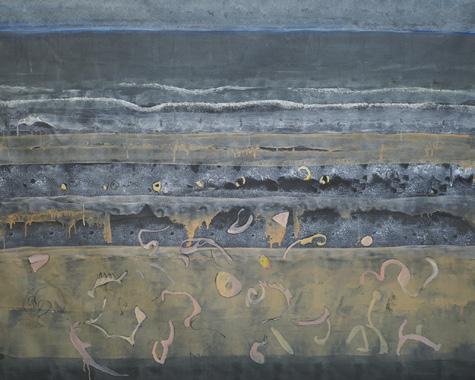

Krakow Witkin Gallery
10 Newbury St., Boston, MA (617) 262-4490
info@krakowwitkingallery.com krakowwitkingallery.com
Tu–Sa 10–5:30
March 2–April 10: Kiki Smith: Sometimes; Janet Passehl: Here Is Why.

(151.8 x 108.6 cm). At Krakow Witkin Gallery.
Milton Academy
Nesto Gallery, Art & Media Center Arts Commons Gallery, Kellner Performing Arts Center 170 Centre St., Milton, MA (617) 898-1798
milton.edu/arts/nesto-gallery
M–F 9–4
Through April 25: Class of 2009 Alumni Exhibit. Artists: David Bruce ’09, Sarah Diamond ’09, Dougan Khim ’09, Jasmine Reid ’09. Opening reception: Thursday, April 25, 5:30–7 p.m. This exhibit features four graduate artists who have continued to make paintings professionally, showing work from the classical, post-modern, and contemporary traditions.
MIT List Visual Arts Center
20 Ames St., Cambridge, MA (617) 253-4680
listinfo@mit.edu listart.mit.edu
Tu 12–6, W 12–7, Th 12–7, F 12–6, Sa & Su 12–6
Through March 10: Carlos Reyes: 18. Opening March 7: List Projects 29: Brittni Ann Harvey and Harry Gould Harvey IV. Opening April 4: Hana Mileti´c: Soft Services. Opening April 4: Basel Abbas and Ruanne Abou-Rahme: Only sounds that tremble through us. The List Center galleries and programs are always free and open to the public. Visit listart.mit.edu for programming and exhibition updates along with their most up-to-date visitor information.

Hana Miletić, Materials, 2021–22, handwoven and hand-knit textile (pale blue repurposed mercerised cotton, recycled nylon, repurposed plastic, rose pink organic raw wool, variegated blue organic silk and white gauze yarn), 7½ × 8¼× 13/16". Courtesy the artist and The Approach, London. Photo: GRAYSC. At MIT List Visual Art Center.
ShowUp (formerly Beacon Gallery) 524B Harrison Ave., Boston, MA contact@showupinc.org showupinc.org
Th, F & Sa 12–5, Su 11–4 & by appointment March 1–April 28: Extra, featuring Rixy, Ja’Hari Ortega, and Wavy Wednesday. This exhibit transforms the gallery into a safe space for Black and Brown women to be themselves, embrace their strengths, and transcend white supremacy and patriarchy. Curated by Chenoa Baker, the artists use their creative expression to address societal barriers in their work. Event details online.
Three Stones Gallery
32 Main St., Concord, MA (978) 379-1333
info@threestonesgallery.com threestonesgallery.com
M 12–5, Tu–F 10–6, Sa & Su 10–5
Through March 24: Contained and Unbound: Vessel paintings by Judy Bramhall; pastels by Cindy Crimmin; photographs of Norway by Ellen Harasimowicz. March 27–May 5: Chiaroscuro: Coastal watercolors by Jillian Demeri; mixed media portraiture by Cynthia Brody; acrylic landscapes and florals by Avery Schuster Bramhall. New works by represented artists. Reception: Saturday, April 6, 6–8 p.m.
March/April 2024 | Art New England 73
on
Mira Cantor, Listen, 2023, acrylic on canvas, 42 x 52". At Kingston Gallery.
Stacey Cushner, Towards a Blue Planet No. 2, 2023, color pencil on wood, 11 x 14". At Kingston Gallery.
Kiki Smith, Evening Star, 2023, aqueous archival inkjet, acrylic archival inkjet, white gold leaf on Hahnemüle rag paper, 59¾ x 42¾"
Exhibitions
Openings and Events Around the Region

At Three Stones Gallery.
The Umbrella Arts Center
40 Stow St., Concord, MA (978) 371-0820
theumbrellaarts.org
Through March 24: Portraits in Red: Missing & Murdered Indigenous People Painting Project, by Nayana LaFond. Reception and artist talk:
Thursday, March 7, 5–7 p.m. March 16 & 17: The Umbrella Open Studios, including Kaleidoscope: Changing as We Change exhibition, on view through March 20. March 29–April 5: Artrageous Art Auction and Exhibition. Opening April 10: TAPPED IN: Moving Hearts and Minds through Art and Science, curated by Stephanie Marlin-Curiel and Dr. Linda Booth Sweeney. Reception and panel discussion: Thursday, April 11, 5:30–8:30 p.m.
Walden Pond State Reservation Gallery
915 Walden St., Concord, MA (978) 369-3254
pcrottyart@gmail.com
patriciacrotty.com
Daily 10–3
Through April 30: Sky Water: Reflections on Walden Pond. The colorful abstract paintings and collages of local artist Patricia Crotty are inspired by the connection with nature that Walden Pond provides visitors. They celebrate the beauty of nature in all of its forms and seasons. Co-sponsored by Friends of Walden Pond. The exhibit is free; parking fees apply.

Central & Western Massachusetts
Iris and B. Gerald Cantor Art Gallery, College of the Holy Cross
Prior Performing Arts Center
1 College St., Worcester, MA (508) 793-3356
holycross.edu/cantorartgallery
M by appt, T–F 10–5, Sa 12–5
Through April 9: Sneha Shrestha: Ritual and Devotion. Nepali-born, Boston-based painter Shrestha interprets acts of ritual and devotion and what they can come to mean through themes of home, identity, and legacy.

Fitchburg Art Museum
185 Elm St., Fitchburg, MA (978) 345-4207
info@fitchburgartmuseum.org fitchburgartmuseum.org
W–F 12–4, Sa & Su 11–5
First Thursdays 12–7
Ongoing: On Her Terms: Feminine Power Embodied features New England artists who foreground the human body in their work to engage contemporary issues around women’s rights. Also on view: Ria Brodell: Butch Heroes and Portrayed by Eakins: Ella Crowell as Model and Student. Opening March 2: Africa Rising: 21st Century African Photography, including photographs by Zanele Muholi, Lalla Essaydi, and Aida Muluneh, and others.

Maria Yolanda Liebana, The World according to April 26th, 2023, acrylic, molding paste, and mixed media collage on wood panel. Courtesy of the artist. At Fitchburg Museum of Art.
New England Visionary Artists Museum
518 Pleasant St., Northampton, MA (413) 588-4337
neva-museum.org
Tu-Sa 1-6
March 8-30: Sasha Statman-Weil presents ‘Sonhood,’ work from three artists: a mother, a father, and a son. California artist Ron Weil’s (1944–2019) black charcoal abstractions are presented alongside Leah Statman’s (1954–2011) vibrant portrait quilts juxtaposed with their son’s films and poetry. The show investigates Statman-Weil’s artistic inheritances beyond his parent’s actual creations. Reception: Friday, March 8, 5-8 p.m. Plus, four hundred artworks are on display in five additional showrooms.
Norman Rockwell Museum
9 Glendale Rd./Rte. 183, Stockbridge, MA (413) 298-4100
NRM.org
Sa & Su 10–5; M, Tu, Th, F 10–4; closed W Home of American Illustration, featuring new exhibitions: Between Worlds: The Art & Design of Leo Leonni, a first-ever U.S. retrospective on the illustrator (Frederick, Cornelius, Pezzettino +) and graphic designer; and Mystery & Wonder: Highlights from the Illustration Collection. Plus Rockwell’s 323 Post Covers. New guided gallery tours by reservation. Museum Store (and online store). Save with online tickets. More at NRM.org.

Leo Lionni (1910–1999), cover illustration for Frederick, 1967 (Knopf), mixed media collage. BDC Rex Rotary M-4, n.d., Brochure for BDC (Bond Duplicator Company, New York, New York). © Leo Lionni. All rights reserved. Courtesy of the Lionni Family. At Norman Rockwell Museum.
74 Art New England | March/April 2024
Patricia Crotty, Blue Water, 2021, oil on canvas, 24 x 18". At Walden Pond State Reservation Gallery.
Sneha Shrestha, Worlds Apart (left), 2023, acrylic on canvas, 30 x 40". At Iris and B. Gerald Cantor Art Gallery.
Cynthia Brody, GenZ Warrior, mixed media oils, collage and bike parts on linen, 30 x 24".
Paradise City Arts Festival
Royal Plaza Trade Center
181 Boston Post Rd. West, Marlborough, MA (800) 511-9725
info@paradisecityarts.com paradisecityarts.com
F 10–5, Sa 10–6, Su 11–5
March 22–24: Paradise City Arts hosts New England’s premier and most celebrated shows of contemporary fine and decorative art. This MetroWest Boston event draws thousands of collectors, designers, and art enthusiasts seeking to connect with 170 curated exhibitors from across the country. It’s the go-to destination for imaginative home decor, fine art and sculpture, handcrafted fashion, jewelry, and gifts that transcend expectations. With music in the air, two cafes, and the themed exhibit Fresh Greens!, it’s not to be missed.

Springfield Museums
21 Edwards St., Springfield, MA springfieldmuseums.org
Tu–Sa 10–5, Su 11–5
One admission: five museums and the Dr. Seuss National Memorial Sculpture Park. Through March 24: A Gathering: Works from Contemporary Black American Ceramic Artists. Through May 5: The Outwin 2022: American Portraiture Today. Opening April 27: Look Again: Portraits of Daring Women by Julie Lapping Rivera. Ongoing in the Dr. Seuss Museum: Original art by Theodor Seuss Geisel, aka Dr. Seuss.
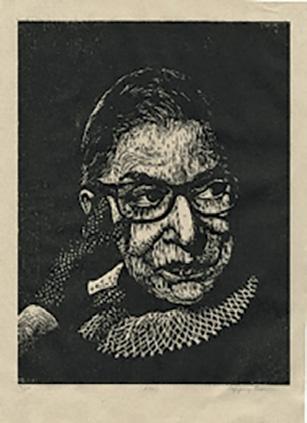
UMass University Museum of Contemporary Art
151 Presidents Dr., Amherst, MA (413) 545-1986
fac.umass.edu/umca
Tu–F 11–4:30, Sa & Su 12–4, First Thursday 11–8 Through May 10 (and fall 2024): BREACH:
LOGBOOK 24 | STACCATO by Shinnecock artist
Courtney M. Leonard features paintings, sculptures, and video exploring the life and kinship ties of Staccato, a North Atlantic right whale killed by a ship strike in 1999. Leonard explores marine biology, Indigenous food sovereignty, migration, and human environmental impact. March 27–May 10: FAINT/HIDDEN/SHROUDED: Contemplating Obscurity, a graduate curatorial exhibition. Free and open to the public.

Rib bone of Staccato, North Atlantic right whale (Eubalaena glacialis), UMass Natural History Collections. Photograph by Stephen Petegorsky. At the UMass University Museum of Contemporary Art.
Williams College Museum of Art
15 Lawrence Hall Dr., Williamstown, MA (413) 597-2429
wcma@williams.edu artmuseum.williams.edu
Tu–Su 10–5
Ongoing: Combining historical materials and the perspectives of seven contemporary Black artists, Emancipation: The Unfinished Project of Liberation visualizes what freedom and the enduring legacy of emancipation look like today and beyond. March 7: Dr. Frances Jones-Sneed will discuss “What does emancipation mean in the Berkshires?”

Worcester Art Museum
55 Salisbury St., Worcester, MA (508) 799-4406
worcesterart.org
W–Su 10–4
Through March 17: Faith Ringgold: Freedom to Say What I Please—Deeply personal, celebratory of African American culture, and rooted in political activism, explore the art and storytelling of Faith Ringgold. Opening April 6: New Terrain: 21st-Century Landscape Photography—Discover how artists are using different photographic processes to explore the idea of landscape.
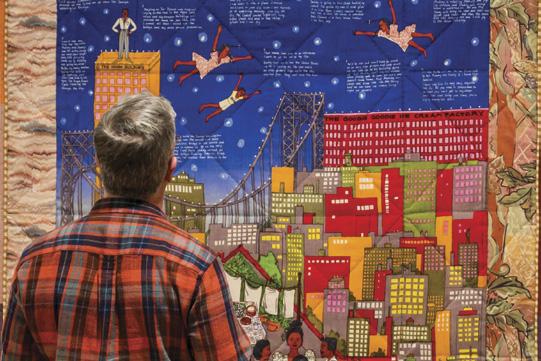
North of Boston
Hammond Castle Museum
80 Hesperus Ave., Gloucester, MA (978) 283-2080
info@hammondcastle.org
hammondcastle.org
April 5–28: Su–Sa 10–4
The Gertrude Cawein at Hammond Castle Museum exhibition will feature nearly sixty works by American artist Eric Pape (1870–1938) spanning his entire career. The catalog, most of which is on loan by Pape collector and biographer, Dr. Gregory Conn, presents a rare example of his work as a society portraitist and includes examples of Pape’s celebrity portraits created during the Great Depression not publicly displayed since his death.
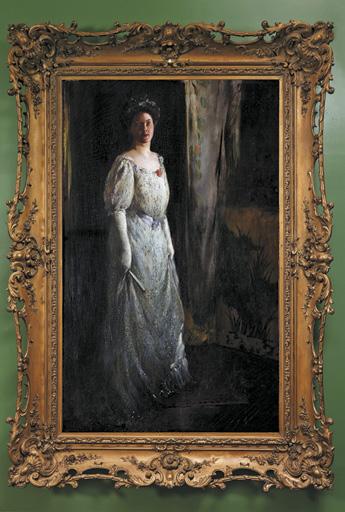
Montserrat Galleries
Montserrat College of Art
23 Essex St., Beverly, MA (978) 921-4242
montserrat.edu/galleries
Through March 6 in the Montserrat Gallery: Karmimadeebora McMillan, Wondering stars…for whom it is reserved…the blackness..the darkness.. forever. Through March 16 in the Carol Schlosberg Galleries: Loretta Park, About to Thaw. Opening March 27 in all galleries: Senior Thesis Exhibitions.
March/April 2024 | Art New England 75
Kate Gakenheimer, Crazy Days, glass. At Paradise City Arts.
Julie Lapping Rivera, Ruth Bader Ginsberg, woodcut, 2021. Collection of the artist. At Springfield Museums.
John Quincy Adams Ward, The Freedman, 1863. At Williams College Museum of Art.
Faith Ringgold, Tar Beach #2, 1990, silkscreen on silk, 1st edition, ed. 1. © Faith Ringgold/Artists Rights Society (ARS), New York, Courtesy ACA Galleries, New York. At Worcester Art Museum.
Gertrude Cawein, 1907, oil on canvas, 75 x 52" framed. At Hammond Castle Museum.
Exhibitions
Openings and Events Around the Region
South of Boston
Art Complex Museum
189 Alden St., Duxbury, MA (781) 934-6634
artcomplex.org
W–Su 1–4
Through May 5: Zach Horn: Saturdays. Opening April 28: National Association of Women Artists Massachusetts (NAWAMA) Chapter: Where Do We Come From? What Are We? Where Are We Going? Opening April 28: Cassatt and Beyond: Women Printmakers. Opening May 12: DIG, Joe Caruso, Jennifer Liston Munson, Christine Palamidessi and Marsha Odabashian. Reception: Sunday, May 12, 1–4 p.m. Ongoing: Nora Valdez: Passage. Admission is always free.

Jennifer
Cahoon Museum of American Art 4676 Falmouth Rd., Cotuit, MA (508) 428-7581
cahoonmuseum.org
Beginning March 13: W–Su 10–4
Opening March 13: Bold Women and Vivid
Dreams: Sarah Peters and Don Nakamura features ceramic sculptures and drawings celebrating the human figure by Sarah Peters and Don Nakamura. Peters explores the intricacy of the human body, while Nakamura’s works are a freewheeling channeling of his inner spirit. Highlights include Peters’ Wondergrrrl series of teapots and ceramic sculptures by Nakamura.

Fuller Craft Museum
455 Oak St., Brockton, MA fullercraft.org
Tu–Su 10–5
All are welcome, completely free of charge
Through March 31: Face Value: Portraits from the Arthur S. Goldberg Collection. Ongoing: Maria Molteni: Soft Score. Ongoing: Pop! Color Stories from the Permanent Collection. Ongoing: The Red Dress. Opening March 30: Beau McCall: Buttons On! Opening April 13: Hand in Hand: Works from the Fleur S. Bresler Collection. Fuller Craft Museum’s wide-ranging exhibitions and outdoor sculpture showcase the finest contemporary craft in a spectacular organic modernist building and woodland setting.

New Bedford Whaling Museum
18 Johnny Cake Hill, New Bedford, MA (508) 997-0046
whalingmuseum.org
T–Sa 9–4, Su 11–4
Through May 5: Framing the Domestic Sea: Photographs by Jeffery Becton evokes New England’s varied histories, the maritime world, and the impacts of climate change on coastal communities. Through April 21: Paintings by Roy Rossow picture New Bedford’s working waterfront, contemporary maritime activities, and historic celestial navigation in The Stars that Guide Us.

South Shore Art Center
119 Ripley Rd., Cohasset, MA (781) 383-2787
info@ssac.org
M–Sa 10–4
Bancroft Gallery, April 4–May 18: Out of Darkness, a national show juried by Marjorie Kaye, founder and director emeritus, Galatea Fine Art. Opening reception: Thursday, April 4, 6
p.m. Opening May 30: Young Black Woman | Old White Man, curated by James Burke featuring works by James Burke and Devyn Case. Opening reception: Thursday, May 30, 6 p.m.
New Hampshire
Alva de Mars Megan Chapel Art Center
100 Saint Anselm Dr., Manchester, NH (603) 641-7470
chapelartcenter@anselm.edu
Anselm.edu/chapelart
Tu–W 10–4, Th 10–7, F 10–4 (Gallery open only during scheduled exhibitions)
The Chapel Art Center features special exhibitions and houses a permanent collection of over 400 objects. March 7–April 19: The Intimacy of Seeing: Elsa Voelcker—A Retrospective, celebrates Voelcker’s long career as a photographer and member of the Fine Arts Department at Saint Anselm College. Voelcker has specialized in various photographic methods, including photograms, gelatin silver prints and, more recently, digital. Opening reception with the artist: Friday, March 22, 4–6 p.m. Free and open to the public.

AVA Gallery and Art Center
11 Bank St., Lebanon, NH (603) 448-3117
info@avagallery.org
avagallery.org
Tu–Sa 11–5
Through March 30: Alternative Processes in Contemporary Photography: Linda Bryan, Cathy Cone, Chris Esten, Rachel Portesi, Vaune Trachtman, Mary Zompetti; Milkweed: Louise Hamlin; A Matter of Time: Justin O’Rourke. Opening March 8: Form + Texture: A group exhibition of contemporary fiber art. April 12–27: Illumination: AVA’s Annual Benefit Exhibition
76 Art New England | March/April 2024
The Red Dress worn by artisan Freya Lusher. Photo: Sophia Schorr-Kon. At Fuller Craft Museum.
Jeffery C. Becton (American; b. 1947), Waking Up, 2021, photomontage on aluminum, 20 x 34", image courtesy of the artist. At New Bedford Whaling Museum.
Nancy, 2002, gelatin silver print, 12 x 10". Image courtesy of the artist. At Alva de Mars Megan Chapel Art Center.
Jean Okumura, Where are we going?, oil on canvas. At Art Complex Museum.
Sarah Peterson, Wondergrrrl Teapot, 2023, cast terracotta, underglazes, glazes. At Cahoon Museum of Art.

Nancy Sepe, Tied to the Rails, wood, silk and other fabric, metal, wire, plastic, paint. At AVA Gallery and Art Center.
Currier Museum of Art
150 Ash St., Manchester, NH (603) 669-6144
visitor@currier.org
currier.org
W, Th, F, Sa, Su 10–5
The Currier Museum features paintings, sculpture, decorative arts, and photographs, including works by Monet, Picasso, O’Keeffe, Hopper, and Wyeth. The museum also owns two Frank Lloyd Wright designed homes available to view by tour (tour season runs April through December yearly). Through March 31: Toward the New: A Journey into Abstraction. Through May 27: Kara Walker: Harper’s Pictorial History of the Civil War (Annotated). Opening March 7: I live a journey of a thousand years: Raphaël Barontini. Opening April 12: Filippo de Pisis and Robert Mapplethorpe: A Distant Conversation

Kara Walker, Confederate Prisoners Being Conducted from Jonesborough to Atlanta. From Harper’s Pictorial History of the Civil War (Annotated), 2005, offset lithography and silkscreen on paper, 39 x 53", © Kara Walker, courtesy of Sikkema Jenkins & Co. and Sprüth Magers. At Currier Museum of Art.
Hood Museum of Art, Dartmouth
6 East Wheelock St., Hanover, NH hood.museum@dartmouth.edu hoodmuseum.dartmouth.edu
W 11–5, Th–F 11–8, Sa & Su 10–5
Free and open to all
Through April 13: And I’m Feeling Good: Relaxation and Resistance features selections from the Hood Museum’s photography collection that celebrate joy in African American life. Simultaneously, it considers the pleasures and challenges in achieving and maintaining that “good feeling” in the United
States. Outgoing Gilded: Contemporary Artists
Explore Value and Worth, a traveling exhibition from the Weatherspoon Art Museum at UNC Greensboro, features artists turning to the ancient practice of gilding as a means to reconsider our modern value systems.
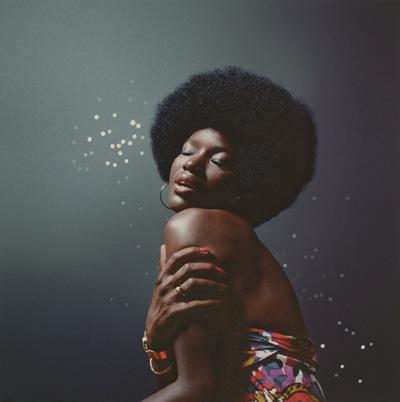
Kwame Brathwaite, Changing Times, 1973 (printed 2021), archival pigment
Hood Museum of Art, Dartmouth: Purchased through the Contemporary Art Fund and the Sondra and Charles Gilman Jr., Foundation Fund; 2023.1.3. © Kwame Brathwaite. At Hood Museum of Art.

Lamont Gallery
Phillips Exeter Academy
11 Tan Ln., Exeter, NH (603) 777-3461
gallery@exeter.edu exeter.edu/lamontgallery Reservations required
March 19–April 13: Hidden Treasures 6 celebrates the creative work of Phillips Exeter Academy colleagues across media and departments. This year's exhibition includes fiber arts, stained glass, painting, and landscape photography as well as events and programs showcasing music and literary arts. Opening reception: Thursday, March 28, 5–7 p.m.
WREN Gallery
2011 Main St., Bethlehem, NH (603) 869-9736
hello@wrenworks.org
M–Sa 10–5, Su 11–4
March 9–April 12: Total Eclipse of the Art features work by Douglas Arion, emeritus professor and dark sky defender, dark sky photographs; and eclipse themed work from over twenty WREN members. Opening reception: Friday, March 9, 5 p.m. Snow date: Saturday, March 10, 5 p.m. Visit WREN to shop the work of over 120 local artists and makers. The
Gallery is located just a short distance from full totality of the Solar Eclipse on April 8, 2024.
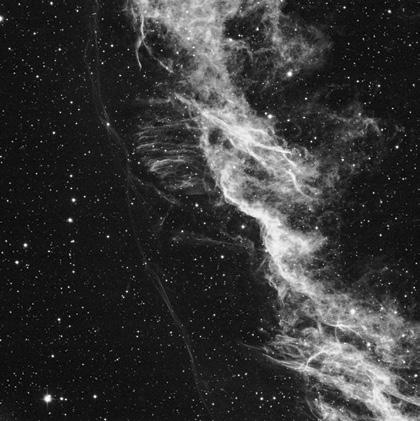
Bannister Gallery at Rhode Island College
600 Mt. Pleasant Ave., Providence, RI (401) 456-9765
bannistergallery@ric.edu
ric.edu/bannister
M–F 12–8 or by appointment
Through March 22: Range of Motion, Landscapes by Charles W. Goolsby. Goolsby’s landscape imagery builds on 19th century American landscape painting traditions and implies a sense of contemporary issues. April 1–19: Paper Trails: Selections from the RIC Print Trade. Since 2005, students and faculty of the Rhode Island College Printmaking Department have taken part in a print exchange. Selections curated by Sam Nehila.
Chazan Gallery at Wheeler
228 Angell St., Providence, RI (401) 528-2227
info@chazangallery.org
Through March 6: COLOURED.AESTHETICA
Solo show by Triton Mobley. Mobley is a new media artist and researcher whose interventionist works and guerrilla performances have been exhibited nationally and internationally. Mobley’s research and praxis cull together critical making methodologies across performative installations, programmable fabrications, and speculative industrial design—fashioning polemical art object assemblages that engender public reexamination.
Vermont
Brattleboro Museum & Art Center
10 Vernon St., Brattleboro, VT (802) 257-0124
brattleboromuseum.org
W–Su 10–4 (Closed March 10–15)
Through March 9: Aurora Robson: Human Nature Walk; Paper Made; Fawn Krieger and David B. Smith: Home Bodies; Michael Smoot: And To This World; Art Costa: Sounds Deep. Ongoing: Hannah Morris: Moveable Objects. Opening March 16: In Nature’s Grasp; John Newsom: Painting the Forest of
March/April 2024 | Art New England 77
print.
Angela Fraleigh, These things are your becoming, 2014, oil, 23k gold leaf, metal leaf, and galkyd on canvas, 67 x 90". Courtesy of the artist. © Angela Fraleigh, photo by Ken EK, courtesy of the artist. At Hood Museum of Art, Dartmouth.
Photo: Doug Arion. At The Gallery at WREN. Rhode Island
Exhibitions
Openings and Events Around the Region
the Happy Ever After; Edward Holland: Celestial Sea; Samira Abbassy: Out of Body; Francheska Alcántara: The Inner Order of the pppPoof and the fffPop.
Burlington City Arts
135 Church St., Burlington, VT (802) 865-7166
burlingtoncityarts.org
W–F 12–5, Sa 12–8
A contemporary art gallery with up to three floors of exhibition space, hosting new exhibitions every fall, winter/spring, and summer, on Burlington’s iconic Church Street Marketplace. Opening February 9: Here Now: Art and Migration, international and regional artists whose work explores concepts of borders, movement, and migration across local urban centers and global geographies; Margaret Jacobs: Kinship, steel sculptures and finely crafted jewelry, exploring the tensions and harmonies between the man-made and natural worlds. Free and open to the public.
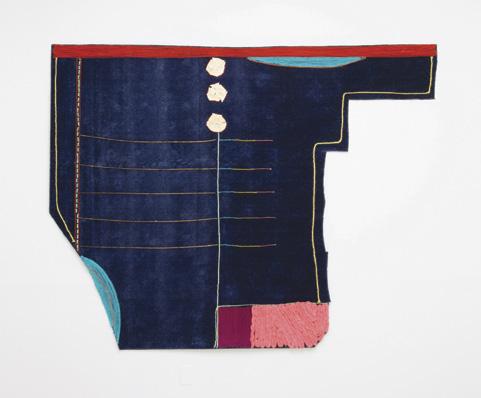
Teresa Baker, Low Pitched, 2023, beads, yarn, willow, buckskin, artificial sinew on artificial turn, 78 x 93.5". At Burlington City Arts.
The Current
90 Pond St., Stowe, VT (802) 253-8358
thecurrentnow.org
Through April 11: In the Garden, a platform for artists, poets, and performers. Within the walls of The Current, artists present a disparate array of topics through work that uses the garden as a motif, setting the stage for connection and cultivation. Artists in this exhibition use the metaphor of a garden to address climate change, decolonization, feminism, societal tensions, and our endangered environment. Artists include: Carlos Amorales, Cameron Davis, Wylie Garcia, Valerie Hammond, Mary Mattingly, Ebony G. Patterson, Paul Anthony Smith.

Ebony G. Patterson, …there is a rumble as the garden folds, rolls, shreds, devours…itself, 2021–22, digital print on archival watercolor paper with hand-cut and torn elements, construction paper, plastic, feathers mounted on artist designed wallpaper. Image courtesy of the artist, Monique Meloche Gallery and Hales Gallery. At The Current.
Long River Gallery
49 S Main St., White River Junction, VT (802) 295-4567
art@longrivergallery.com
longrivergallery.com
W–Sa 11–5
Nestled in the heart of White River Junction, Long River Gallery features the art and craft of over eighty local artists from Vermont and New Hampshire. Through May 1: Artist Prue Merton displays her work from a selection of collages of decorated papers that suggest surprising perspectives using color and pattern. Opening reception: Friday, March 1, 5–7 p.m.
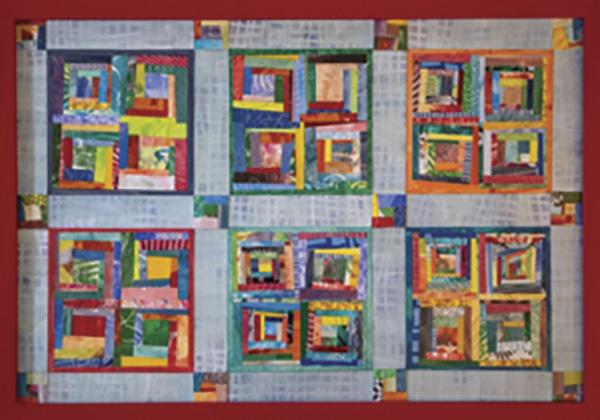
Mad River Valley Arts
5031 Main St., #2 Village Square, Waitsfield, VT (802) 496-6682
info@madrivervalleyarts.org
Tu–Sa 1–5
March 7–April 26: RISE: Trees; Our Botanical Giants features twenty artists paying homage to the “tree” in the creative process. Artists salute to their relationship with wood materials reclaimed or formally crafted and in doing so push the conversation between man-made and nature into one of collaborative celebration. Discussion: Thursday, April 18, 5 p.m. with Shelby Perry, Wildlands Ecologist with Northeast Wilderness Trust. Free and open to the public.
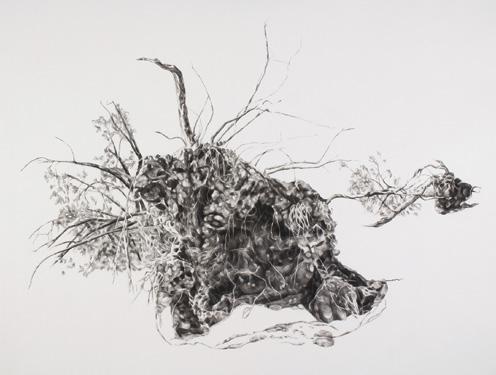
Studio Place Arts
201 N Main St., Barre, VT (802) 479-7069
studioplacearts.com
W–F 11:30–5, Sa 11:30–4
March 13–April 20: Main Gallery: Up and Down, In and Out: Embroidery and its Kin. Second floor gallery: Hiding in Plain Sight by Amy Schachter. Third floor gallery: The Grand Assemblage by Axel Stohlberg. Visit studioplacearts.com for info on the Quick Change Gallery and SPA annex locations. Studio Place Arts is a working art center with art exhibits, artist studios, classroom, and a sculpture tour.
Vermont Artisan Designs
106 Main St., Brattleboro, VT (802) 246-7245
vtart.com
Daily 10–5
Fine art and contemporary American craft. March 1–April 3: Oil paintings of landscapes around Northern New England by Stefan Pastuhov and Gary Shepard. April 5–May 2: Paintings in oil and pastel of New England by Kate Beetle and abstract paintings by colorist E. Joseph McCarthy.
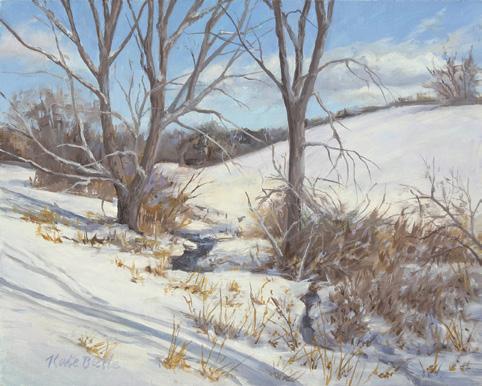
78 Art New England | March/April 2024
Prue Merton, Untitled, (framed), paper collage, 26.75 x 18.75". At Long River Gallery.
Julie Comnick, Uproot III, 2021, charcoal on paper, 36 x 46". At Mad River Valley Arts.
Kate Beetle, Two Trees, Winter, oil on linen/panel. At Vermont Artisan Designs.
Advertise
RATES
One (1) insertion: $2.75 per word;
two (2) to three (3) insertions: $2.50 per word; four (4) to six (6) insertions: $2.25 per word.
Twenty (20)-word minimum. Deadline: March 29, 2024 for the May/June 2024 issue.
Email:
advertising@artnewengland.com
Classified ads are also posted on artnewengland.com
Career Services
SALON SERIES
with Suzanne Schultz of Canvas Fine Arts and Rita Fucillo of Art New England magazine
Summer Sessions Begin in June!
Drop-in rates available.
This Salon Series is designed for Artists, Authors, Makers, and Entrepreneurs of all Levels Register at Eventbrite
Questions: Contact Suzanne Schultz at 617.470.1889 suzanne@canvasfinearts.com rita@artnewengland.com
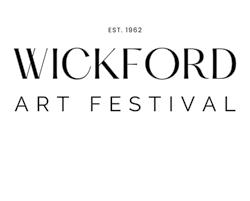
July 13 & 14
Wilson Park Wickford, RI Juried Fine Art Applications Open January 15–April 15 wickfordart.org
The City of Concord and the Greater Concord Chamber of Commerce announce the Sixth Annual Outdoor Sculpture Exhibit in historic downtown Concord, NH. This exhibition is open to professional sculptors 18 years or older. Entry deadline: April 26, 2024. No submission fee: $500 stipend for accepted entries. For online application, visit concordnhchamber.com/arts.
For more information contact Tim Sink, tsink@concordnhchamber.com.
Creative Services
Critique/Mentoring sessions available. Constructive, tangible feedback and support for artists working in any medium. Call Robert Siegelman at (617) 524-7737, or robert.siegelman@gmail.com.
Books/Publications
YOUR ART. YOUR BOOK.
We write & publish. Feature your art and your story. Give readers insight into your creative process. Use your books in marketing & promotion. As a published author, earn royalties on book sales. Affordable, personalized services.
Complimentary consultation. LegaciesandMemoriesPublishing.com BizSuccessBooks.com (904) 293-9893 • Since 1999
Creative Services
ART NEW ENGLAND CREATIVE SERVICES
Offering artist and writer coaching, arts consulting, custom publishing, web design, digital production, portfolio reviews, workshops.
Contact Rita Fucillo at rita@artnewengland.com or 857-366-8131
RT WOODS ART
Offering conservation and installation services, consulting and design, art show curating, custom framing and artist consulting. We transform spaces through temporary art exhibitions, and acquired collections, for residential, non-profit and corporate clients. rtwoodsarts@gmail.com
Art New England’s semi-annual Artist Directory is the most cost-effective way to expose your work to readers who care about art. It’s the best small investment you can make for your career.
Featured in the September/October 2024 issue. Space reservation deadline: July 19, 2024
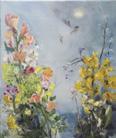


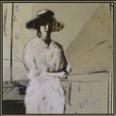






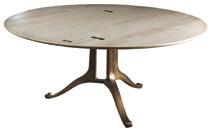
Be seen by more than 30,000 readers—and countless more online.
EXPOSE YOURSELF!
Classifieds
44 New England March/April DIRECTORY SPRING 2023 Artist PetreaNoyes petienoyes@aol.com petreanoyes.com The mixedmedia canvas, 40 ClaireMarcus FreshPaintArtistsCulturalCenter CapeCodStudios307OldMainSt.,S.Yarmouth,MA (508)294-9946 clairemarcus@yahoo.com clairemarcus.com freshpaintartists.com Windblown watercolor. BobbieBush BostonPortraitArtist 271WesternAve.,#112,Lynn,MA (978)744-6918 bobbie@bobbiebush.com BostonPortraitArtist.com Specializingincommissionedportrait paintingsofyourlovedones Portrait Dimitri mixed painting, x20". JanisH.Sanders 122Studio228, WesternAve.Studios (978)WesternAve.,Lowell,MA 535-1242 info@janissanders.com janissanders.com DancingWaters 2022,oil/panel,cocoapainted galleryedge,24 24 1½". AnitaLoomis LoomisGallery 121DennettRd.,Kittery,ME (207)703-8866 anita@anitaloomis.com anitaloomis.com Family 2018,oiloncanvas,60 JoanneTarlinHarpswell,ME (508)542-2115 joannetarlin@gmail.com joannetarlin.com HumanitarianCorridor March/April 2023 New 45 2023 Artist LenoreTenenblatt 249 St.,Studio#13,Boston,MA(617)513-5718 tenenblatt@yahoo.com lenoretenenblattstudio.com Wood,Turquoise,andCoral 2022, monotype, 30". JEFFSODERBERGHSUSTAINABLEFURNISHINGS FINE (508)WestMainSt.,Wellfleet,MA 214-0538 gallery@jeffsoderbergh.com Seewebsite ourRIstudio gallerylocation jeffsoderbergh.com Leftto PaulMeneses TurningPoint Cor-tensteel, 77½x 30". DuncanJohnson JustYesterday reclaimedpaintedwoodfromVT,nails,geometriccomposition,36x38".JeffSoderbergh Contessa patchwork bonemaple bronzebase—customsizes finishes available,62 30". ALLartistwork availablethroughJEFFSODERBERGHgalleries. WilliamGotha WilliamGothaStudio&Gallery (617)320-5963 bill@williamgotha.com williamgotha.com NewEnglandLandscapesandSeascapes Sunlight Thunder 2022, linen, 36". Call for Entries
March/April 2024 | Art New England 79
Out and About in New England
1. On January 21, 2024, at the opening celebration for (Re)Work It! Women Artists on Women’s Labor, Dalia Ramanauskas: As We Embark, and Sea Change | See Change at the Mattatuck Museum in Waterbury, CT. Chief curator Keffie Feldman addresses a full room in the (Re)Work It! exhibit. Photo: Nick Colabella.
2. On January 28, 2024, at the second annual Flinn Gallery Legacy Lecture
the Greenwich Library’s Berkley
CT.
3. On February 3, 2024, at the opening reception for the international show Affirmation of Life, Art from Today’s Ukraine at the Loading Dock Gallery in Lowell, MA.

4. On February 8, 2024, at the grand reopening and the Artwalk reception for David Andrews’ solo show Perceptions and Perspectives at 50 Arrow Gallery in Easthampton, MA.
On February 2,
Friday




80 Art New England | March/April 2024
ART SEEN
at
Theater in Greenwich,
From left to right: Barbara Richards, past chair and Reeve’s Lecture Chair; Peggy E. Kalb, President of the Library Board of Trustees; and Blake Gopnik, lecture speaker on the topic of “Warhol: Icon and Enigma.” Photo: Karen Sheer.
From left to right: Nan Hockenbury and Suzanne Hodge, co-managers of the gallery; Nataliya Proskura, director of arts and exhibition curator for the Ukrainian Cultural Initiative (UCI); Vladislav Shapiro, president of UCI; and Sara Bogosian, director of Whistler House Museum.
Photo: Jack Curtis.
Photo: Jo Cater.
5.
2024, at the inaugural First
Celebrations with Melrose-based artist Ellen Rolli as special guest at Galaray House in Lexington, MA. Guests admire work by Boston-based artist McKenzie West.
Photo: Vikram Anantha.
1.
2.
5.
3.
4.
11th Annual
April 23 – May 5
12-Day Citywide Festival
Boston Design Week Awards
Friday Evening May 3rd
2024 Lifetime Achievement Award: Susan and Jim M-Geough, The M-Geough Company
• Internationally-known Speakers
• Architecture • Interior Design
• Special Events • Fashion
• Design Hackathon • Walking Tours
• Landscape Design • Preservation
• Makers • Handmade Design
• Social Impact Design
• Inclusive Design • Museums
Produced by:
Fusco & Four/Ventures, LLC
Sponsored by:



BostonDesignWeek.com
Photo courtesy of Winthrop Center
Save The Dates!

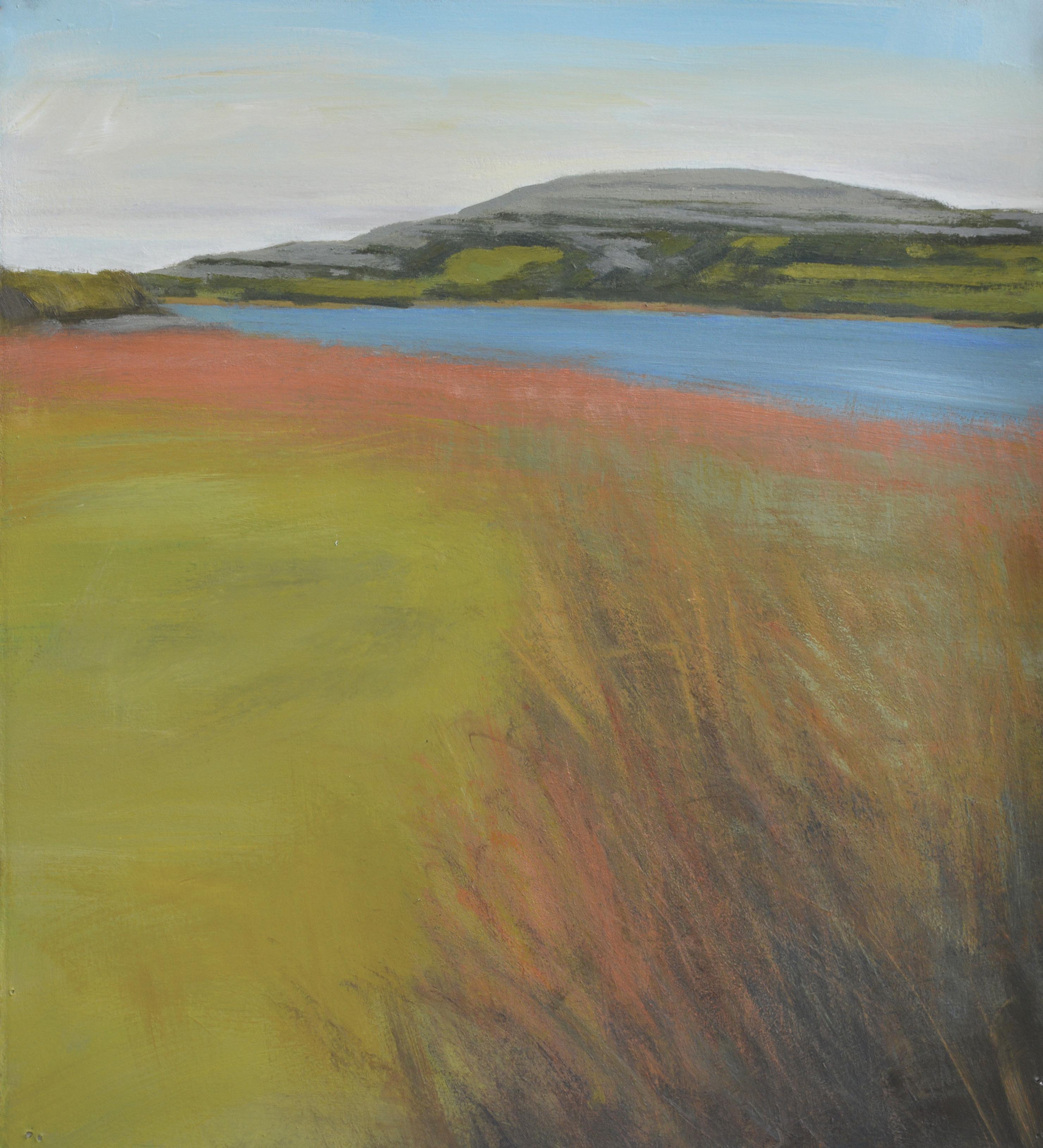



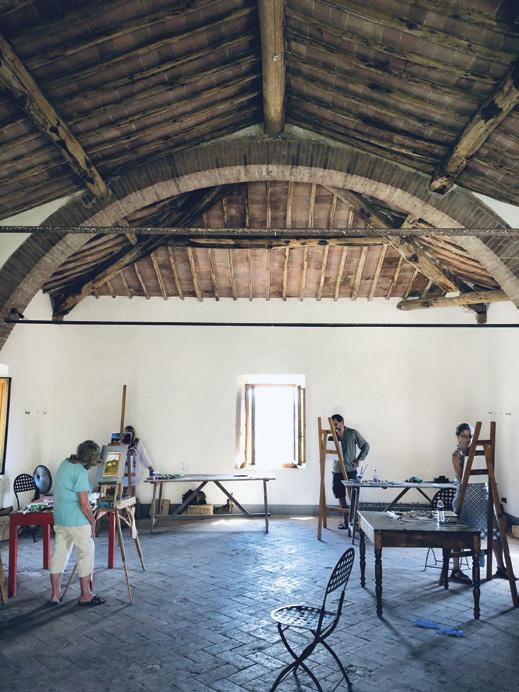
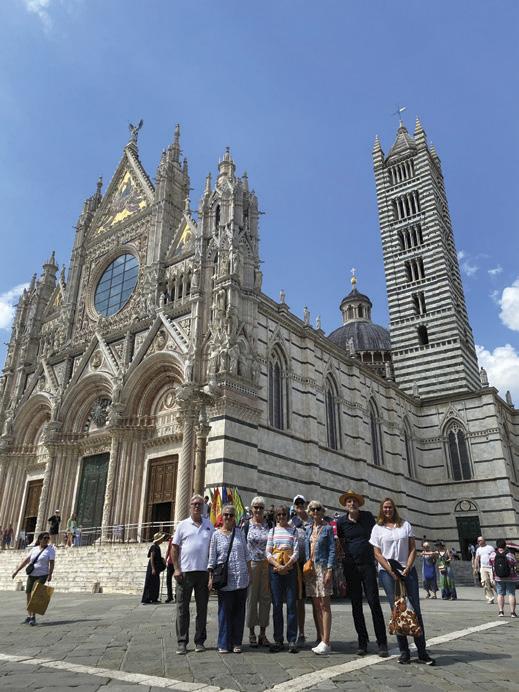





















 Rita A. Fucillo Publisher
Rita A. Fucillo Publisher


















 By Cynthia Close
By Cynthia Close


















































































































































































































































